South Vietnam; Domestic Landscapes and Emperor Bảo Đại, June 6th, 1951, Michel Nr. SVN 61-73, Block 1-5; At the end of World War II Vietnam the Allied victors decided at the July, 1945 Potsdam Conference to temporally divide Indochina at the 16th parallel. The Northern part of Vietnam was put under the administration of the Chinese represented by the Chinese Army under General Chiang Kai-Shek while the South was put under British administration. The primary task of both occupying armies was to take the surrender of the Japanese troops and to reestablish order in the country. Right after the war, there was initially reluctance among the U.S. Government to allow a French re-colonization of Indochina but after the Communist Party made significant gains in local French elections and the French threatened to associate the country with the Soviet Union, America relented und started to support the reestablishment of the French dominance in Indochina. The British Army was therefore a short interloper in the country that only lasted from the middle of September 1945 until the end of January in 1946. By that time the interned French troops had been liberated and fresh French troops had arrived. Gradually the French took control of the South and began with plans how they could retake the North of the country. On September 2nd, 1945 Ho Chi Minh declared the Independence of Vietnam in the North with the acquiescence of the Chinese, putting political pressure on the French. The fact that the Chinese occupying force resisted French attempts to reinvade the North using marine forces also put pressure on the French Government to losen its grip on Indochina. Therefore on March 6th, 1946 the French and Chinese agreed in a “Preliminary Convention” to recognize the Republic of Vietnam as a “free state” within the Indochinese Federation and French Union (Source: Wikipedia). This, apart from a new, leftish French Government that was adverse to colonization, led to political reforms that ultimately resulted in the creation of the independent State of Vietnam on December 30th, 1949 which was internationally recognized by 1950 by most of the Western world. The French put in place Bảo Đại as the Head of State.
While the Viet Minh under Ho Chi Minh started issuing their own stamps in 1945 the areas controlled by the French continued using the stamps that had been issued under French Indochinese Rule. It took the new State of Vietnam under Bảo Đại until January 10th, 1951 to establish a Department for Post and Telecommunications and until June 6th, 1951 to first publish the first stamps. Indochina stamps remained valid until April 1st, 1952. This means from the first issuance date of the South Vietnamese stamps until April 1, 1952 mixed frankings between Indochinese and Vietnamese stamps were permitted. The State of Vietnam under Bảo Đại had the intent to eventually rule all over Vietnam so stamps issued his Government were initially valid in both, North and -South Vietnam. After the partition of the country agreed on July 20th, 1954 in Geneva the demand of Bảo Đại’s control was, of course, more theoretical than practical. From then on, all of North Vietnam, with the exception of three troop assembly zones that were agreed upon during the Geneva Conference, were controlled by Ho-Chi-Minh’s Government. These assembly zones were:
1) Hanoi — As the capital of the Democratic Republic of Vietnam, FUF (French Union Forces) had to leave as soon as possible. By October 9, 1954, all FUF had to be withdrawn for a hand-over on October 10, 1954.
2) Haiduong — The Haiduong assembly area was to be handed over by December 31, 1954, and
3) Haiphong — The Haiphong area included eastwards neighboring and economically viable coastal communities such as the coal mining fields around Campha and Hongay. The FUF finally left this third zone on May 15, 1955.
Exactly for how long, within each assembly zone, stamps of the State of Vietnam could still be used before the defined FUF withdrawal is not always clear. But apparently the assembly zones depicted enclaves within which the postal authority of the State of Vietnam was still operational .
Once its service was discontinued, the French military post offices (Bureau Postal Militaire -BPMs) still functioned in those assembly zones until the withdrawal took over and provided access to postal service for civil mail by opening so-called annexes for the public. Then, however, French postage was to be used.
Per Desrousseaux (Livre 3 réédition COL.FRA. p.131), the last day of use of the State of Vietnam stamp issues for Haiphong was March 31, 1955 . For the other zones, no such date is known to the author. (F.Duering, SICP Journal 242, from March 2020).
Letters from September of 1954 until the end of March, 1955 using State of Vietnam stamps in the North are very hard to find as postal use in the last assembly zone (Haiphong) was rather limited.
Here is such a rare letter sent by a photographic equipment shop that was sent from the enclave of Haiphong to France in November of 1954. Note that the shop had already moved from Hanoi, which was now occupied by the Viet Minh Government, to Haiphong, which was still controlled by the French.
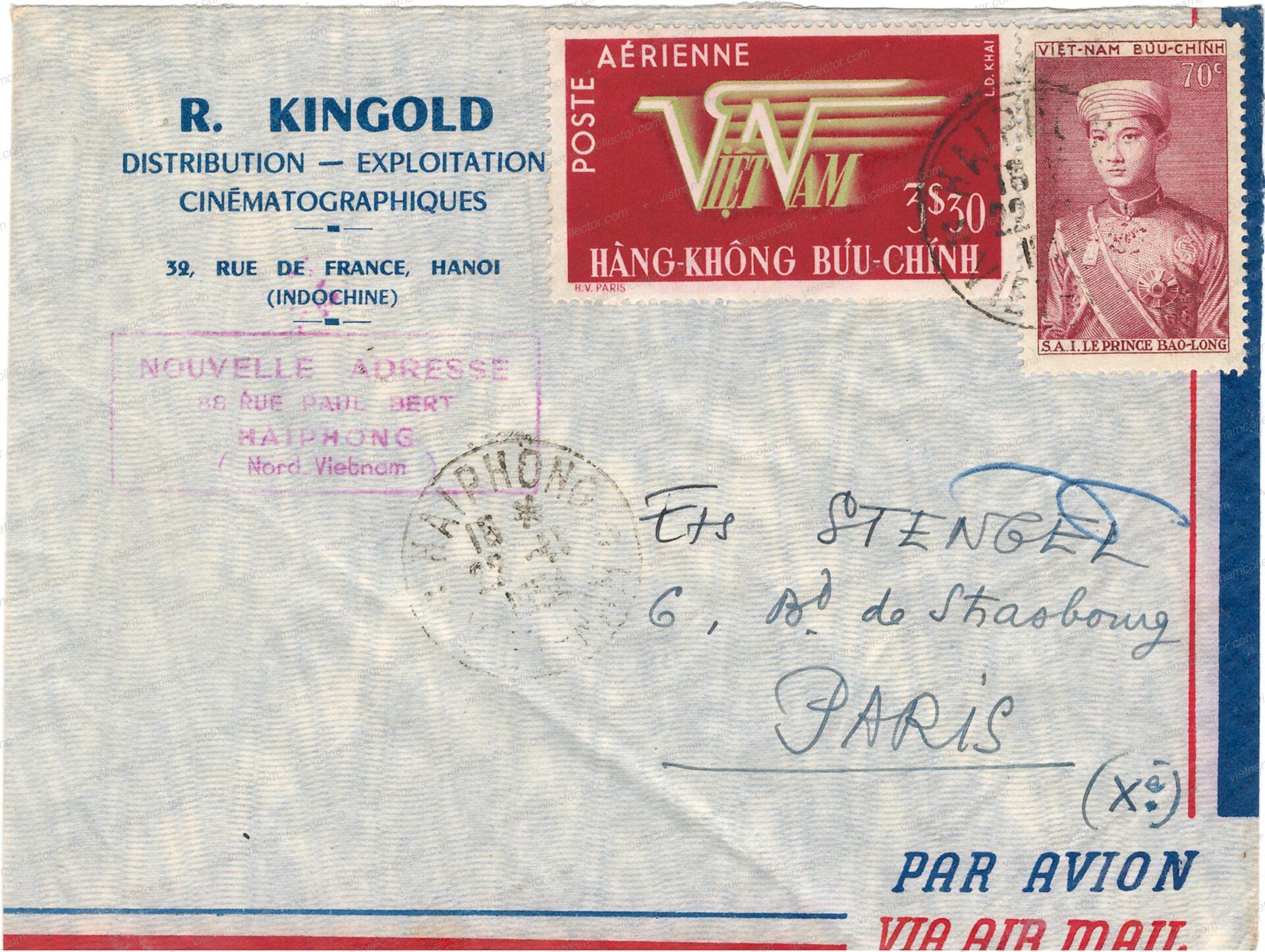
Here is an even later registered letter sent from the enclave of Haiphong to France on February 25th, 1955. It is franked with two 3P Bao Dai plus one 1P Landscape stamps paying an overall postage of 7P.
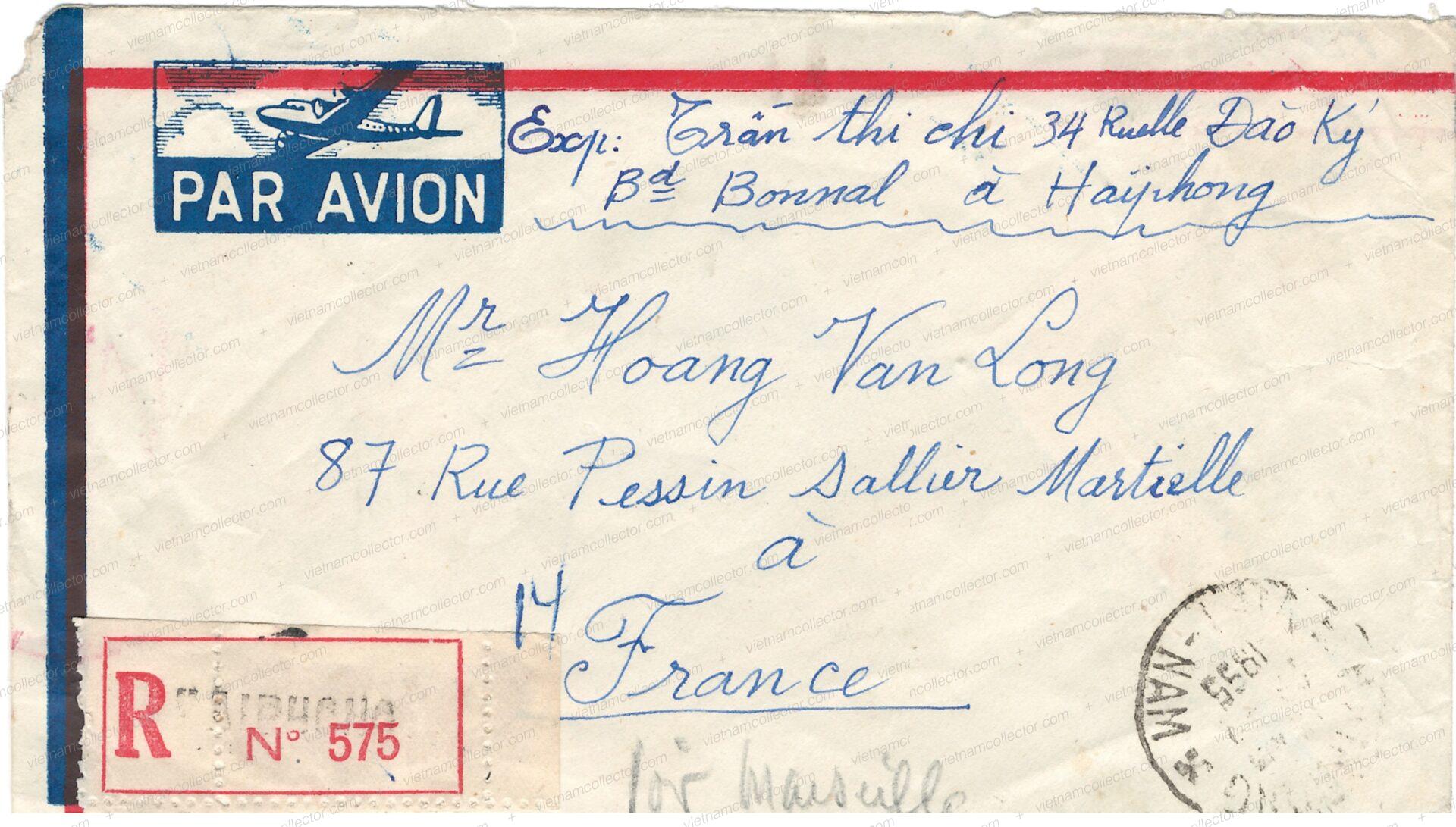
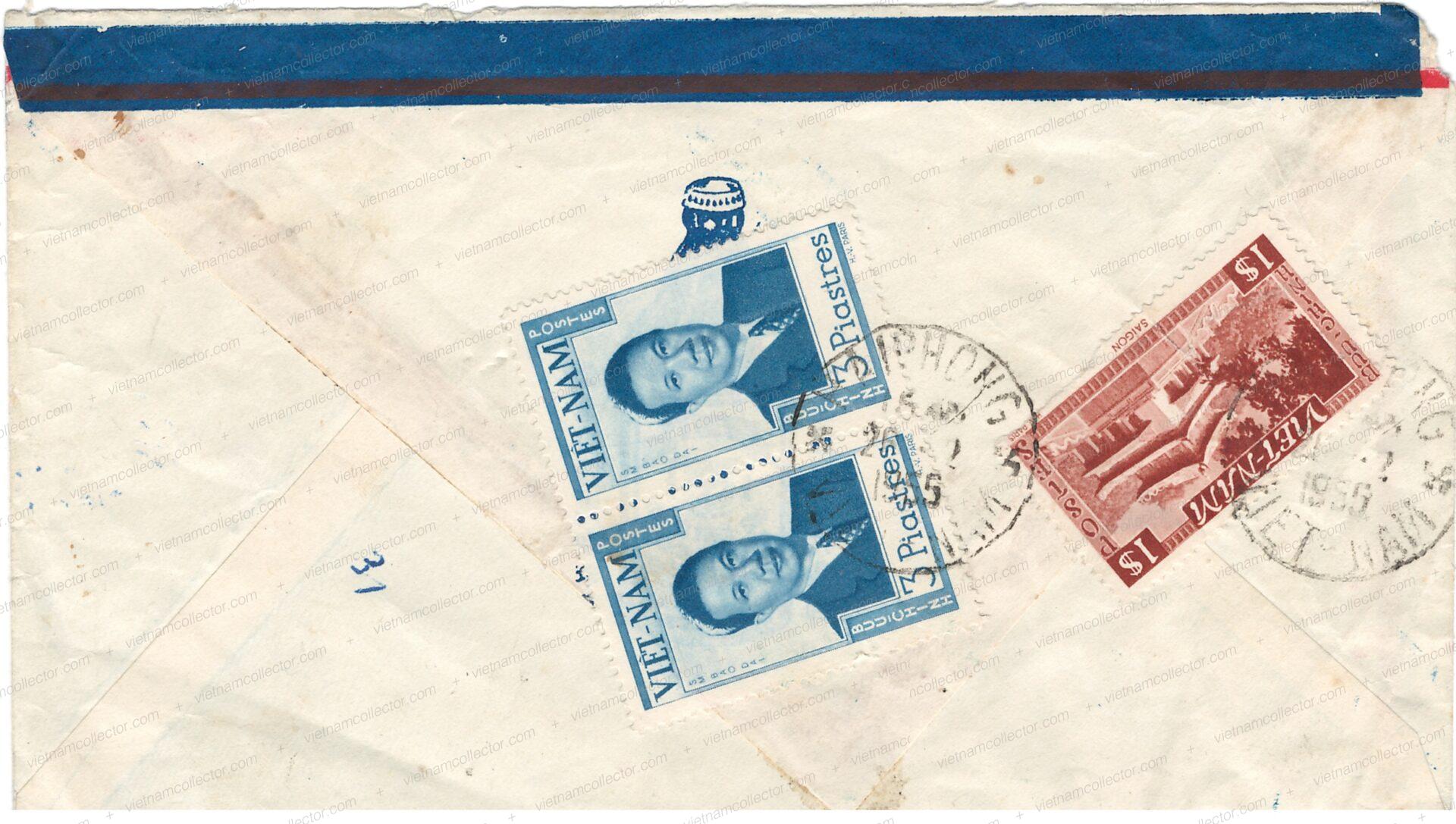
Most State of Vietnam and Republic of Vietnam postage stamps remained valid until the South surrendered to Viet Cong troops on April 30th, 1975, however, a few sets, predominantly those with political themes, became invalid after a few years. Naturally these stamps are scarcer on cover than stamps that could be used for more than two decades.
The first definitive stamp set issued consisted of thirteen individual stamps in nominals of 10c (Q:5,000,000) , 20c (Q:4,000,000), 30c (Q:1,500,000), 50c (Q:2,500,000), 60c (Q:5,000,000), 1 Piastre (Q:5,000,000), 2P (Q:400,000), 3P (Q:3,500,000), 5P (Q:500,000), 10P (Q:4,000,000), 15P (Q:500,000) and 30P (Q:500,000). The values 10c , 20c , 1P, 3P and 15P were also issued as perforated souvenir-sheets that were contained in a booklet or carnet. Michel reports that the 10c and 3P value were issued first (June 6th, 1951) while the 20c, 30c, 50c, 60c, 1P, 2P, 5P, 10P and 15P values followed on August 16th, 1951. The 1.20P (issued on October 29th, 1951) and 30P value (issued on November 23rd, 1951) were issued last.
Here is the mint set with white gum (note, that due to the humid tropical weather conditions many gummed stamps turned brownish over time, they are valued substantially less than stamps with white gum)
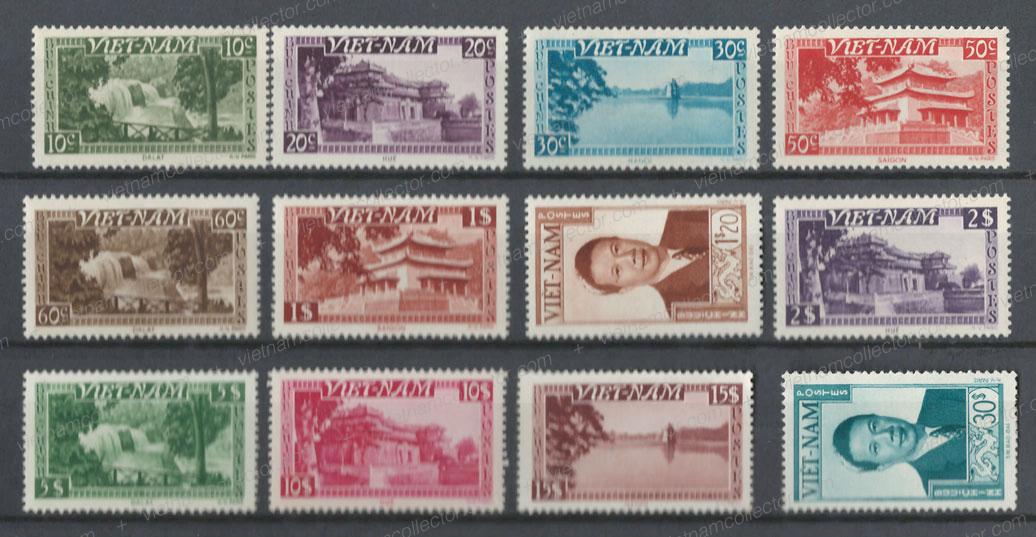
and here the postally used set
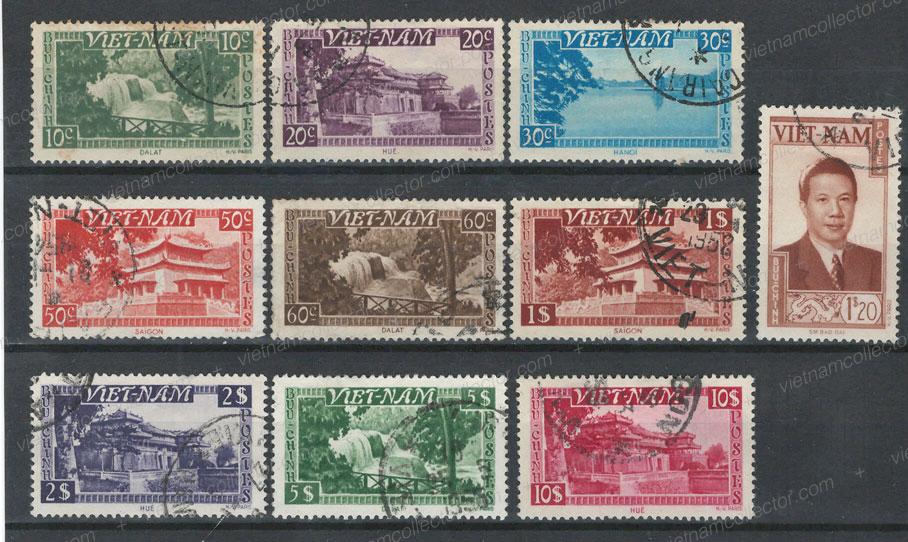
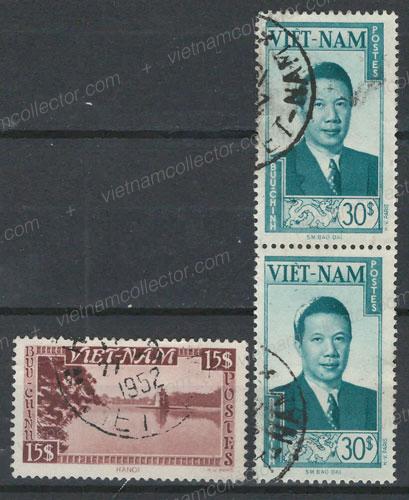
Rare postally used block of six of the 10P stamp that probably was used on a package or large commercial envelope.
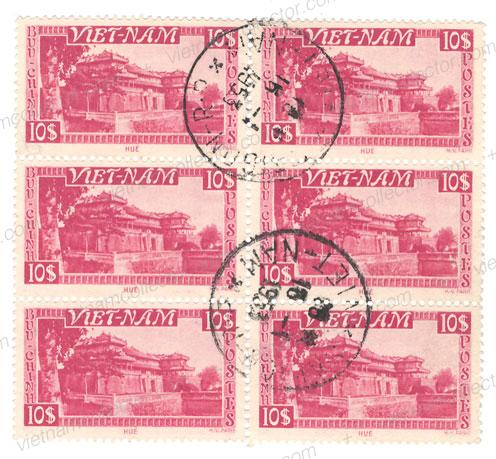
A plate error is known on the 10C value on which the underline of the top right “C” shows a white extension downwards (bottom left stamp):
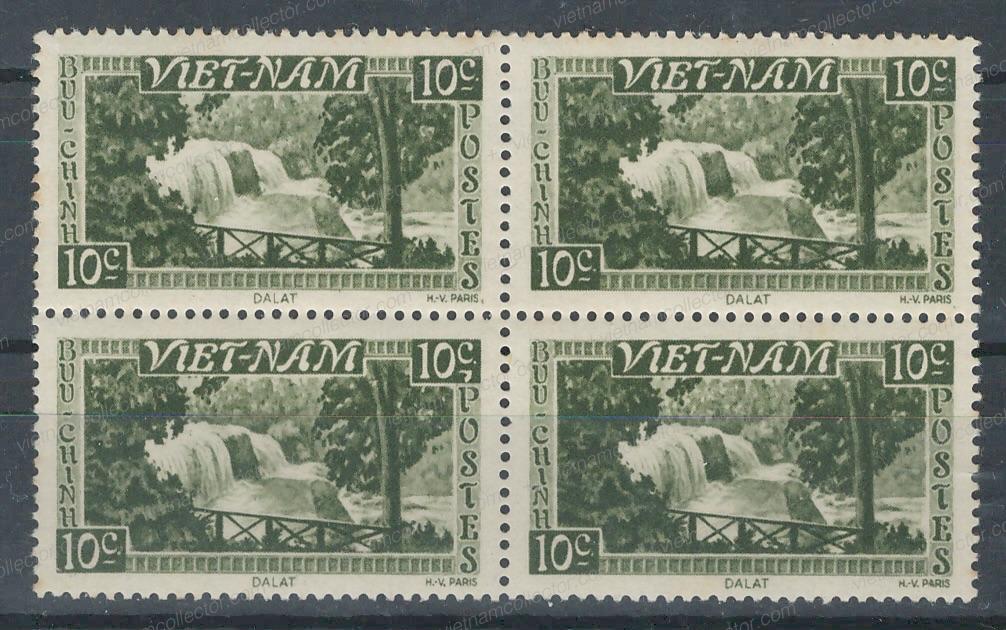
Detail of the affected area:
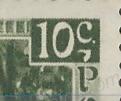
Here is a complete mint sheet of the 10C value that demonstrates that the above depicted plate error only occurs on a partial printing run as it is not present on the sheet. However another plate error can be seen on the bottom left stamp (Position A10) that shows “the 0 in 10 connected to the C”.
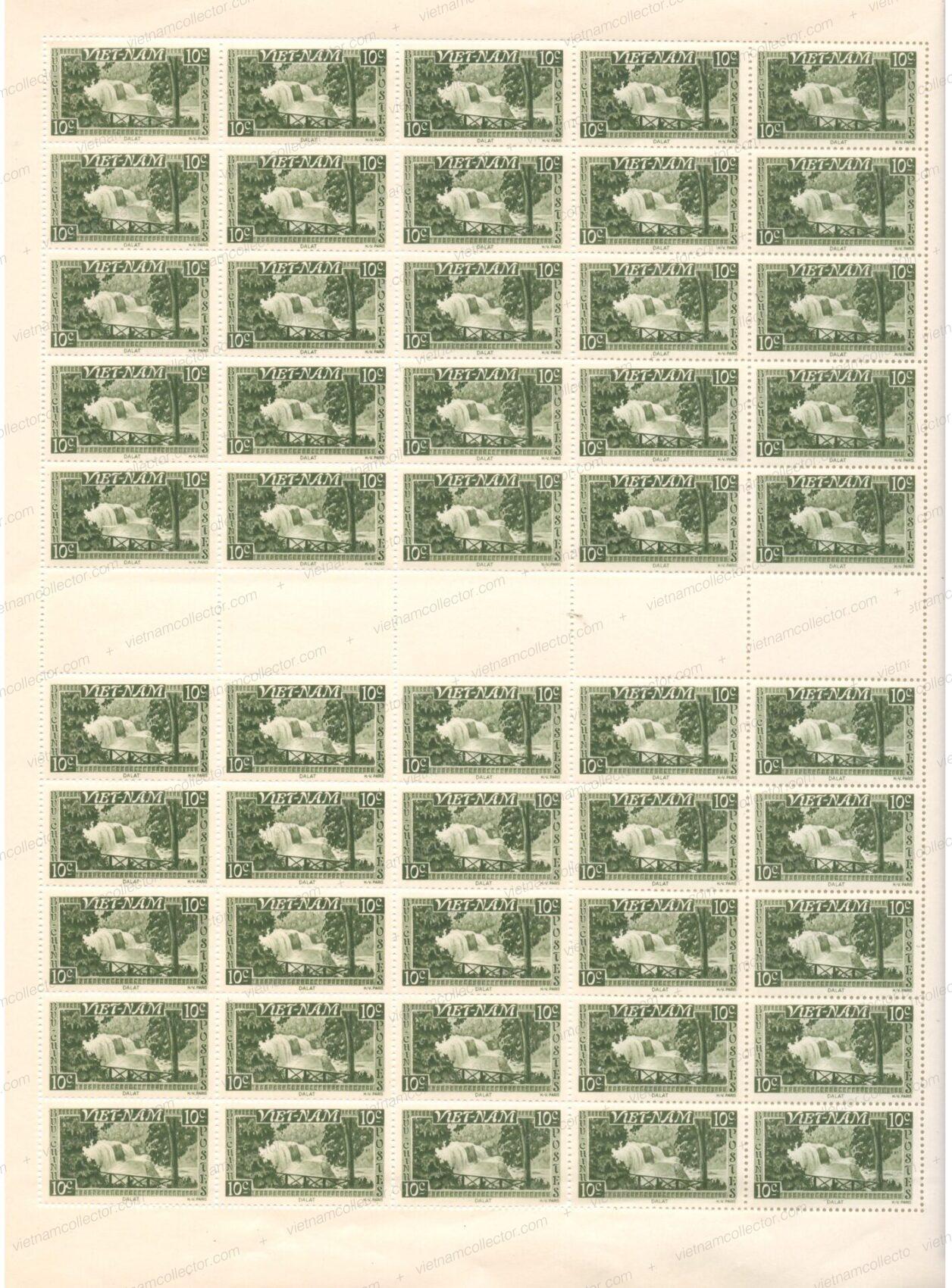
Detailed scan of the stamp with the plate error:
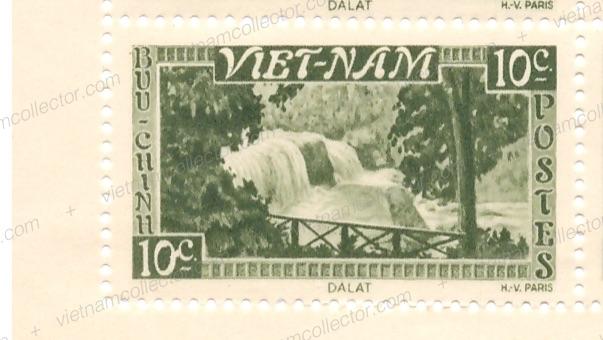
The stamps were produced by Helio Vaugirad in Paris. On the first shipment of the 3 Piastre stamp it was soon discovered by postal authorities that the stamp in position A1 (i.e. the top left corner of the individual sheet) showed a re-occuring plate error. When preparing the cliche’s that made up the double sheet the letter “e” in the word “Piastre” was by error inserted mirrored which means the opening of the “e” is facing left. It is not known yet if the error occurred on the left or the right side of the large sheet as no complete large sheets with the error have been found. Postal authorities immediately removed and destroyed the error stamps from any unsold sheets and all subsequent shipments of the stamp to Vietnam no longer contained the error as it was corrected by the printing works. Since most of the stamps in the first shipment were bought by philatelist in order to produce First Day or other commemorative covers the error is most likely to be found used on one of them. Having said that the error is very rare and the editor spent almost twenty years to locate both, the mint and a used sample of the plate error. For treaasure hunters note that there is a “tell” of the error in the shape of a spot in stamp color above the letters “str” in Piastres. Michel has now listed this error for the first time and prices it as -.- for mint (price cannot be established due to market activity) and Euro 800 for used. Given the rarity of the error the editor would not be surprised if market prices would settle in to exceed the catalogue value.
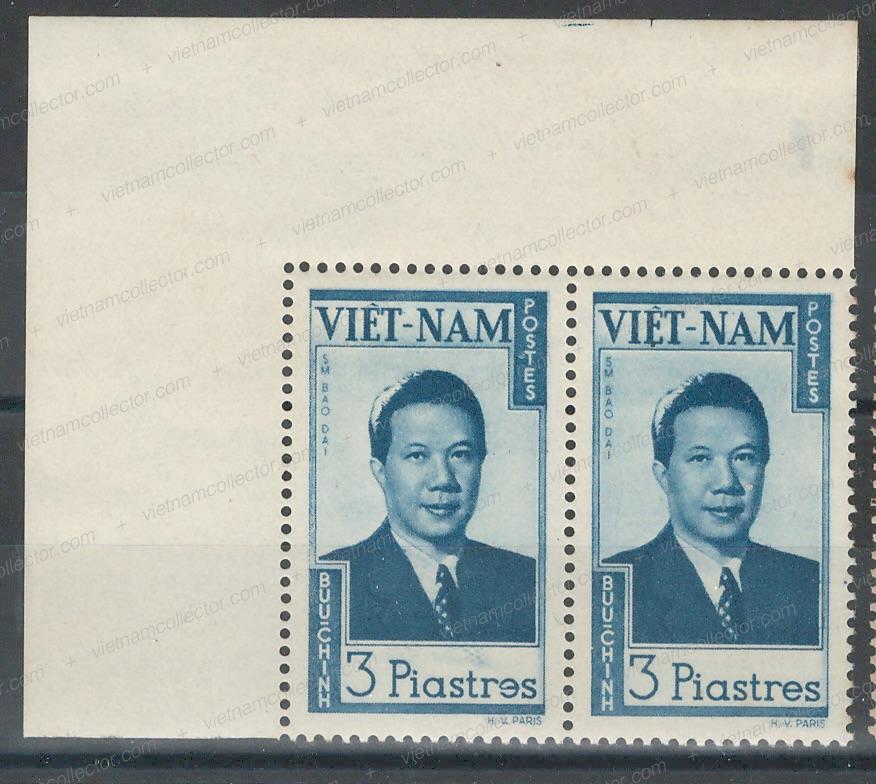
Detailed scan of the affected area
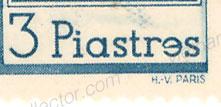
Here is a pair of the 3D stamp with the left, cancelled to order, stamp being the error stamp. Cancelled in June of 1951
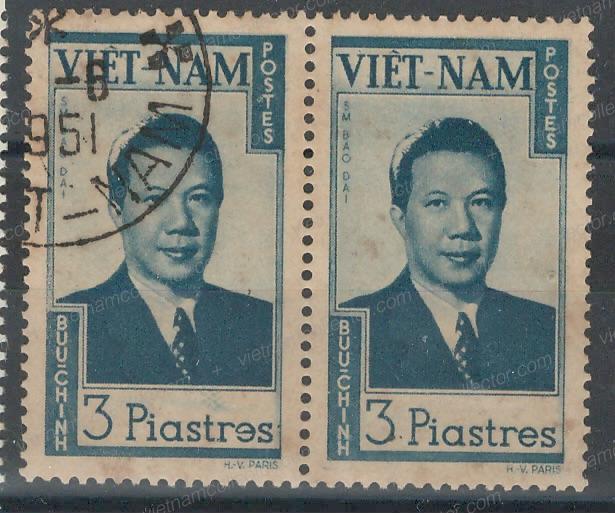
Here is a postally used block of four on a piece that was cut from a registered letter. The top left shows the ‘reverse e’ error. Here the error stamp was postally used:
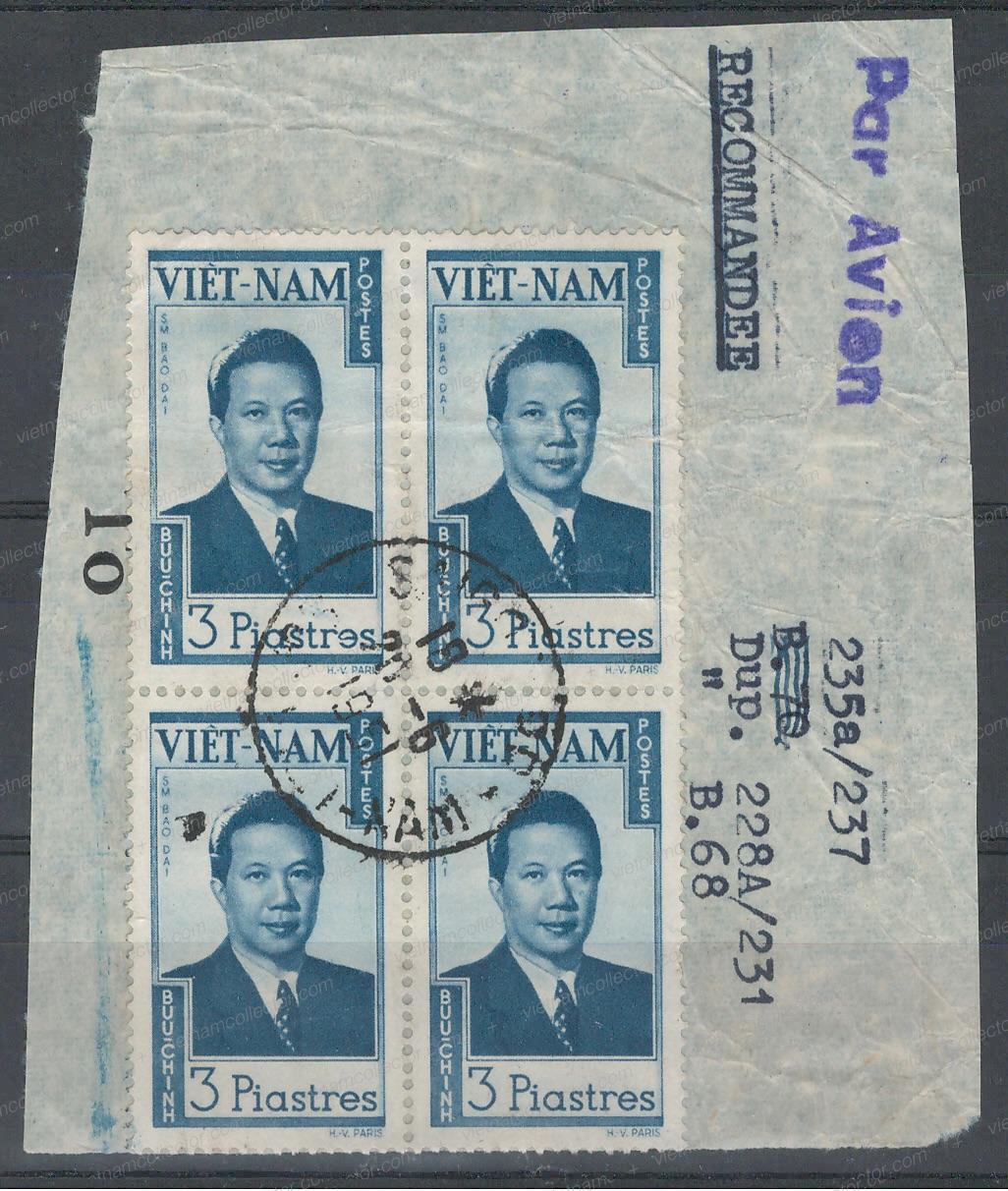
Detail of the affected area:
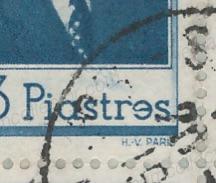
Single cancelled error stamp with the reverse “e” commercially used in Hanoi.

Here is a complete double sheet of the 3 Piastres value. It does not show the plate error described above but the error would be located at the top left stamp of the sheet. The top sheet margin is intact but simply did not fit entirely on the scanner.
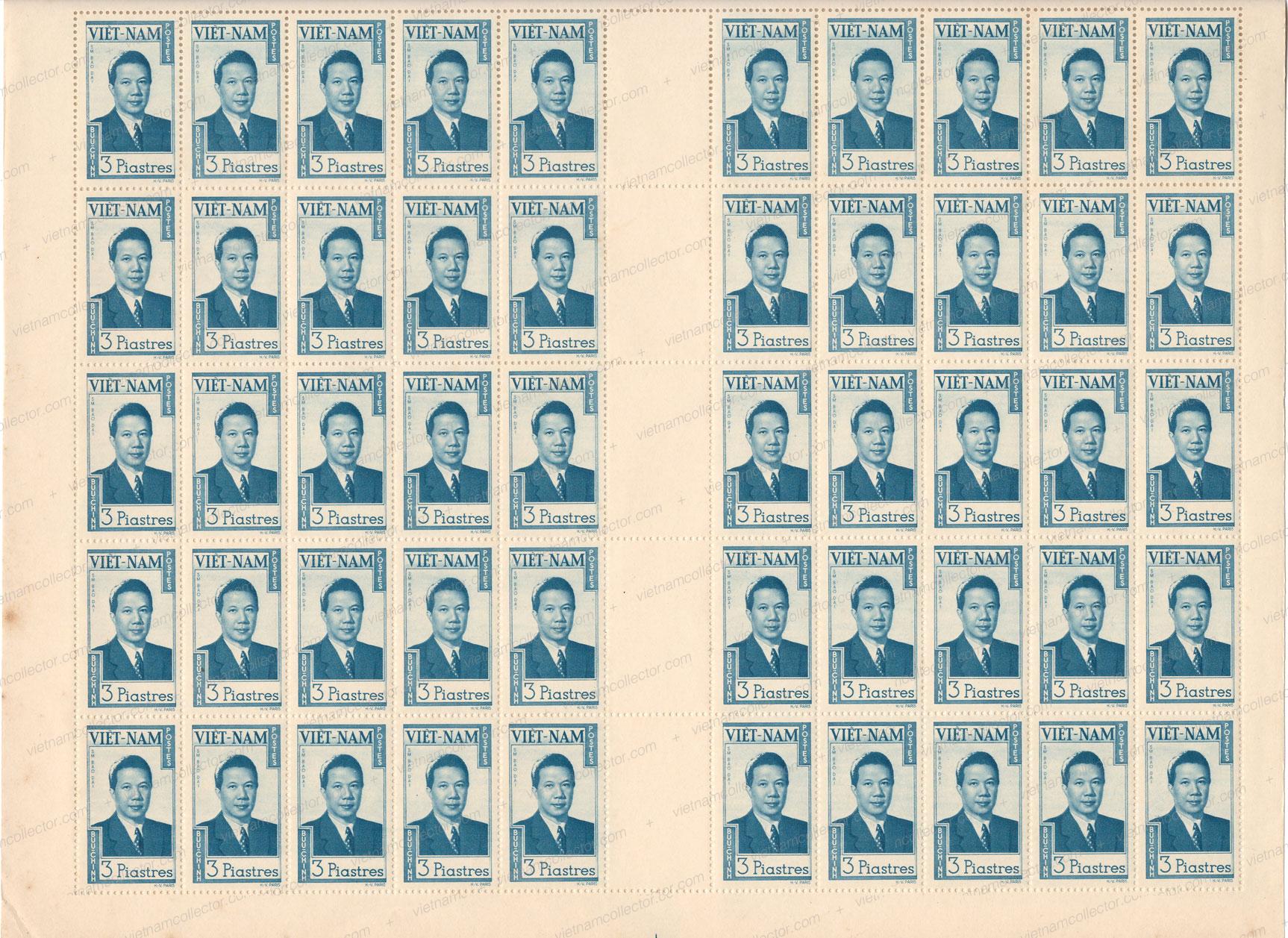 Complete sheets of the 1.20P and 30P values
Complete sheets of the 1.20P and 30P values
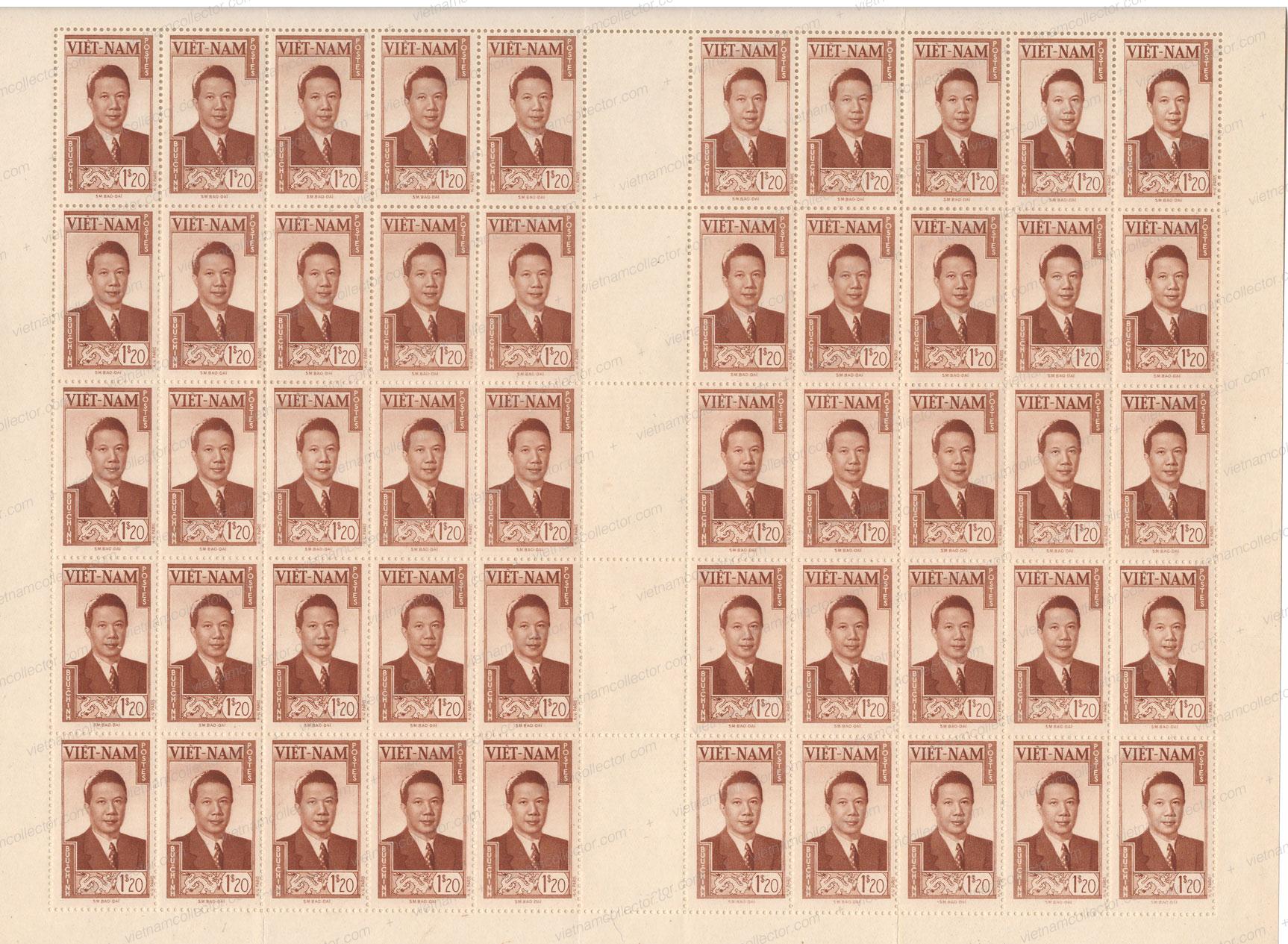
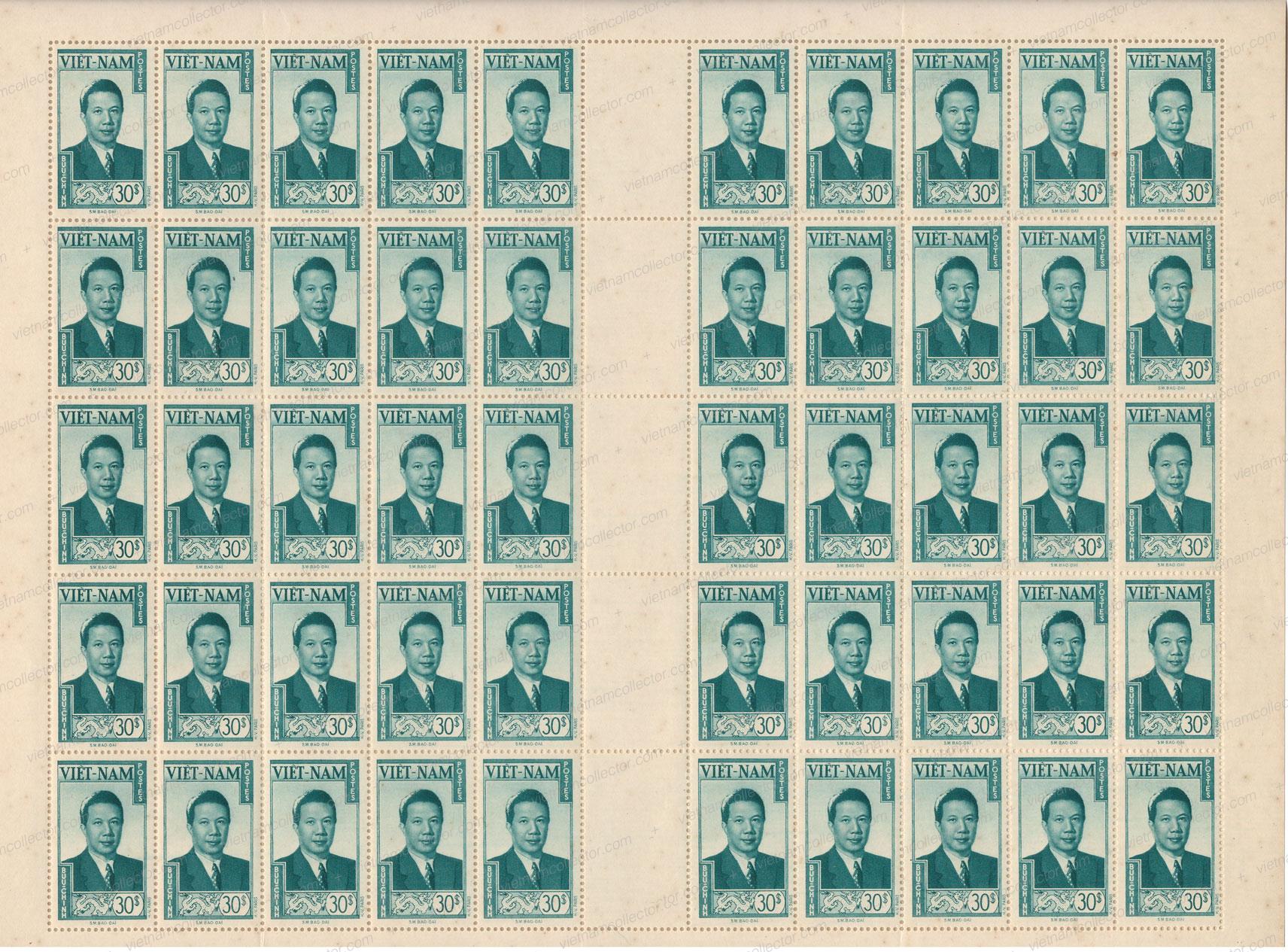
This is the front of the booklet or carnet that contained the five souvenir-sheets. The five gummed souvenir-sheets were separated from each other by parchment paper. Due to the high humidity the sheets often got stuck on the parchment paper. Clean specimens with white gum and unstuck are surprisingly hard to find. The booklet was held together by two steel clamps. These steel clamps often became rusty as a result of high humidity. The carnet was produced by Helio Vaugirard-Paris. The name is embossed on the bottom right of the reverse of the cover.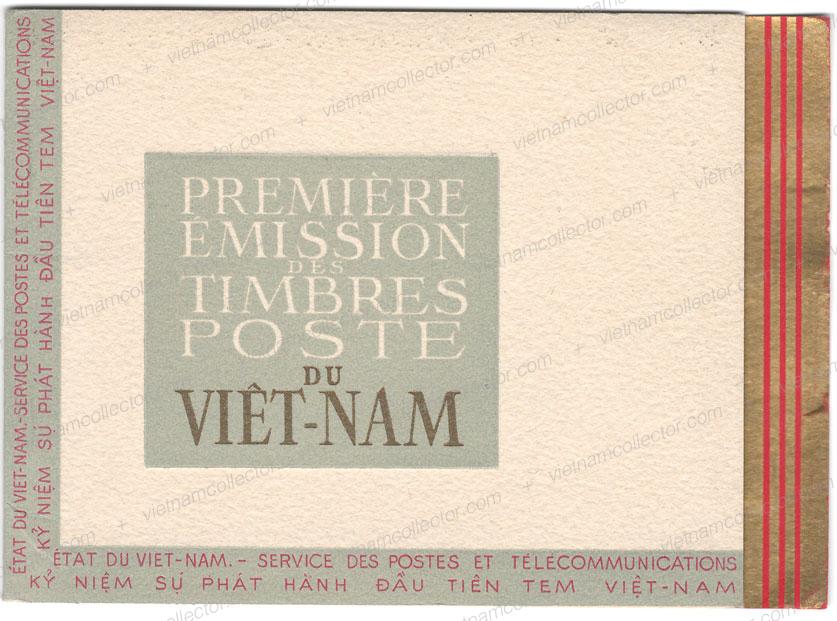
Mint souvenir-sheets
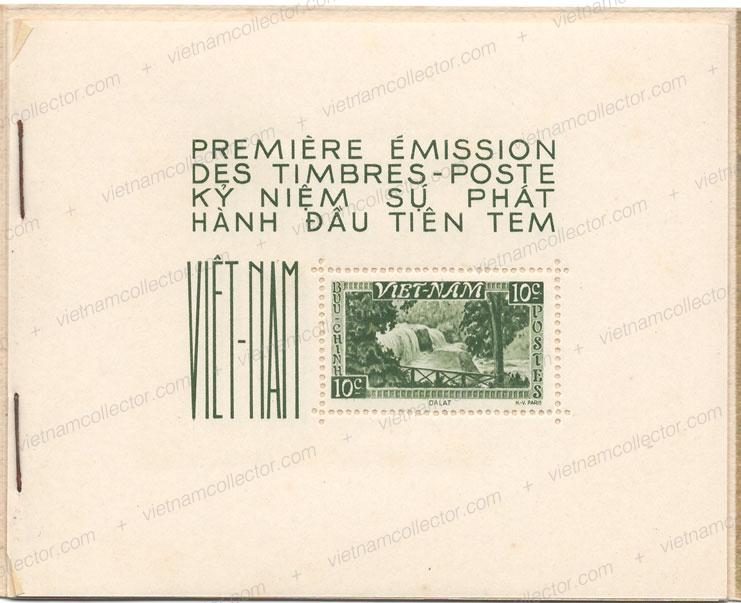
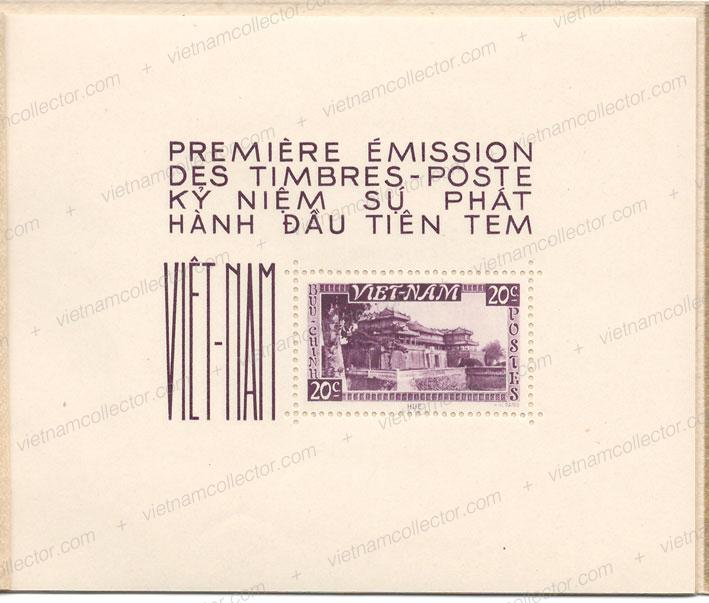
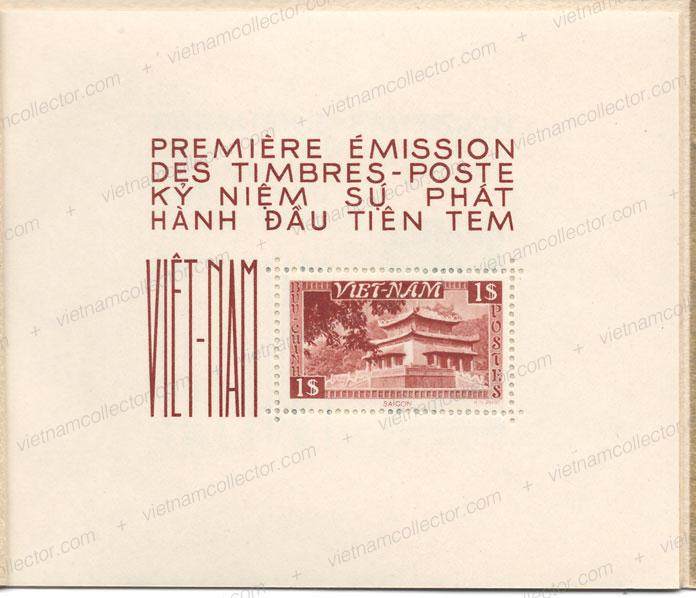
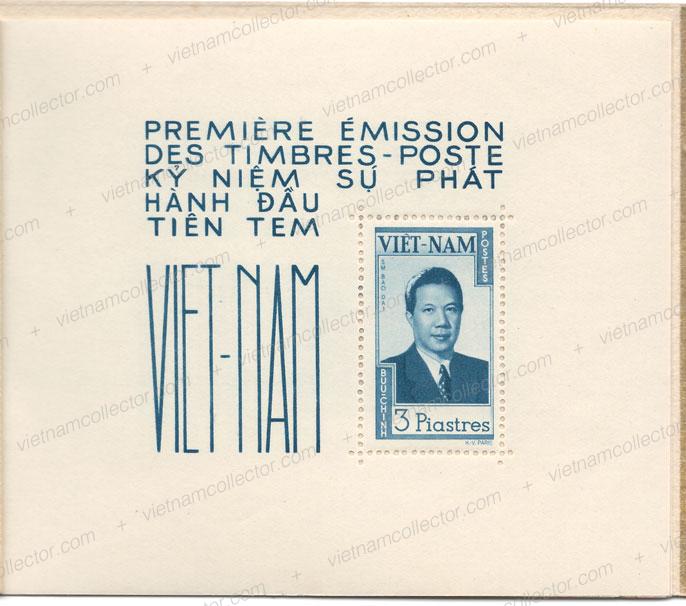
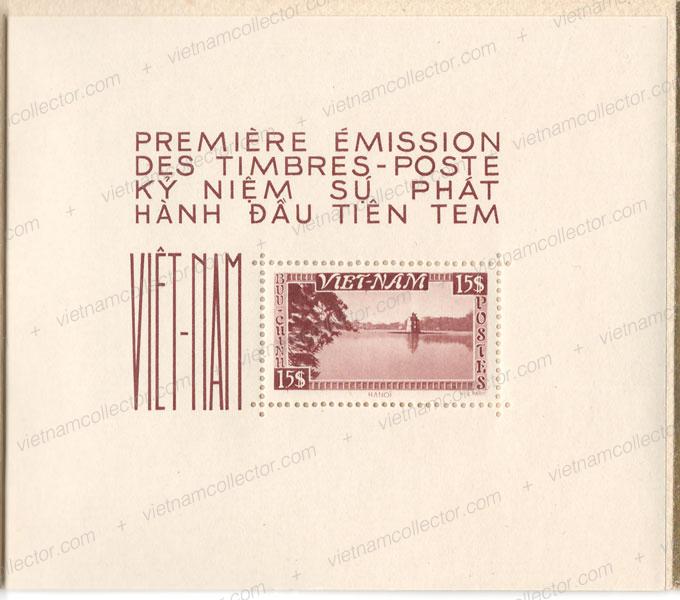 Not many of these souvenir-sheets were cancelled as they were made for philatelists and they preferred not to subject them to postal treatment that may have damaged the sheets. As a result it is very difficult to locate them cancelled. Basically all of the cancelled sheets were cancelled by the Saigon Philatelie Department. To date the editor has yet to see a letter sent with one of the sheets.
Not many of these souvenir-sheets were cancelled as they were made for philatelists and they preferred not to subject them to postal treatment that may have damaged the sheets. As a result it is very difficult to locate them cancelled. Basically all of the cancelled sheets were cancelled by the Saigon Philatelie Department. To date the editor has yet to see a letter sent with one of the sheets.
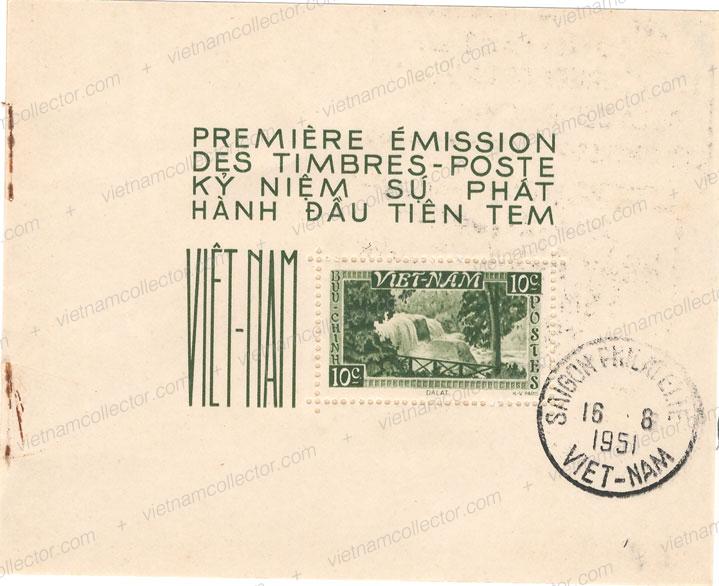
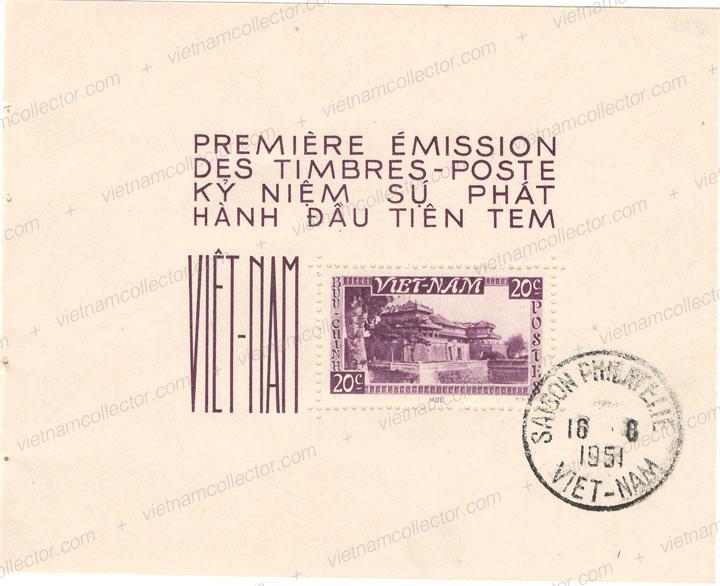
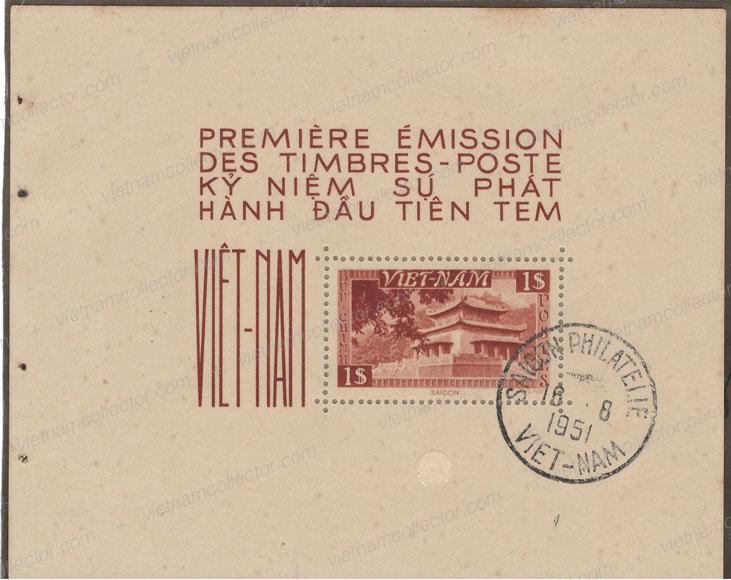
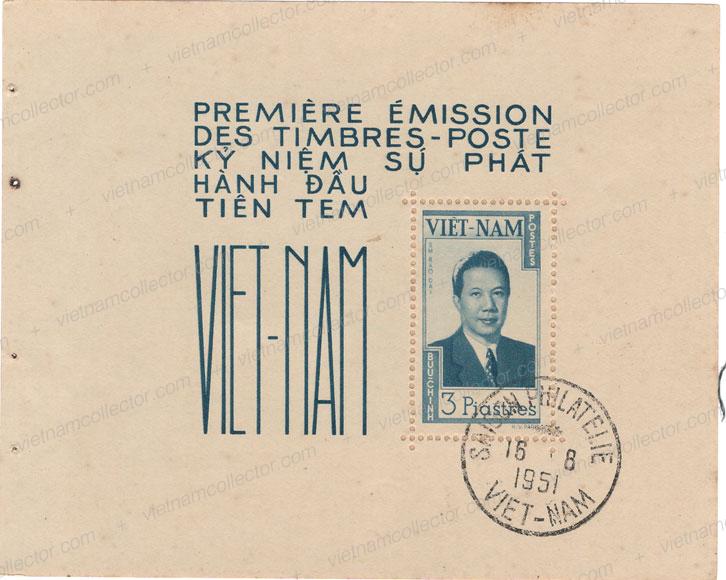
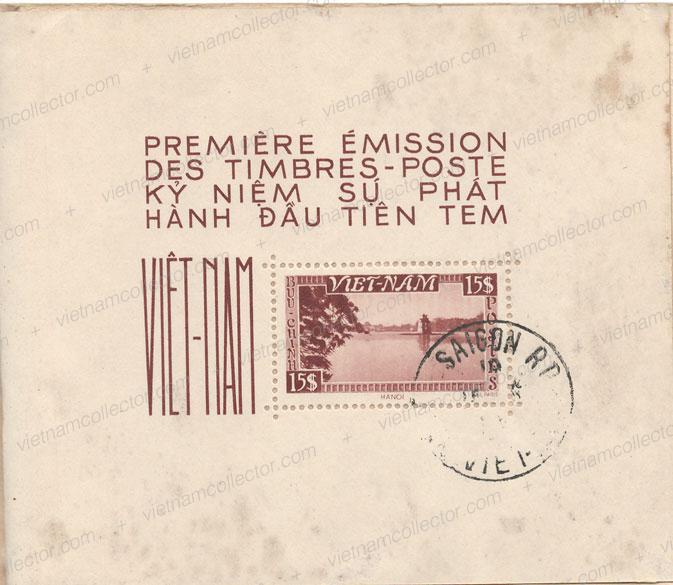
A very small number of Enpreuve de Luxe imperforate sheetlets, also called “Minister Blocks” were produced on light carton paper as sunken die proofs and handed out or sent to very important people of other countries. These early sheetlets are very rare and seldom come to market. They are not comparable to Enpreuve de Luxe issued later primarily for the benefit of collectors. A complete set of them was sold at auction by Interasia Auctions in Hong Kong for more than U.S. $ 12,000 in 2017 which is almost $1,000 per sheetlet.
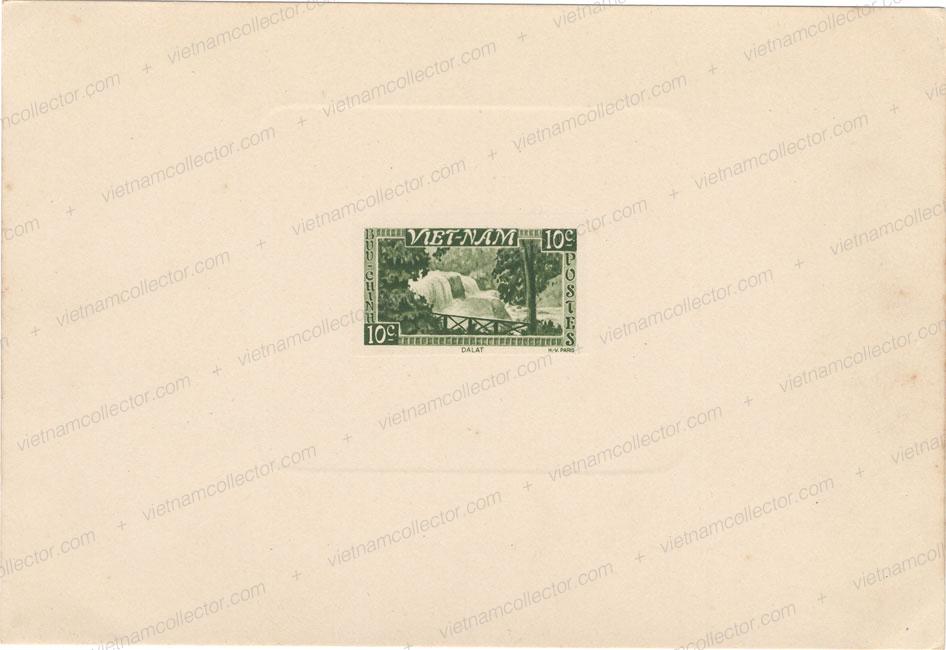
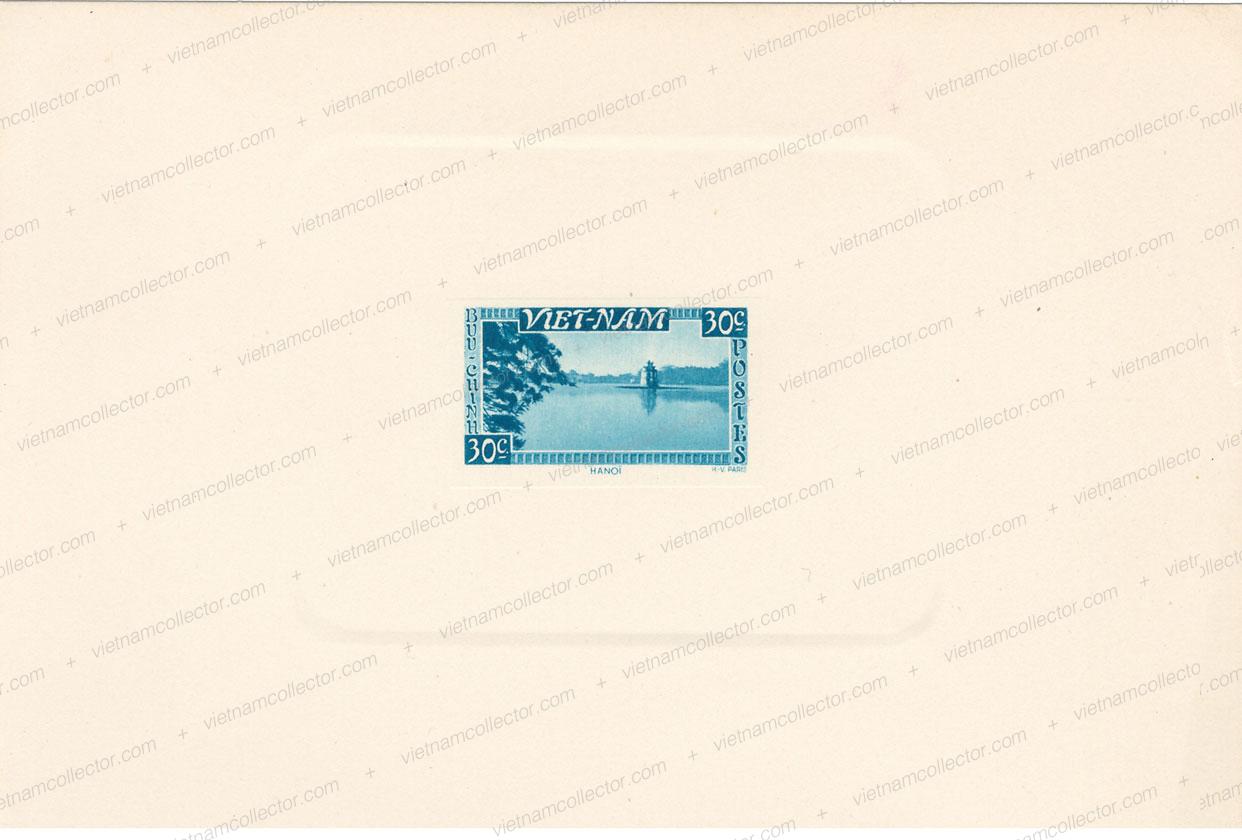
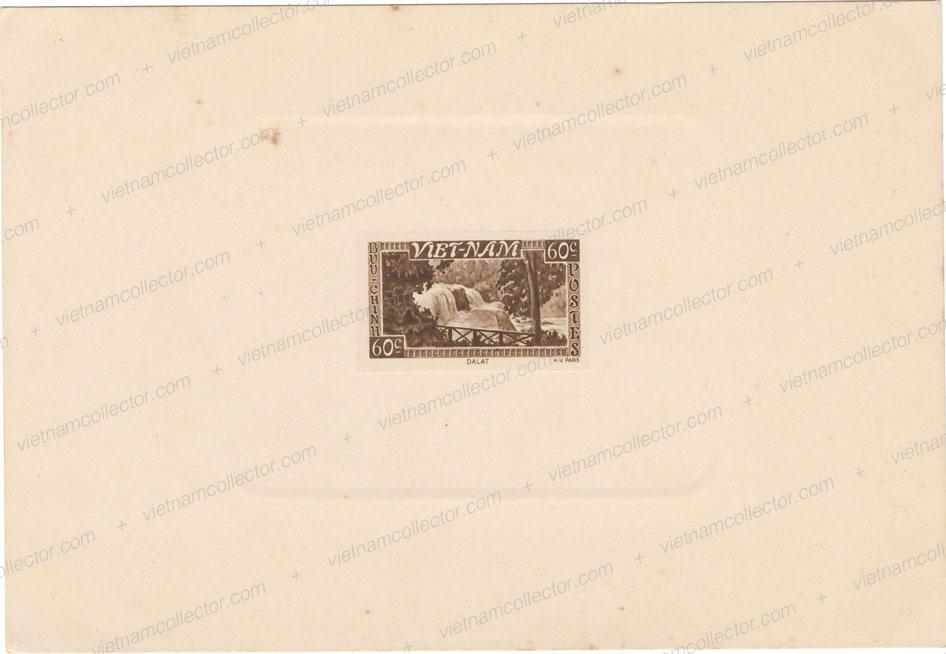
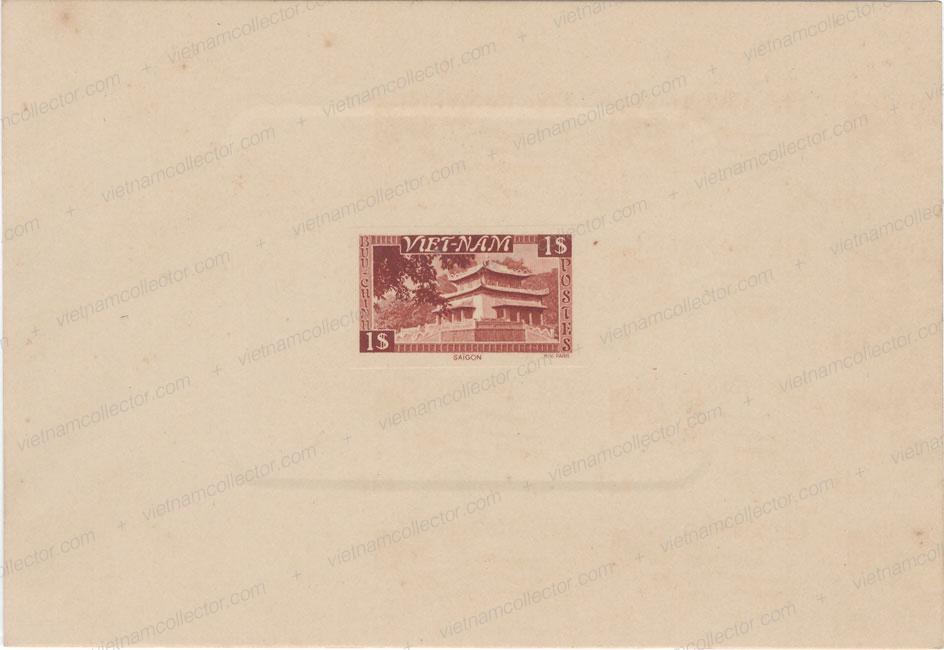
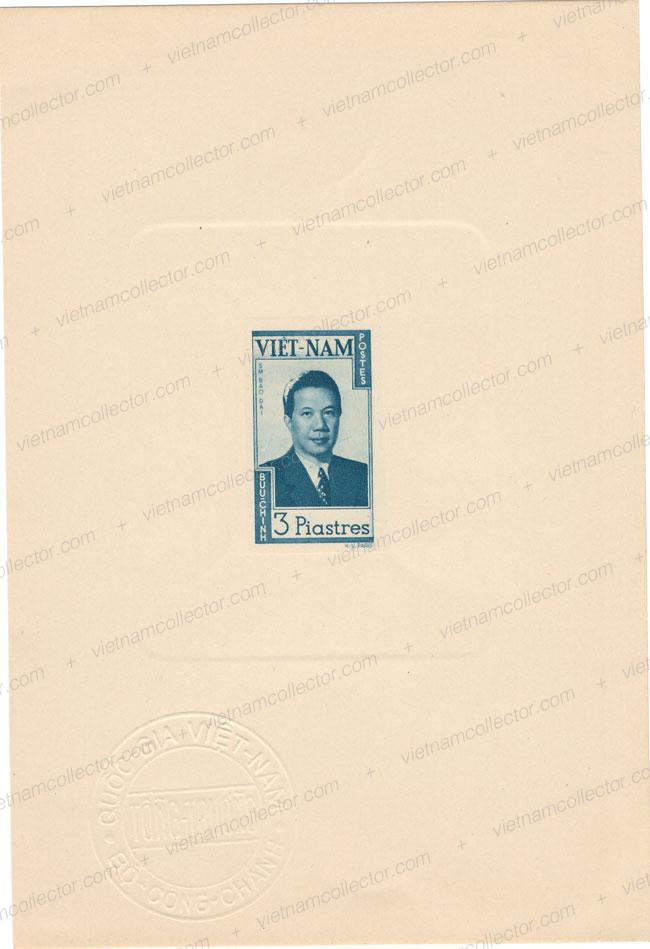
The 3P Enpreuve de Luxe sheet was collected together with the card and envelope in which it was sent to the President of Italy documenting that only very important people were able to obtain these prints.
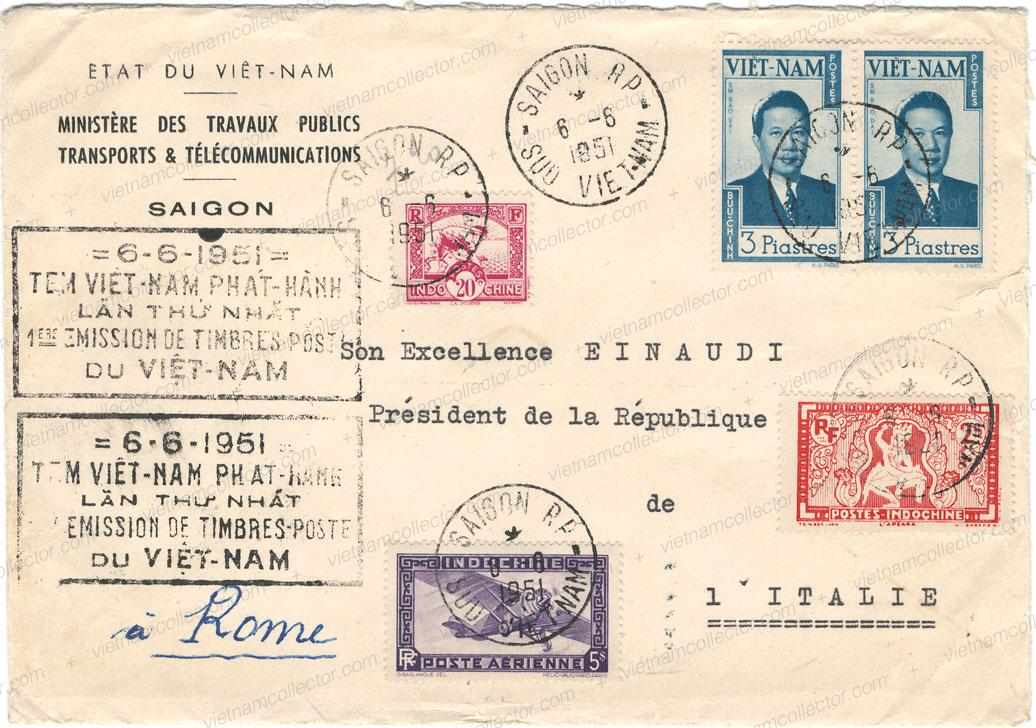
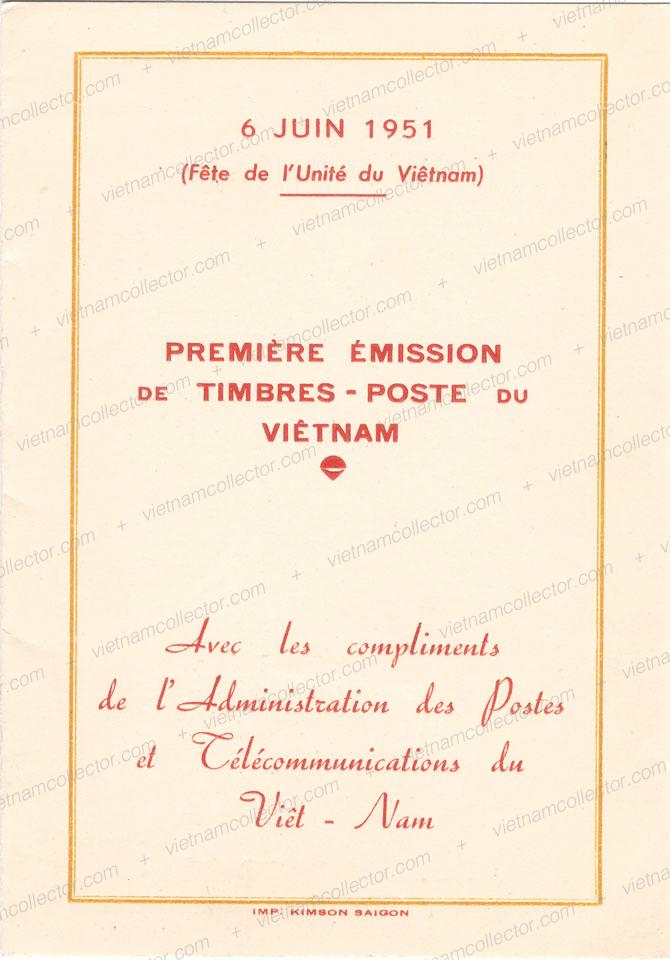
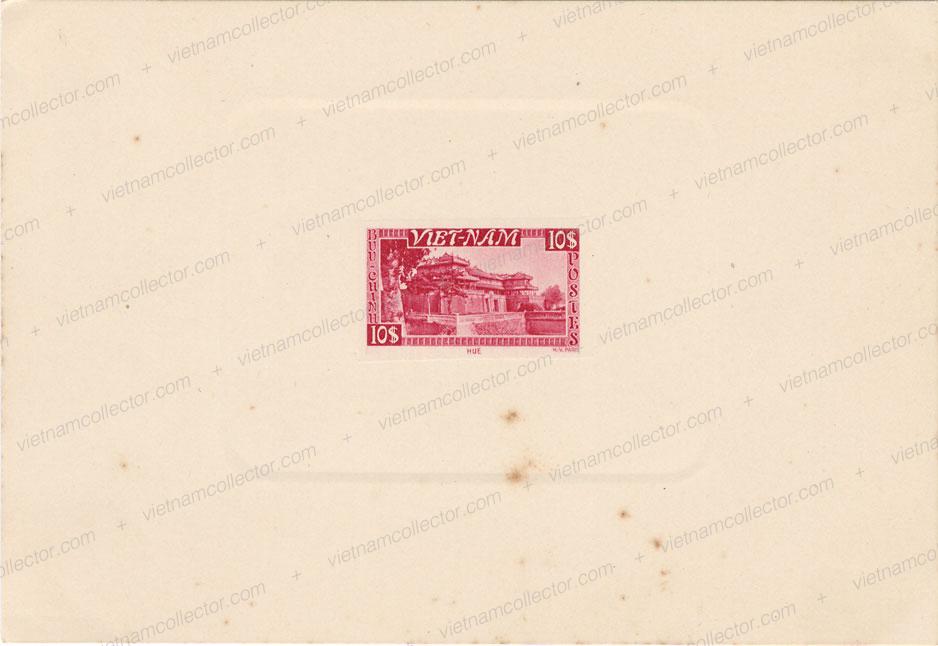
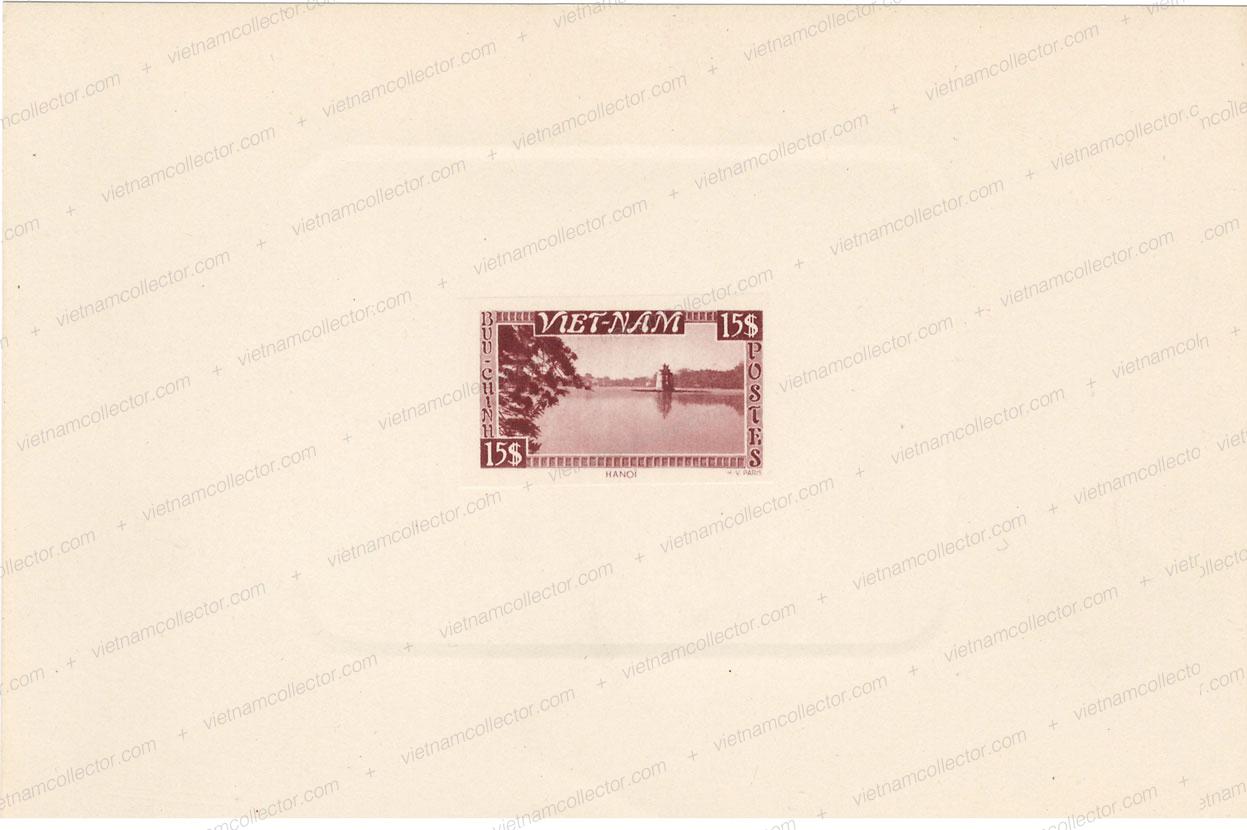
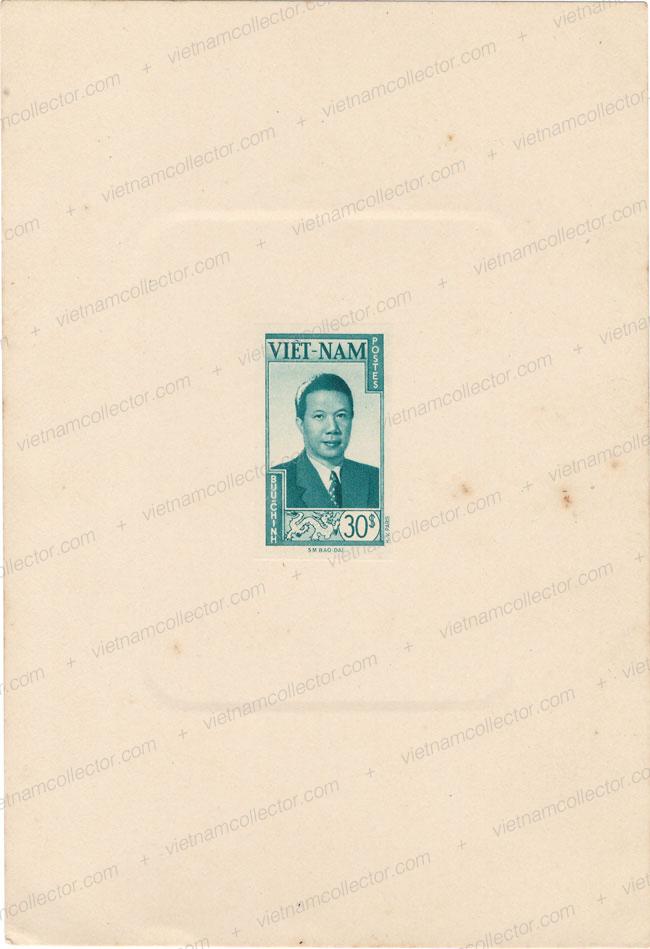
Mixed franking of Indochinese stamps together with the 10c Landscape values paying an overall postage of 3.30P on an international letter sent in November of 1951 from Nha Trang to France. These mixed frankings were possible from June 6th, 1951 (when the first Vietnam stamps were issued) until April 1st, 1952, when all Indochinese stamps were declared invalid.
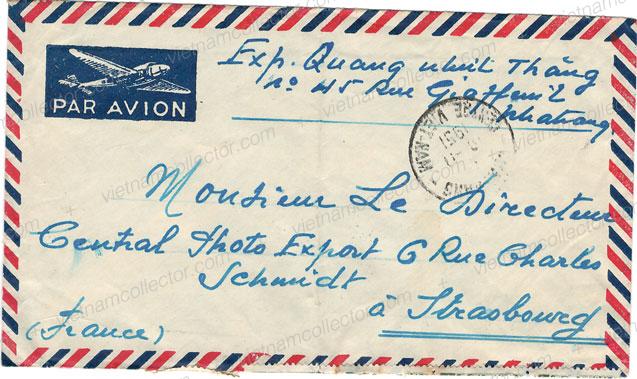
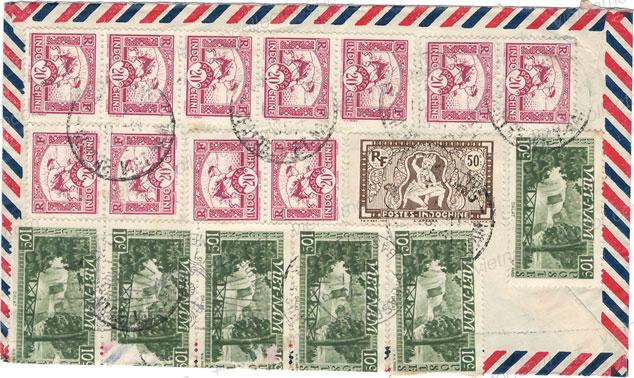
Local letter featuring a multiple franking of the 10c value paying an overall postage of 50c on a local letter sent from Hai Phong in February of 1953 to Saigon. Saigon machine arrival cancel on the reverse. The standard domestic letter rate at the time amounted to 1.50P so the 50c tariff probably represents either printed matter or some other form of mass mailing.
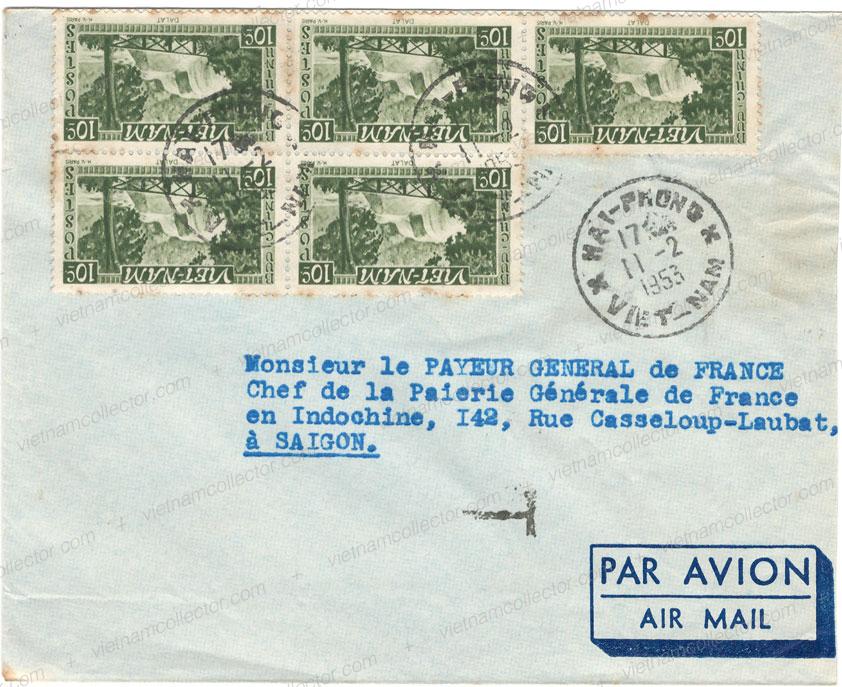 Mixed franking of the 10C Landscape stamps (5) together with the 1P value paying an overall postage of 1.50P on a domestic letter sent in February of 1954 sent to Mytho. Mytho arrival cancel on the reverse. The bottom 10C stamp shows the plate error top right “C” shows a white extension downwards. Plate errors on postally used correspondence are very rare.
Mixed franking of the 10C Landscape stamps (5) together with the 1P value paying an overall postage of 1.50P on a domestic letter sent in February of 1954 sent to Mytho. Mytho arrival cancel on the reverse. The bottom 10C stamp shows the plate error top right “C” shows a white extension downwards. Plate errors on postally used correspondence are very rare.

Detailed scan of the affected area:

Letter front featuring a multiple franking of the 10c value (5) sent within Saigon in August of 1952 featuring the same 50c tariff as shown above.
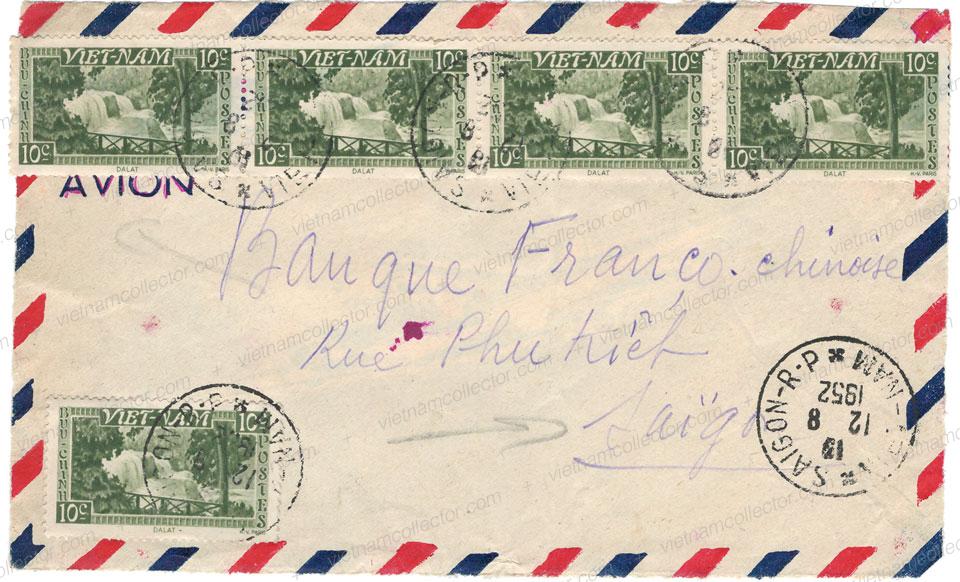
Mixed ranking of two of the 10C Landscape values together with the 6.50P Air mail stamp paying an overall postage of 6.70P on a letter sent from Saigon to France. The bottom 10c stamp shows a plate error or printing flaw under “c” of “10c”. Error stamps on postally used cover are very rare.
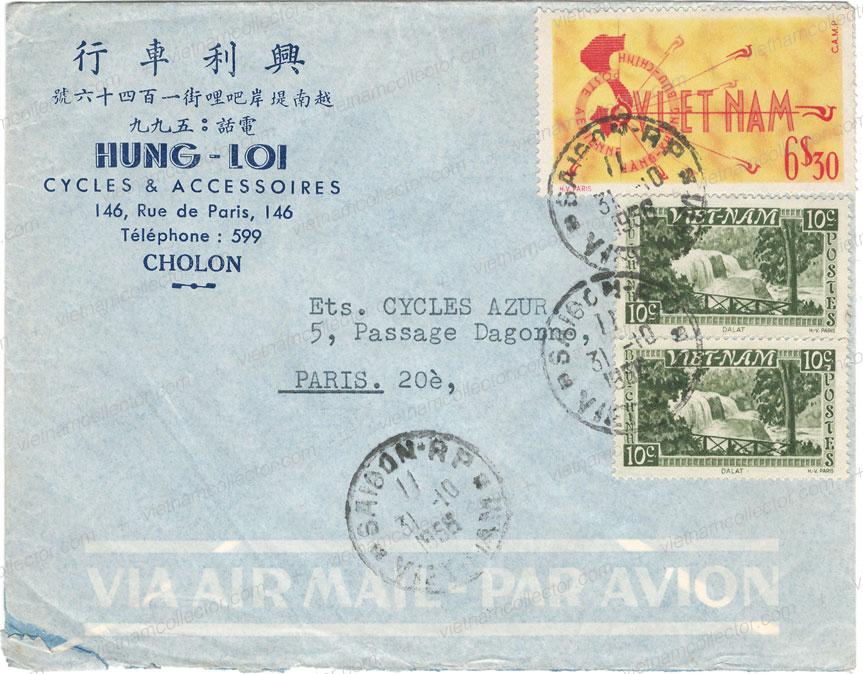
Detail of the affected area

Mixed franking of the 10C Landscape stamps (4) together with the 0.90D (2) and 3.70P Erring Souls stamps paying an overall postage of 5.90P on an international air mail letter sent from Saigon to Austria. The letter was censored in Austria as can be seen by the blue censor cachet on the front and the brown closing tape. The bottom left 10C Landscape stamp shows a plate error “. Plate errors on postally used covers are very rare.
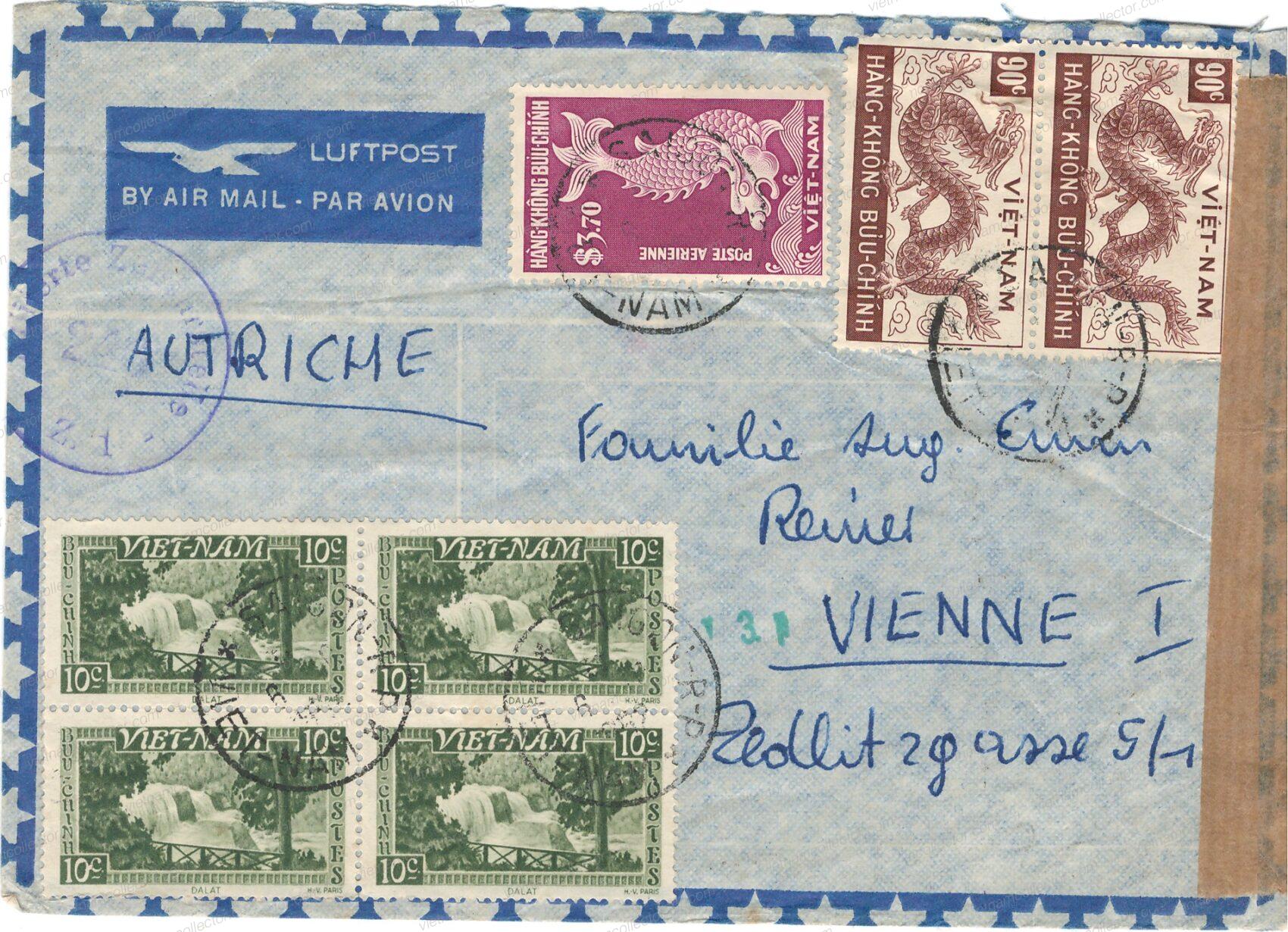
Detailed scan of the affected area:
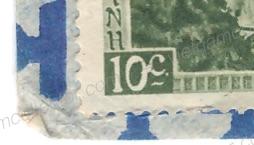
Mixed franking of the 10c value (5) plus one of the 1P stamps paying an overall postage of 1.50D on a local letter sent from Dalat to Saigon in September of 1952.
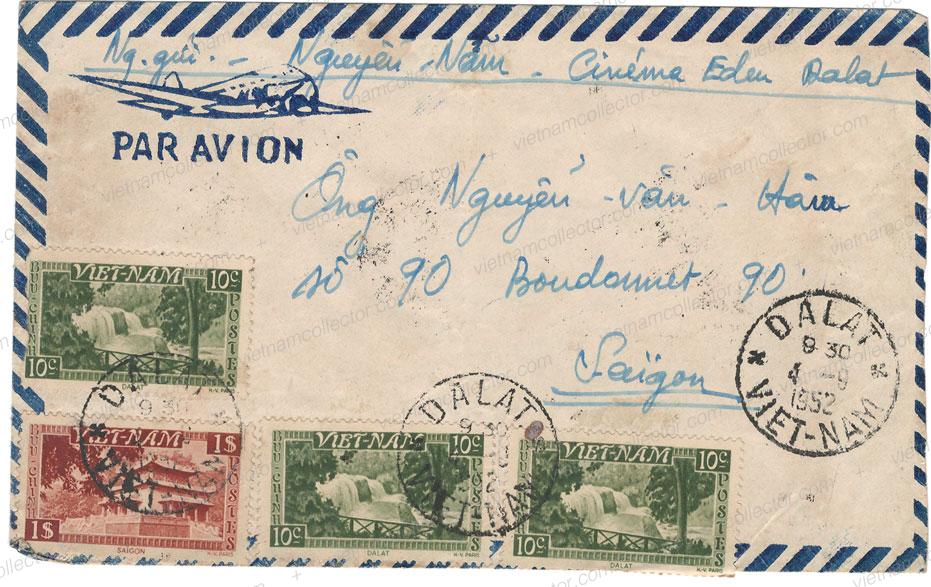
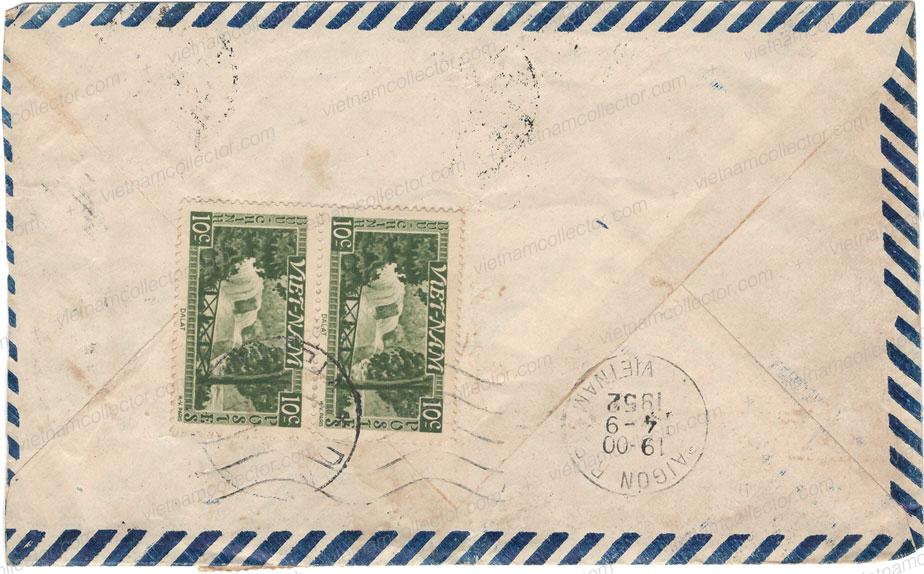
Mixed franking of one 10c, two 20c together with the 4P Ngô Đình Diệm value paying an overall postage of 4.50P on a printed matter mailing by the Societe Maritime D’ Extreme Orient from Saigon to France in January of 1957. Most printed matter mailings were thrown away so are now hard to find.
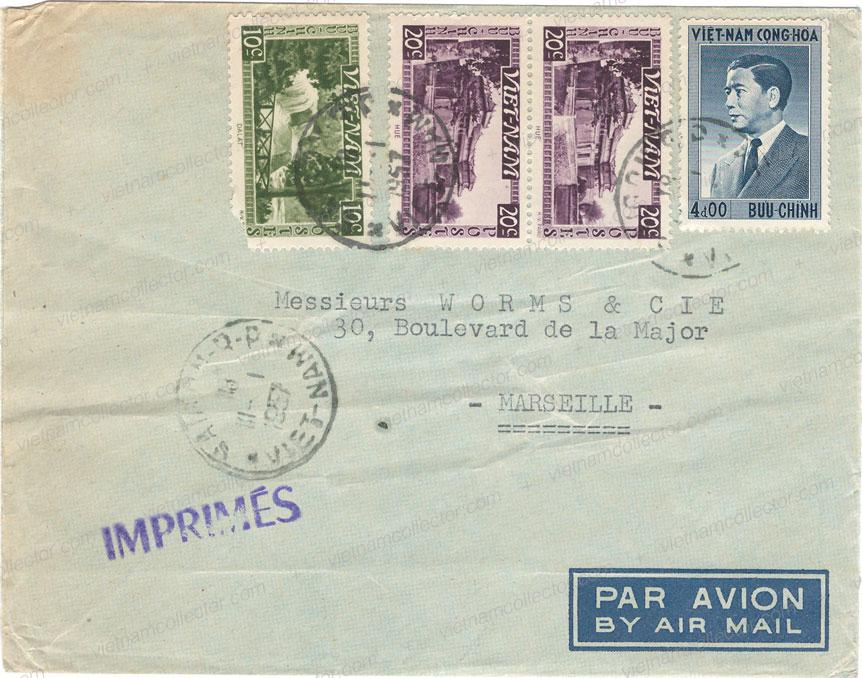
Very unusual use of two 0.20C stamps as revenue stamps paying a 0.40C fee for the issuance of a school testimony.
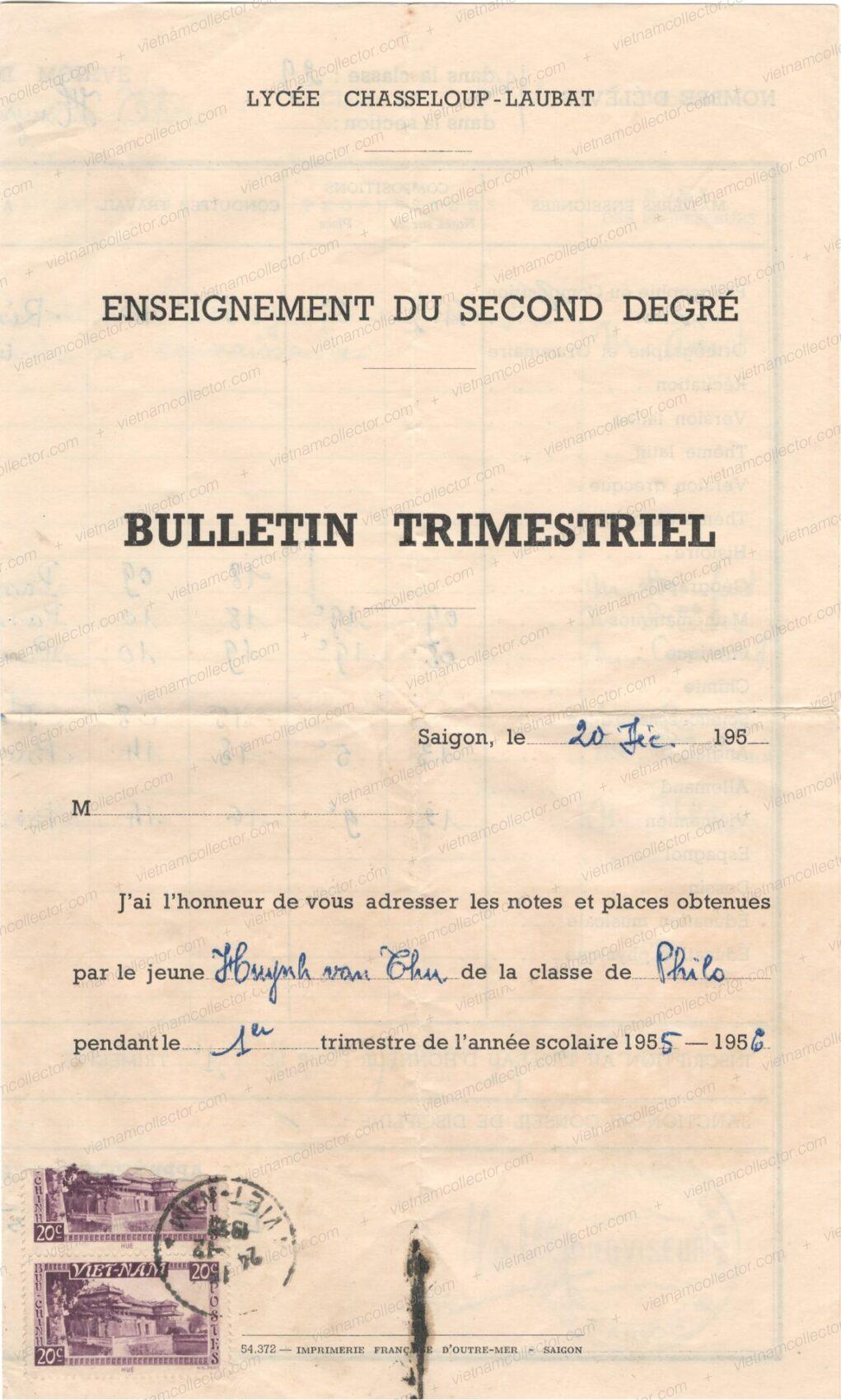
Here is a similar franking of the 20C stamp (2) paying 40C on a newsletter wrapper mailed in Saigon in December of 1954 to Thua Than. Rare.
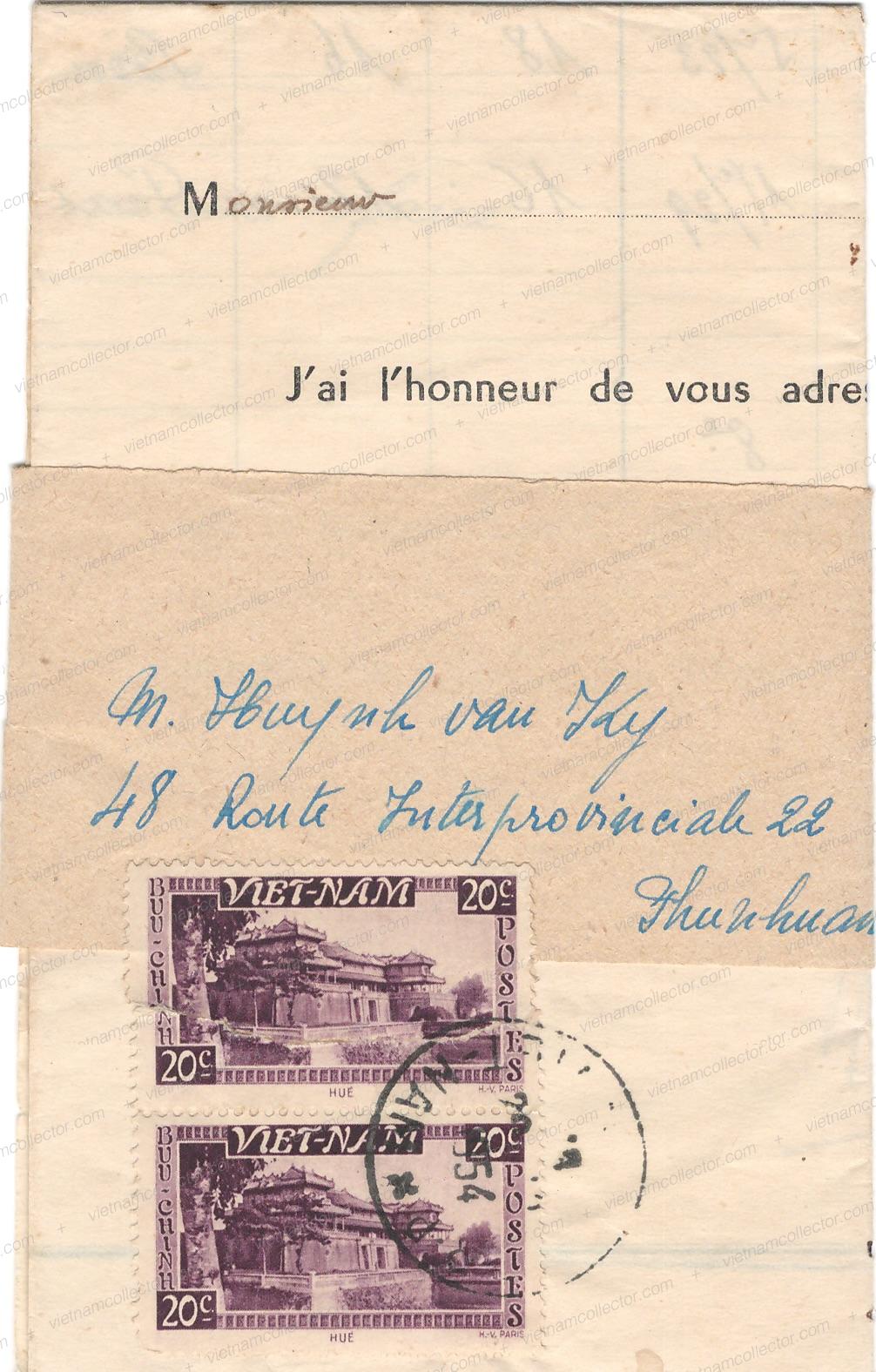
Mixed franking of two 60c Indochinese stamps together with the 30c Landscape value paying an overall postage of 1.50D on a domestic letter sent to Saigon. These mixed frankings were possible from June 6th, 1951 (when the first Vietnam stamps were issued) until April 1st, 1952, when all Indochinese stamps were declared invalid. The letter was assessed as deficient in postage and, unusually, a black “T” in a triangle was struck on all stamps and the envelope. There is no indication if the postage due was collected.
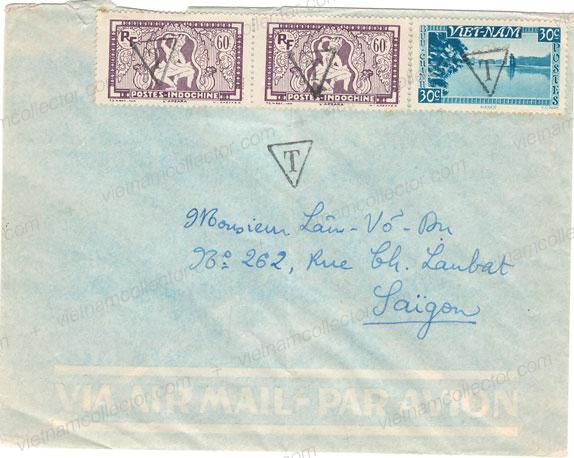
Mixed franking of the 30C, 1P and 2P values paying an overall postage of 3.30P on an international air mail letter sent from Hanoi to France in March of 1952. Black propaganda cachet reading “Celebration of Vietnamese Women’s Day”.
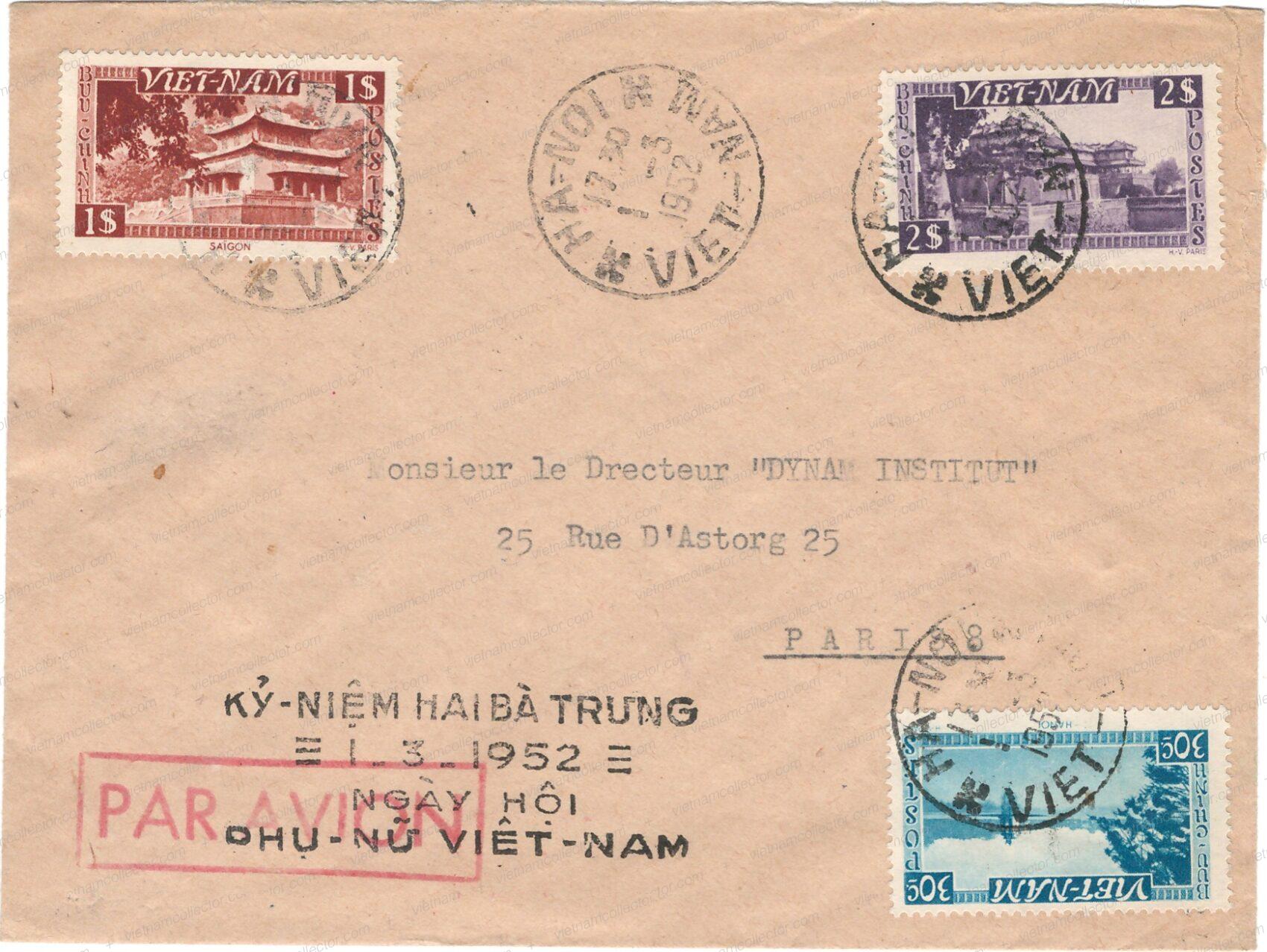
Mixed franking of one 10c, four 20c, one 30c, one 50c and one 2P Landscape values together with stamps from the Festival of seeking Souls and Nam Phu’o’ng sets paying an overall postage of 5P on an air mail letter sent from Saigon to France in June of 1953.
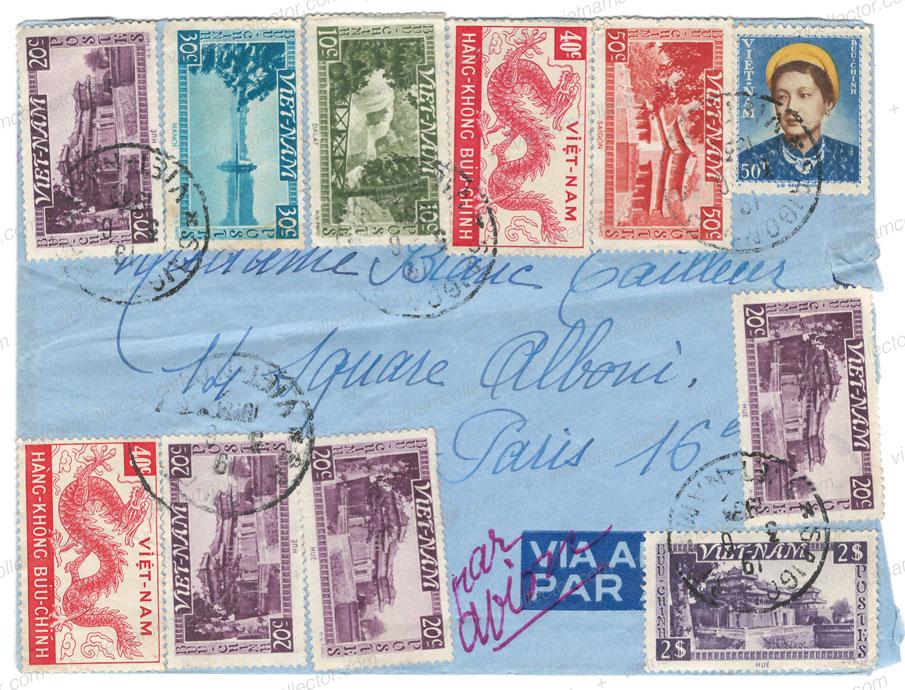
Printed Matter featuring the 10c and 30c Landscapes stamps paying an overall postage of 40c by a medical company in Saigon to France. Most printed matter mailings were thrown away so are now hard to find.
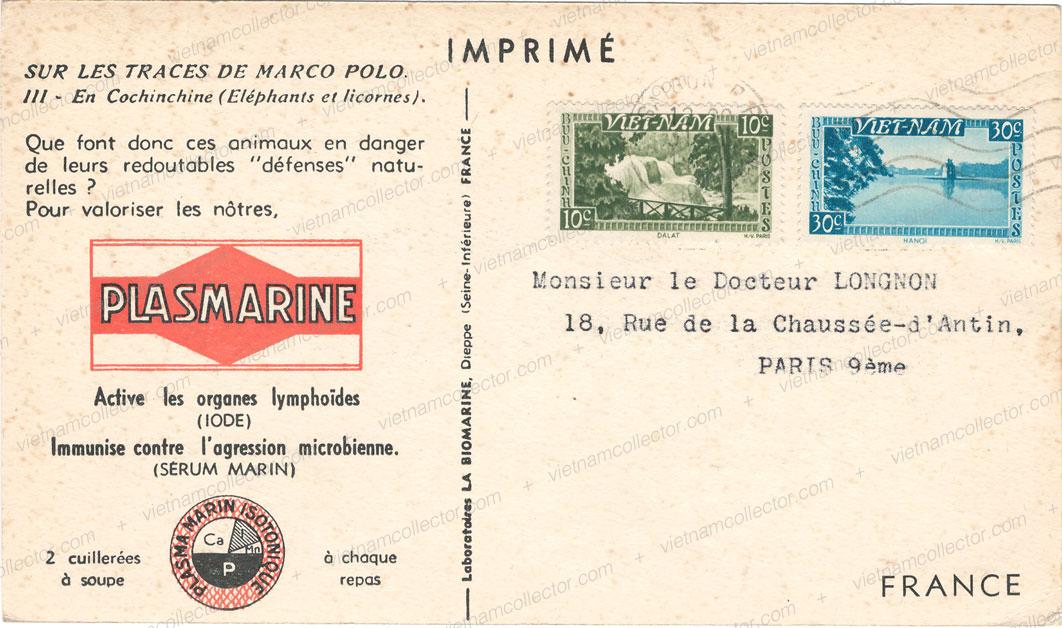
Rare multiple franking of the 30c value (5) paying an overall postage of 1.50P on a letter mailed within Saigon in January of 1952.
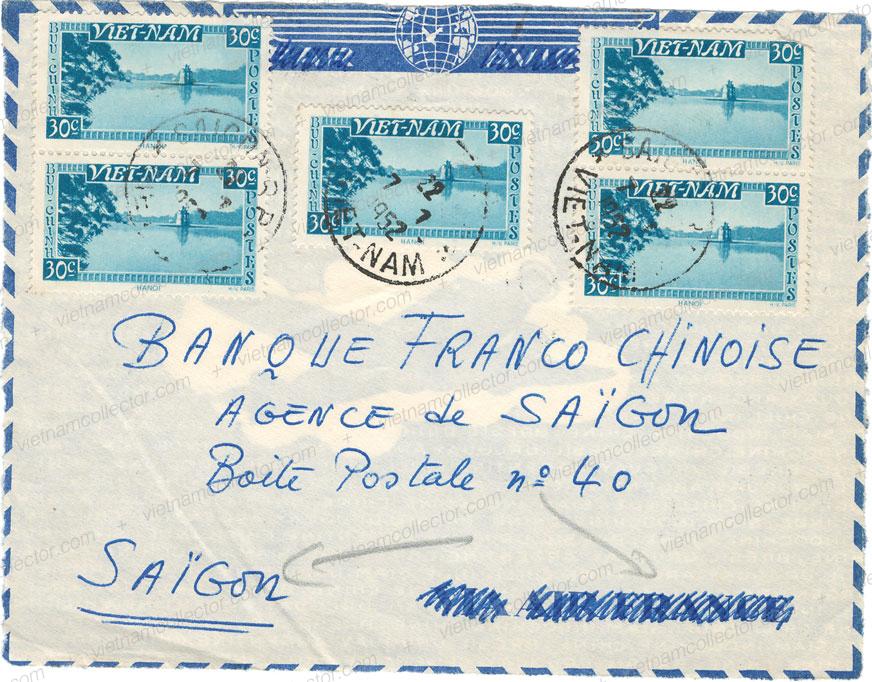
Here is the same franking but this time on a printed matter mailing sent from Chau Doc to France in January of 1952.
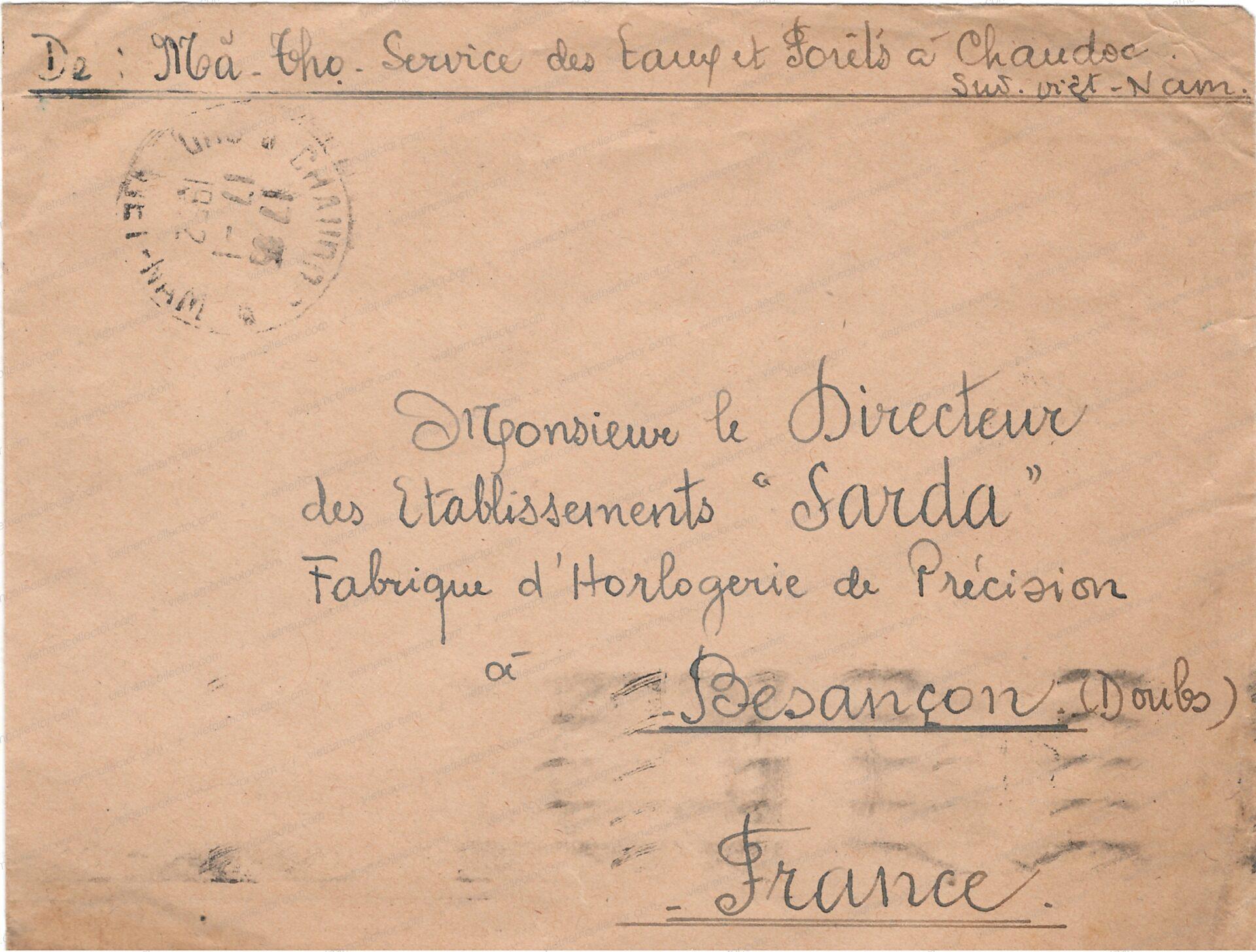
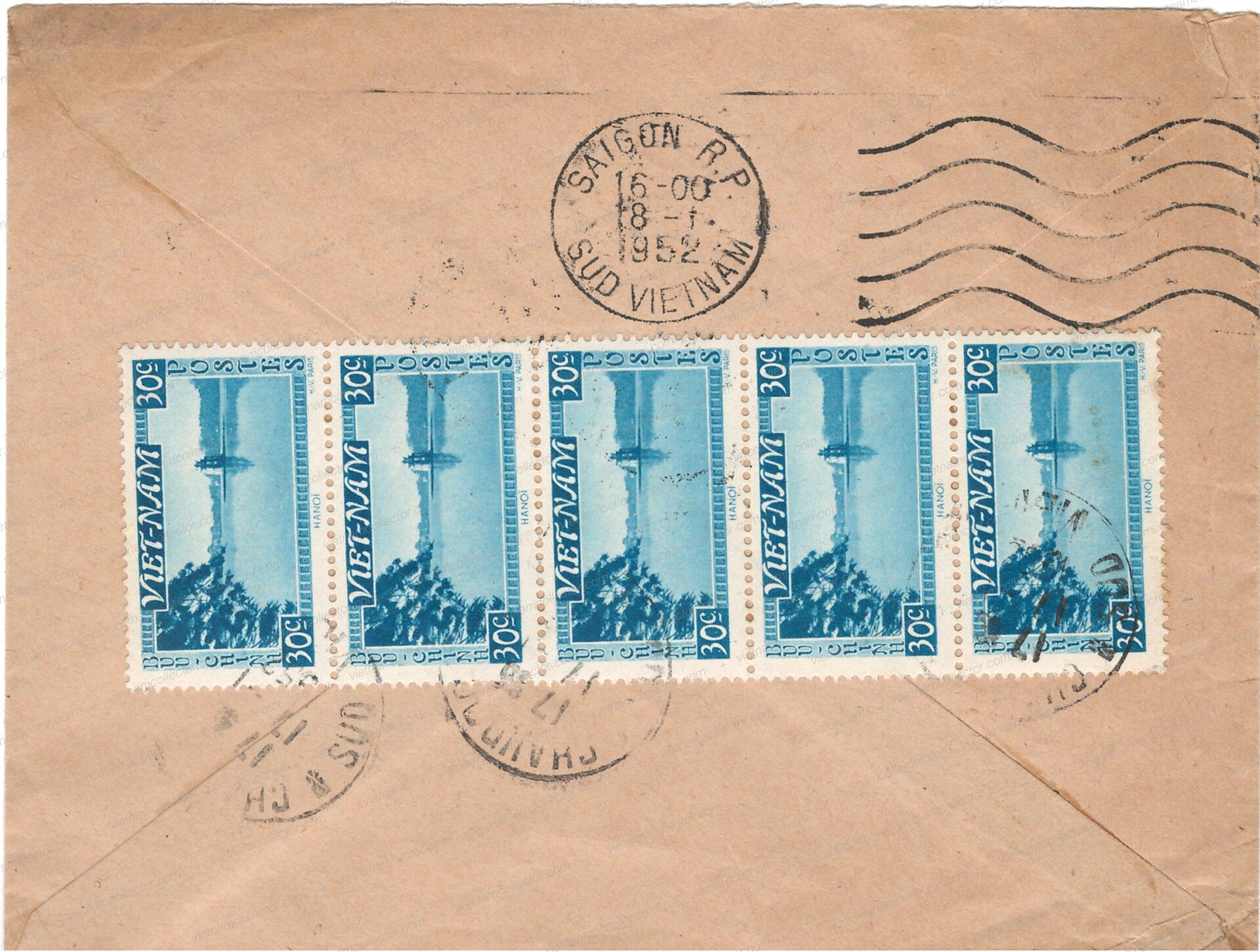
Rare multiple franking of the 50c value paying an overall postage of 1.50P on a local letter mailed within Saigon in March of 1952.
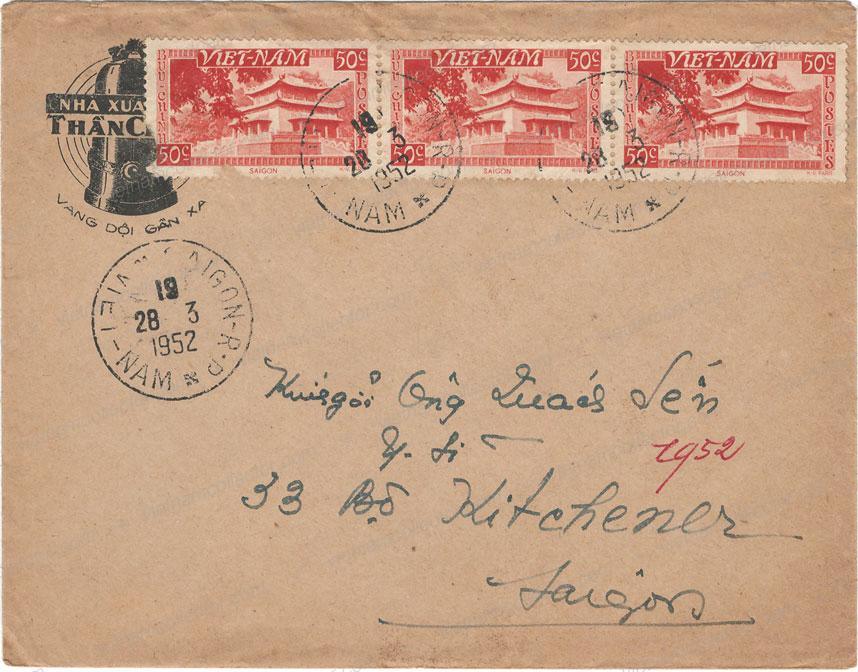
The 0.50P and 0.60P Landscape stamps were issued on August 16th, 1951. On occasion of the First Day of Issue these letters paying the regional postage of 1.20P were mailed from Saigon to Pnom Penh in Cambodia. First Day cachet on front. Not many of these intra-regional letters have survived.
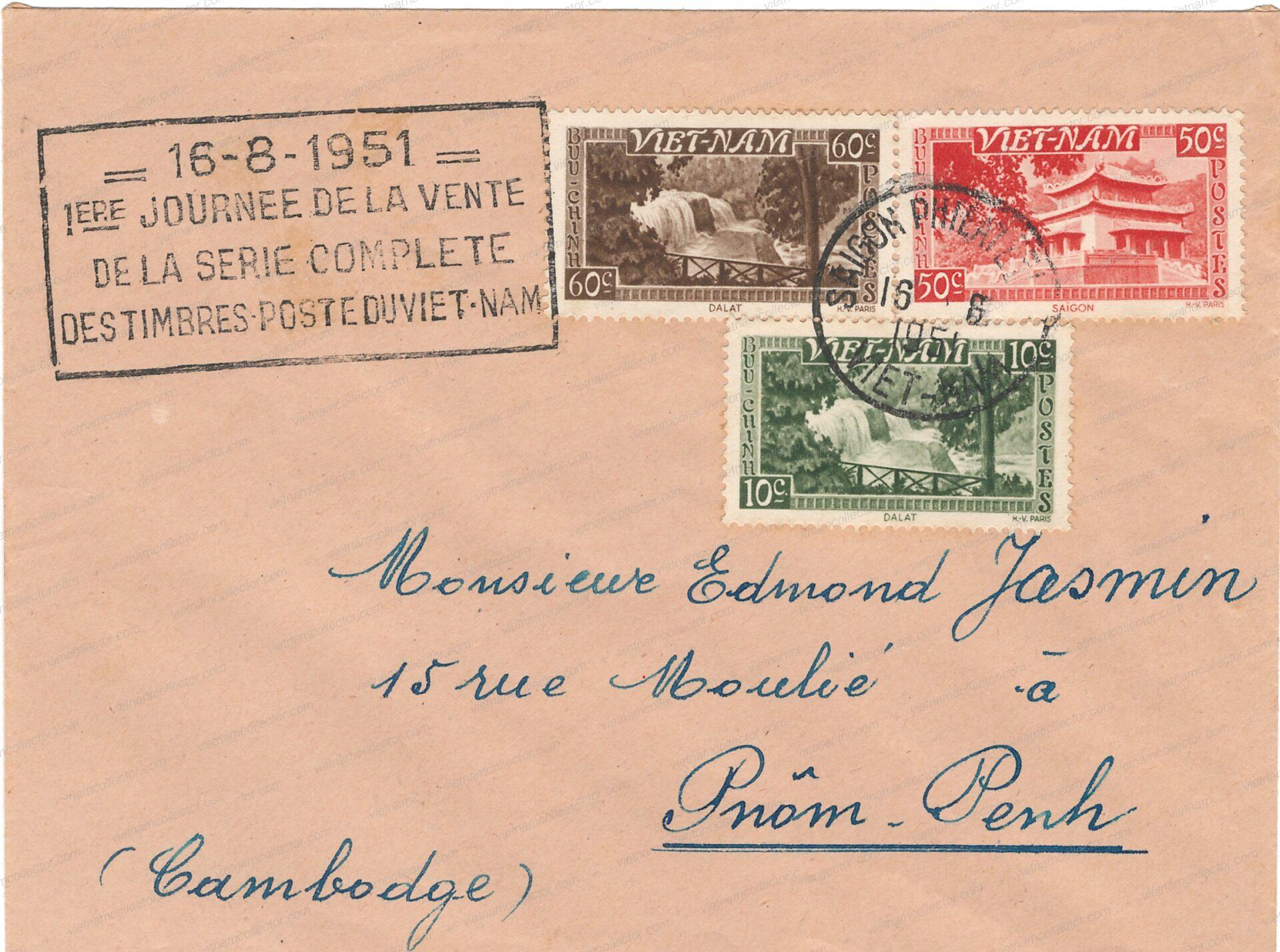
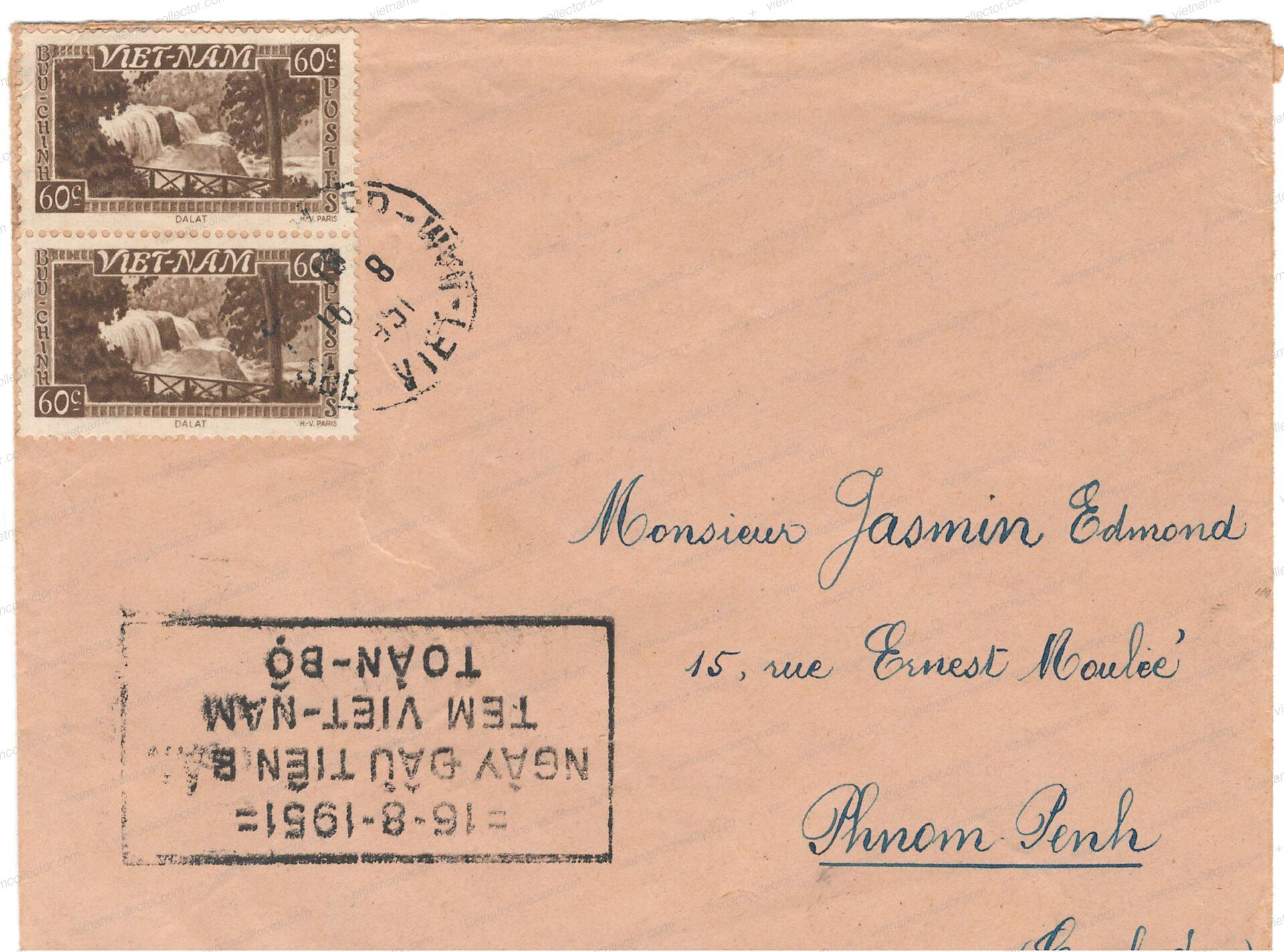
Multiple franking of the 60C value paying an overall postage of 1.20P on an international printed matter mailing and sent from Dallas to the United States in October of 1953.
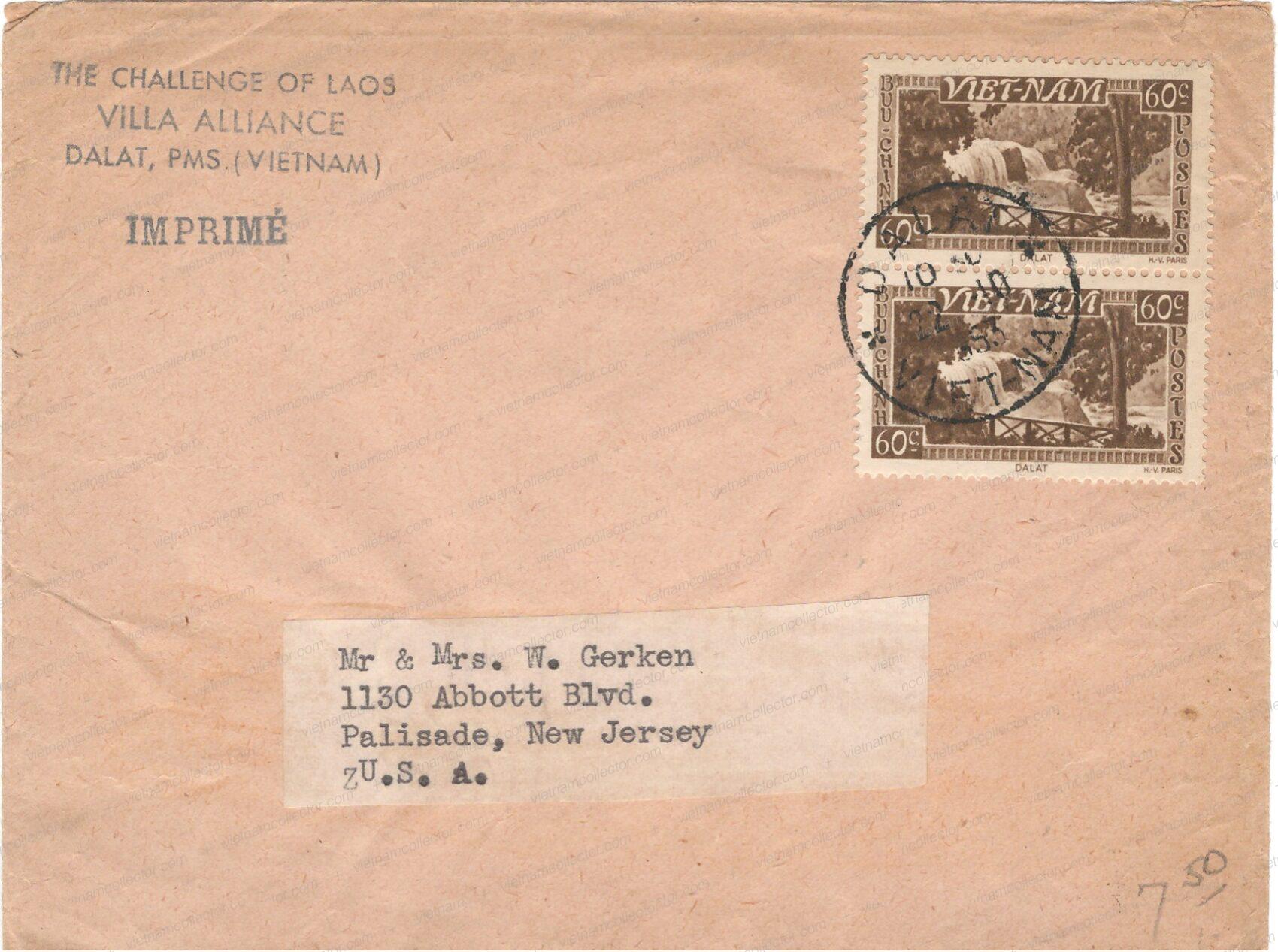
Rare single franking of the 1P value on a postcard sent by surface mail in November of 1952 from Saigon to France. Most letters were sent by airmail, so surface mail items are difficult to find. The card features a photograph of the Botanical Garden.
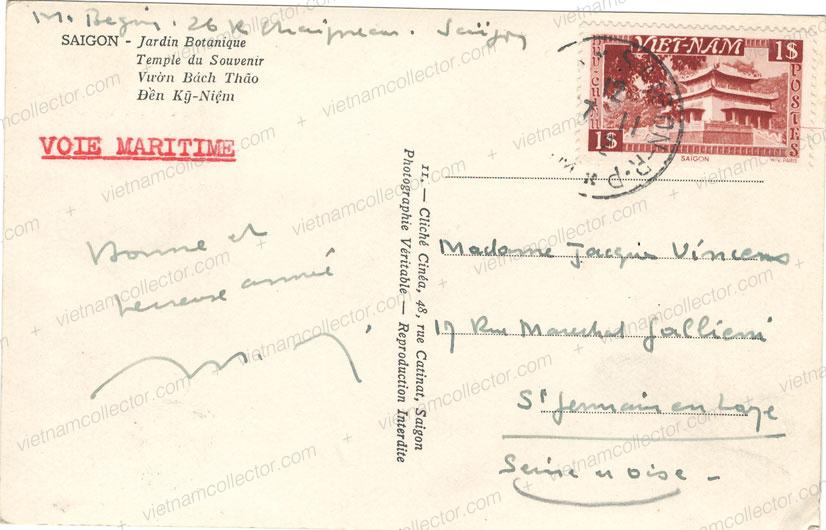
Mixed franking of the 1P (2) and 2P stamps paying an overall postage of 4P on an international surface letter sent from Hue to France in February of 1955.
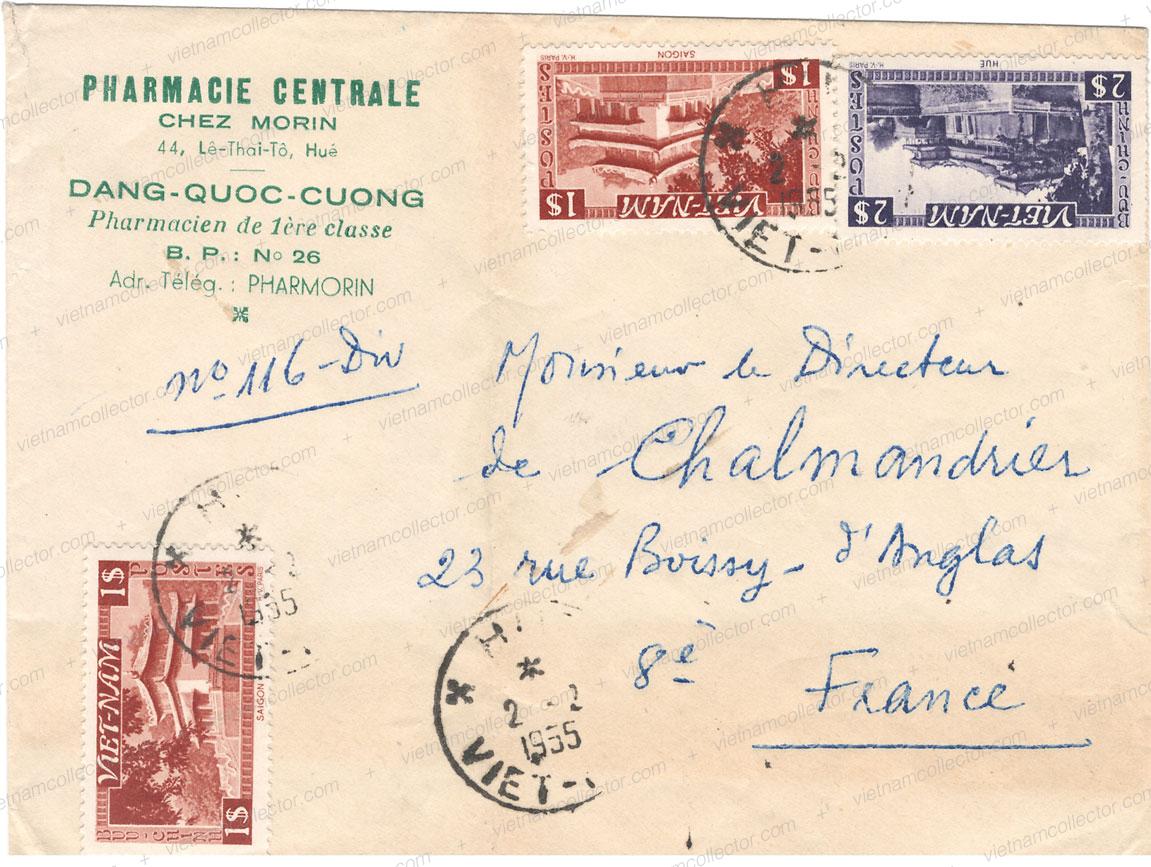
Mixed franking of the 1P value (3) together with two 1.50P Geneva Agreement stamps paying an overall postage of 6P on an air mail letter sent in August of 1958 from Saigon to Australia.
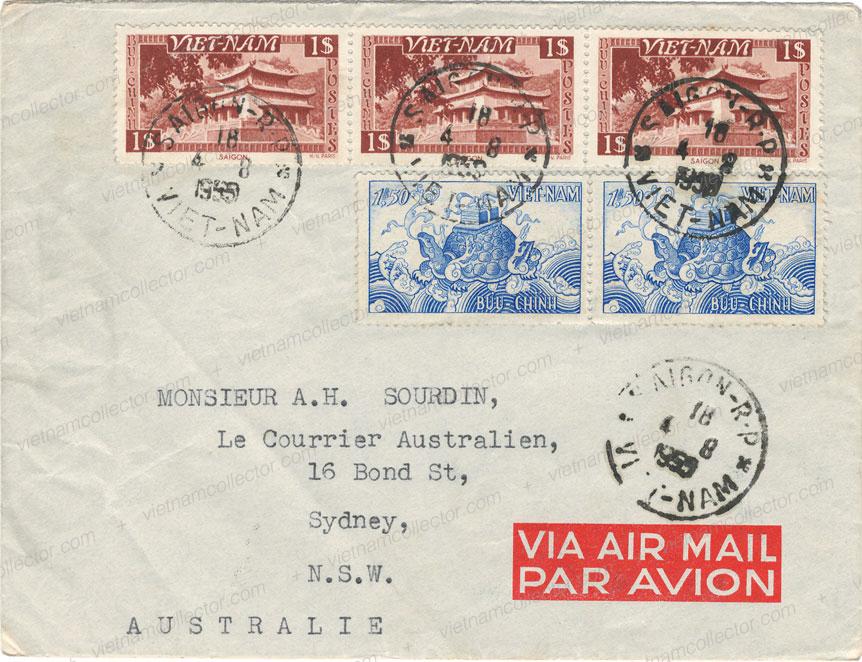
Mixed franking of a Indochinese stamp together with the 1P and 2P Landscape values paying an overall postage of 3.30P on an international letter sent in February of 1952 from Saigon to France. These mixed frankings were possible from June 6th, 1951 (when the first Vietnam stamps were issued) until April 1st, 1952, when all Indochinese stamps were declared invalid.
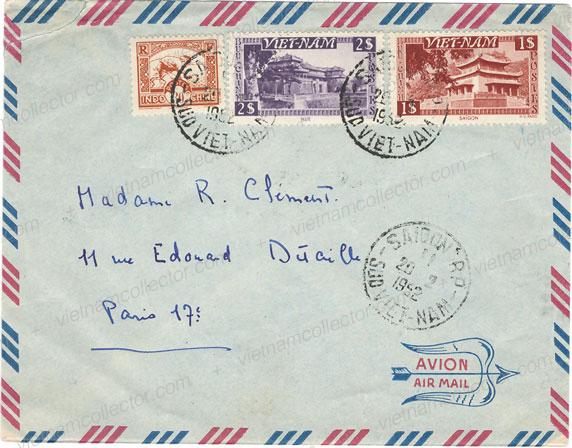
Mixed franking of featuring four of the 1P and one 50c Landscapes stamp pa<ing an overall postage of 4.50P on a registered letter (full contents preserved) sent from Hai Phong to Cholon in May of 1952. Apparently the recipient had moved on and hence the postal clerk applied two different “Return to Sender” cachets in black on the letter and on a piece of paper that he/she glued onto the side of the envelope. The paper shows the senders address to which the letter was returned. Saigon transfer cancels on the reverse.
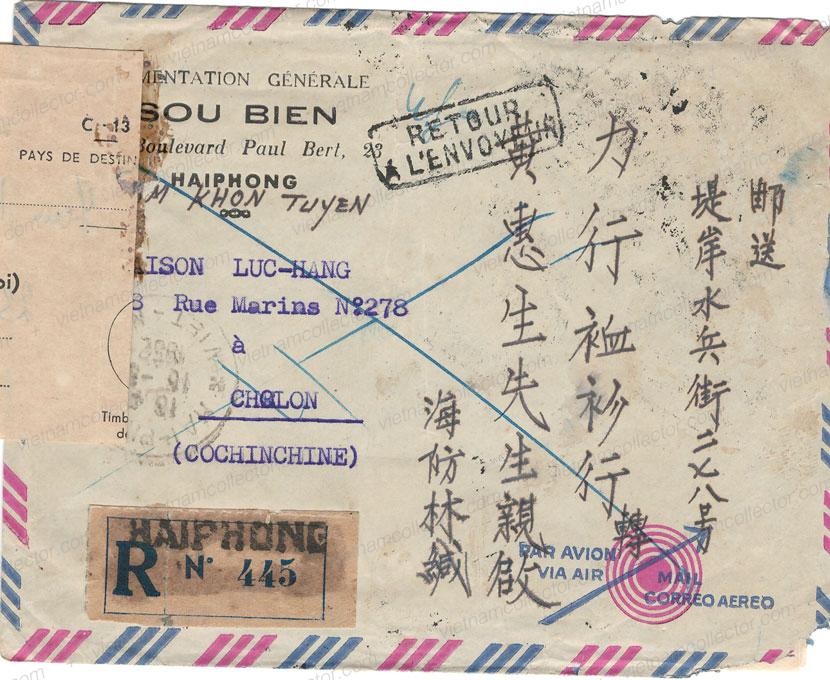
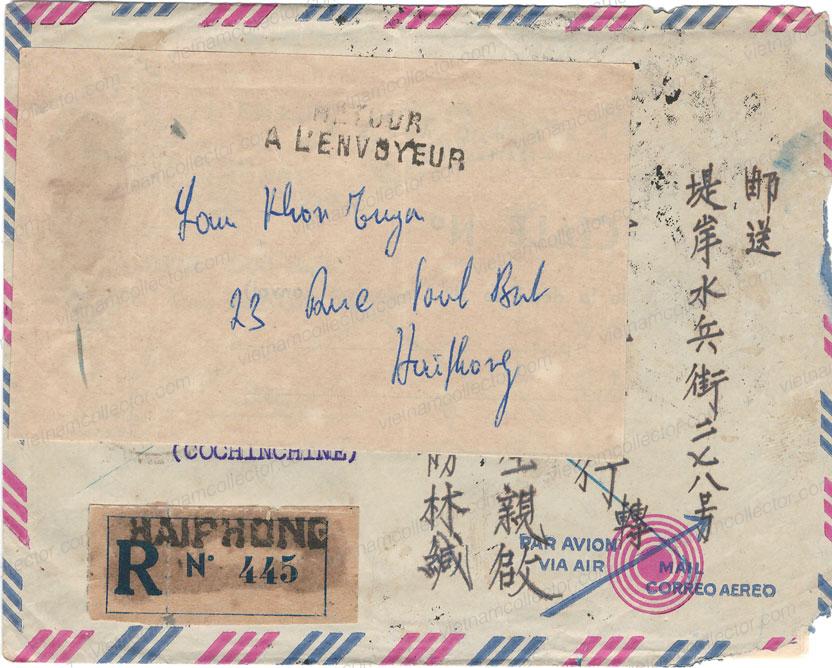
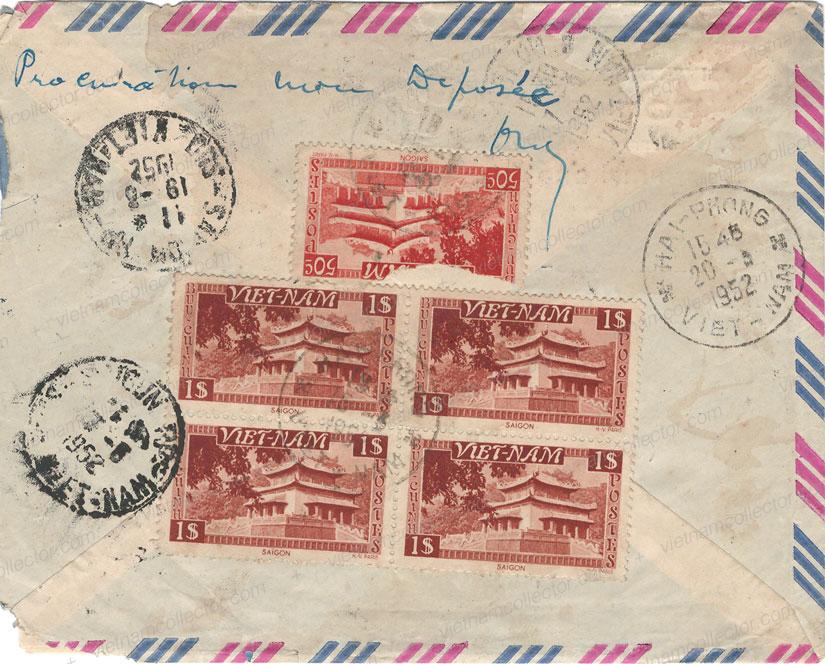
Rare usage of the 1P value (2) together with the 50c Nam Phu’o’ong stamp paying a fee of 2.50P on a money order over 5,000P sent to Can Tho in June of 1954.
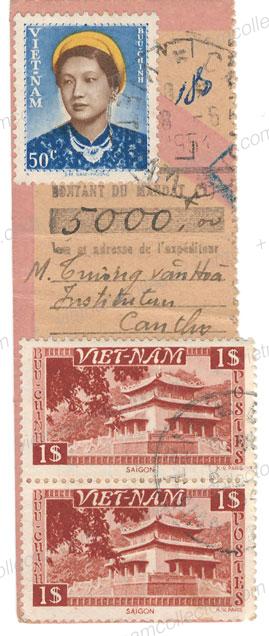
Mixed franking of one 50c and three 1P values paying an overall postage of 3.50P on an international air mail letter sent from Hanoi to France in March of 1952.
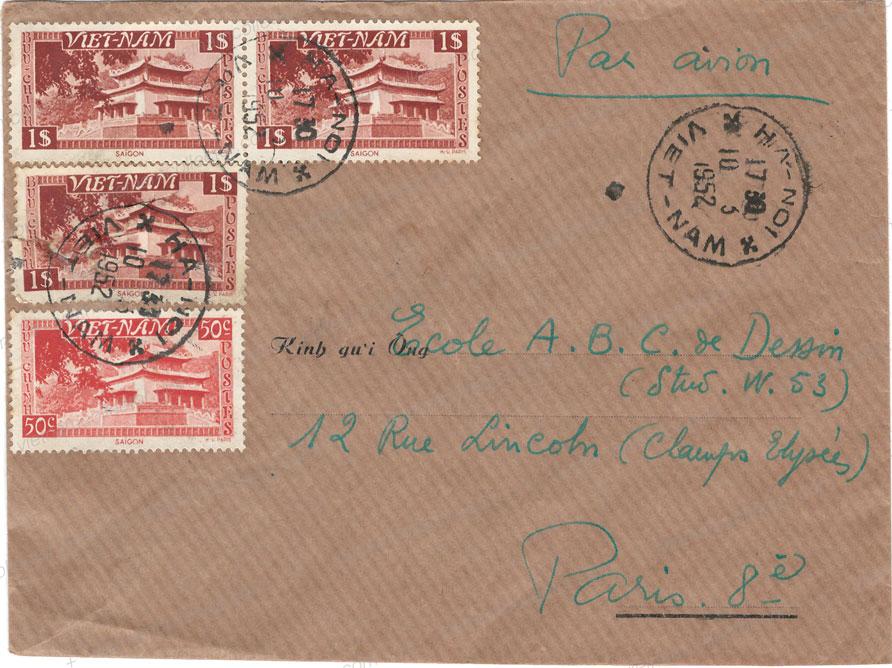
Rare multiple franking of the 1P value (7) paying an overall postage of 7P on an international air mail letter sent from Hue to England in February of 1954.
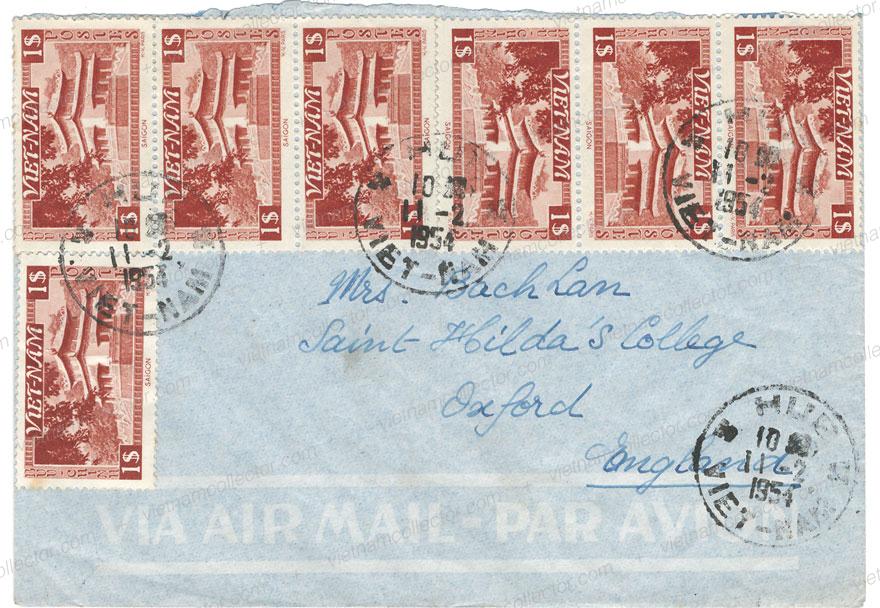
Rare multiple franking of the 1P value (5) paying an overall postage of 5P on an international air mail letter sent from Hue in April of 1954 to France.
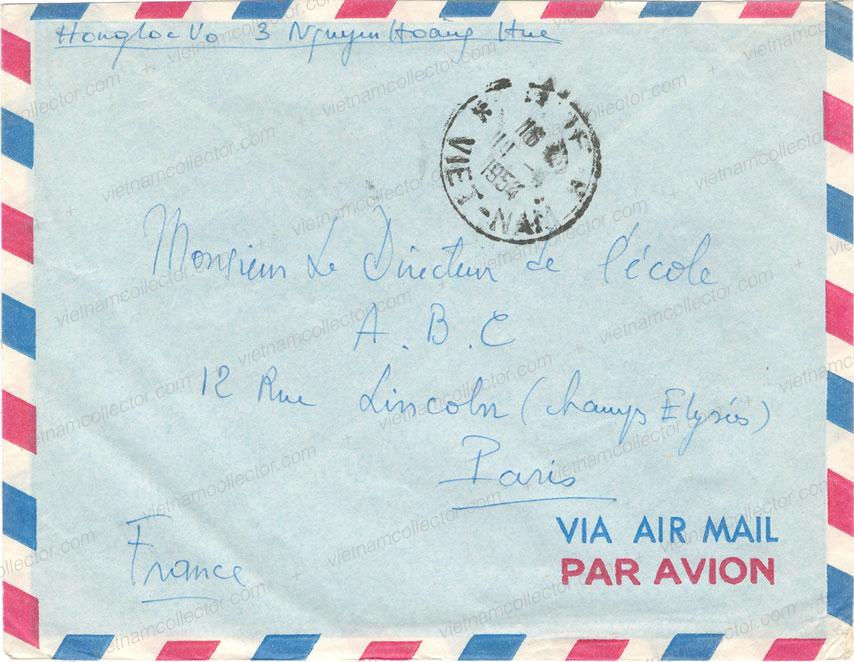
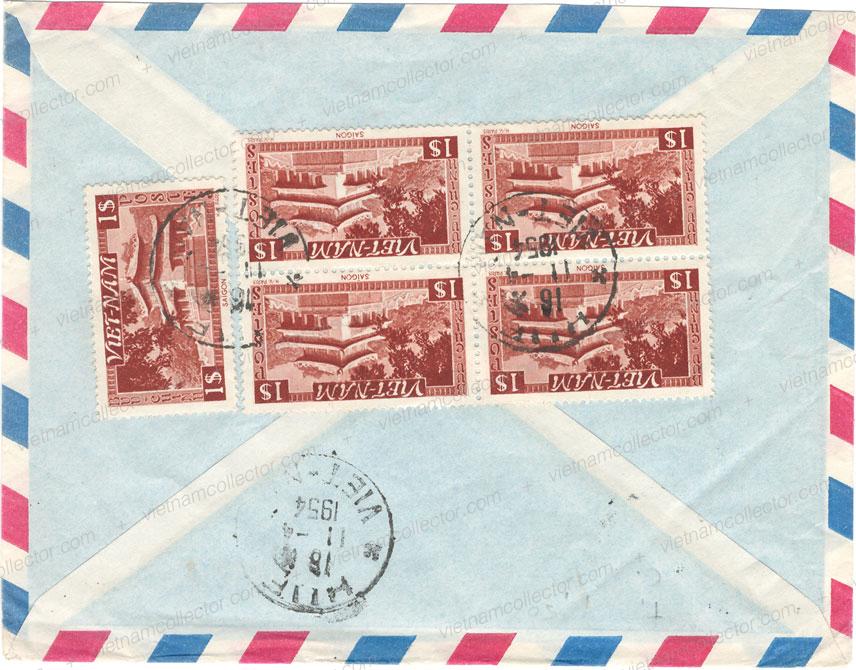
Multiple franking of the 1P value (2) paying an overall postage off 2P on a domestic air mail letter sent in Nha Trang in May of 1955.
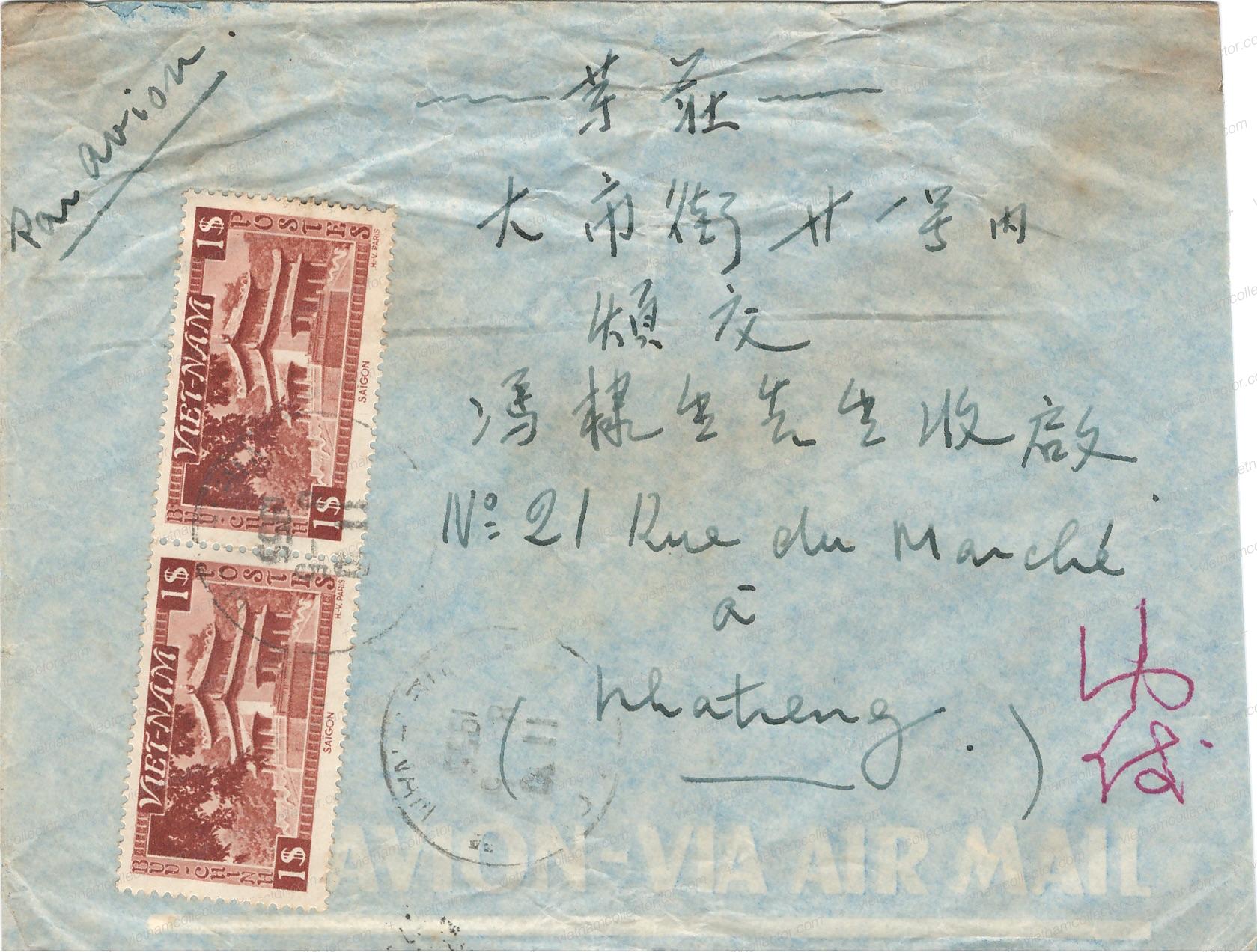
Rare single franking of the 1.20P stamp an international air mail letter sent from Saigon to India in May of 1952. Indian transit and arrival cancels on the reverse.
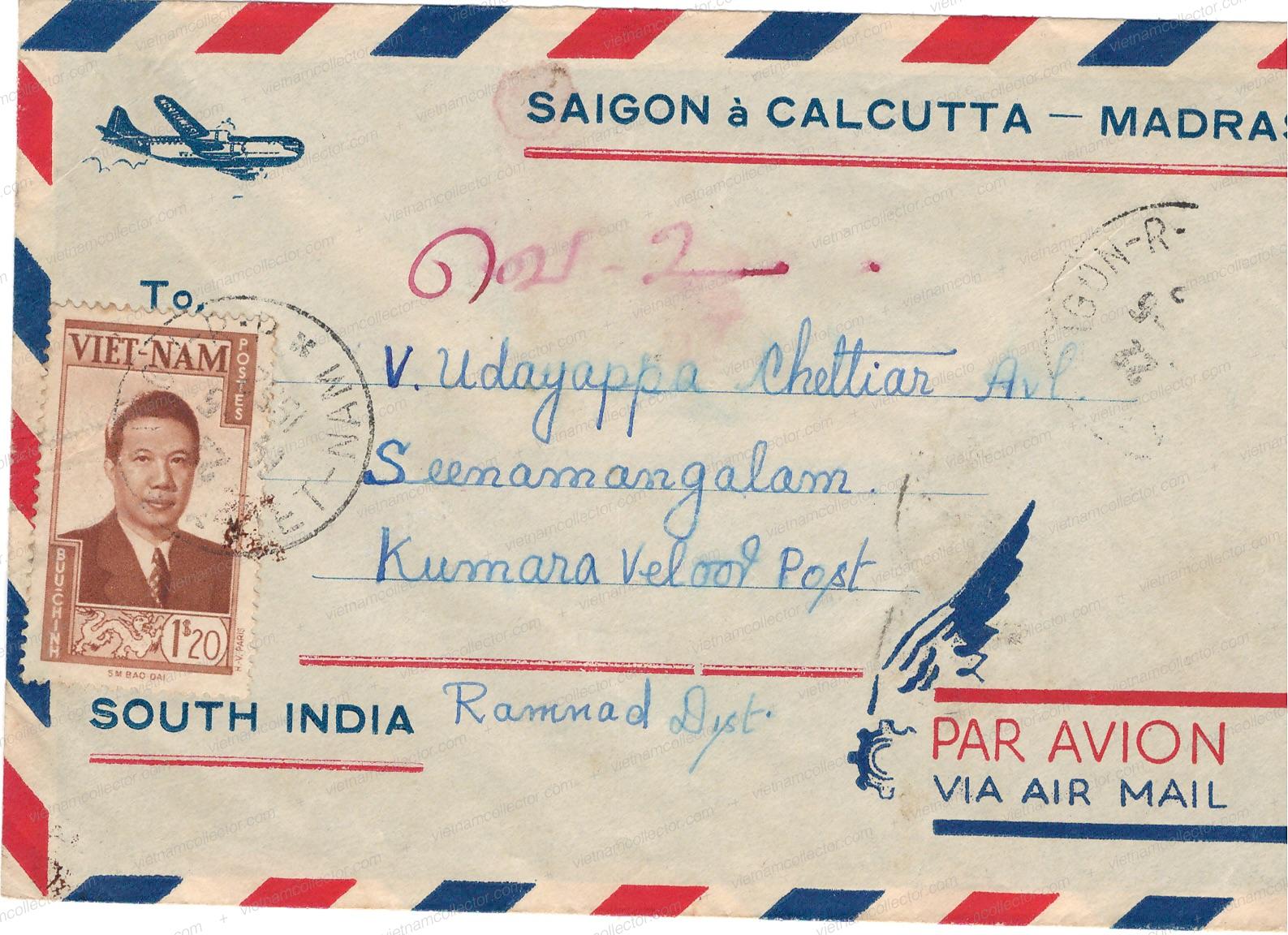
Rare usage of the 60c and 1.20P value on a money order transferring 5,000P to Can Tho in July 1954.

Rare censored letter featuring the 1.20 Bao Dai and some Landscape stamps from the same set paying an overall postage of 3.70D on an international air mail letter sent from Saigon to Austria in March of 1952. Incoming mail to Austria was censored almost until the countries independence in 1955.
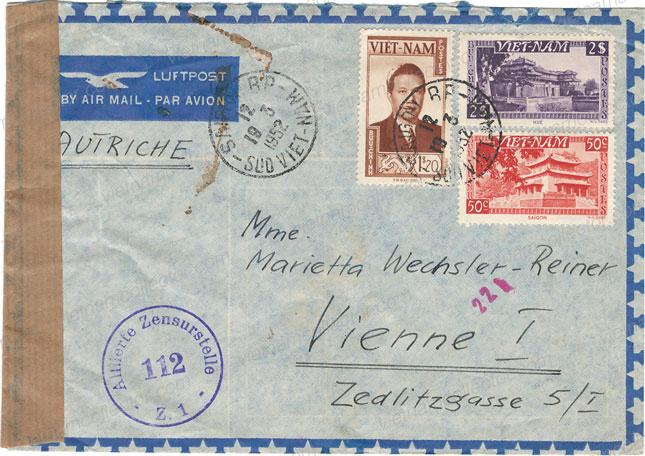
Mixed franking mailed from the United States Operations Mission (USOM) located at the American embassy and in charge of special operations franked with two 1.20P Bảo Đại stamps together with the 6.30P Air Mail stamp paying an overall postage of 8.70P on an air mail letter sent from Saigon to the United States in May of 1954.

Mixed franking mailed from the United States Operations Mission (USOM) located at the American embassy and in charge of special operations franked with the 1P and 1.20P stamps plus the 6.30P Air Mail stamp paying an overall postage of 8.50P on an air mail letter to the United States in February of 1954.

Mixed franking of the 1P and 2P Landscape stamps paying an overall postage of 4P on an international air mail letter sent from Hai Phong to France in February of 1955. The addressee of the letter however, apparently had moved from France to Germany. The new address was written on the letter and a 15 FF stamp was attached to pay for the international postage from France to Germany. Savere arrival cancels on the reverse.
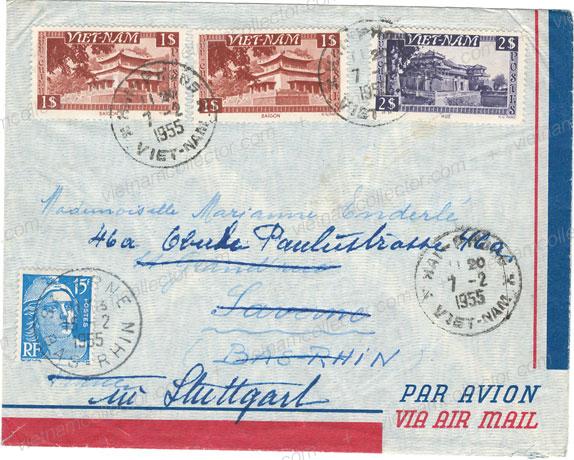
Mixed franking of the 20c (2) and 2P Landscapes values together with two 3.30 Air Mail Stamps paying an overall postage of 9P on a registered air mail letter sent from Cholon to Switzerland in October of 1952. Weisslingen arrival cancel on the reverse.

Mixed franking of the 50c and 2P Landscape stamps together with the 4P Air Mail stamp paying an overall postage of 6.50P on an international air mail letter sent from Saigon to Switzerland in October of 1955.

Mixed franking of the 10c and 2P Landscape (2) values together with the 1.50P Nam Phu’o’ong stamp paying an overall postage of 5.60P on an international air mail letter sent from Saigon to West Germany in 1953

Rare surface letter featuring three of there 2P Landscapes and one 1.50P Geneva Agreement stamps paying an overall postage of 7.50P on a registered international mailing from Saigon to England. Upon arrival the letter was officially opened by Customs and Currency Examination in order to search it for possible contraband. Resealed with official customs sticker and green custom stamps. Unusual.
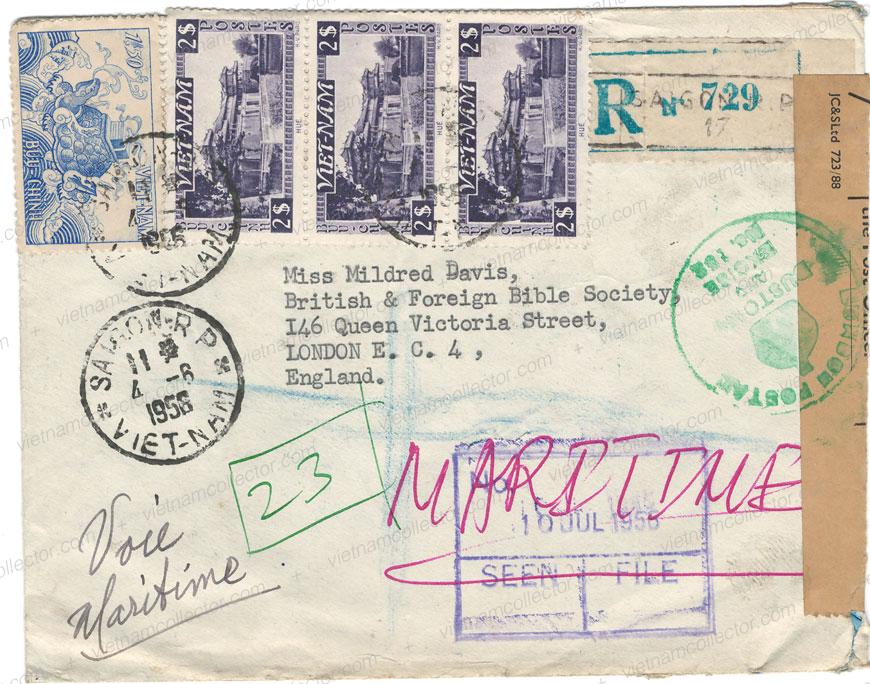
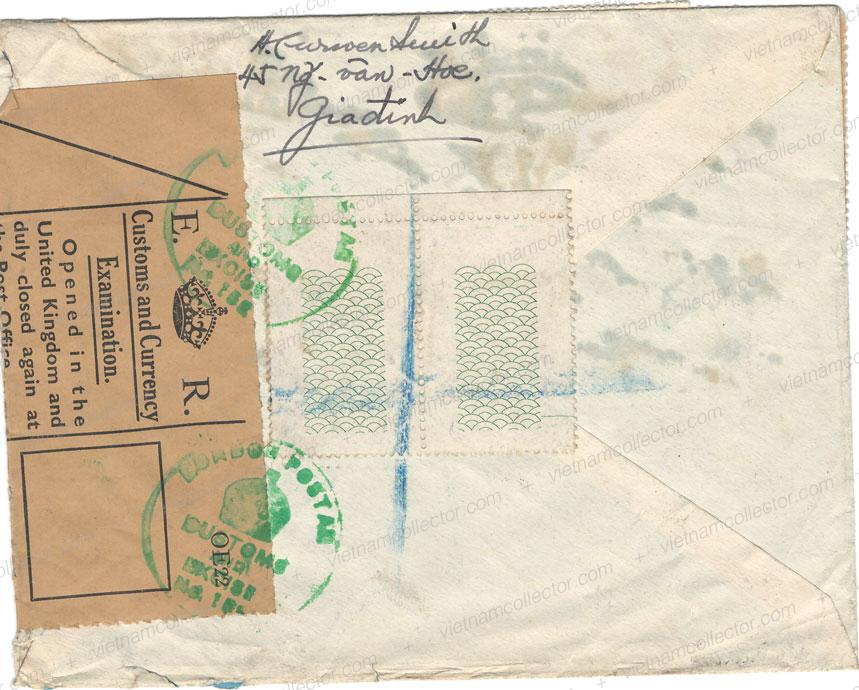
Letter front with a mixed franking of the 10c and 2P Landscape stamps together with the 40c Bao Long and 4P Air Mail stamp paying an overall postage of 6.50P in July of 1954.

Multiple franking of the 2P value (2) paying an overall postage of 4P on an air mail letter sent from Dalat to France in August of 1953.

Multiple franking of the 2P value (2) on an international air mail letter sent from Saigon to France in November of 1954.

Multiple franking of the 2P Landscape stamps paying an overall postage of 8P on a registered air mail letter sent from Saigon to Levallois-Perret in France in May of 1956. Levallois -Perret arrival cancel on the reverse.
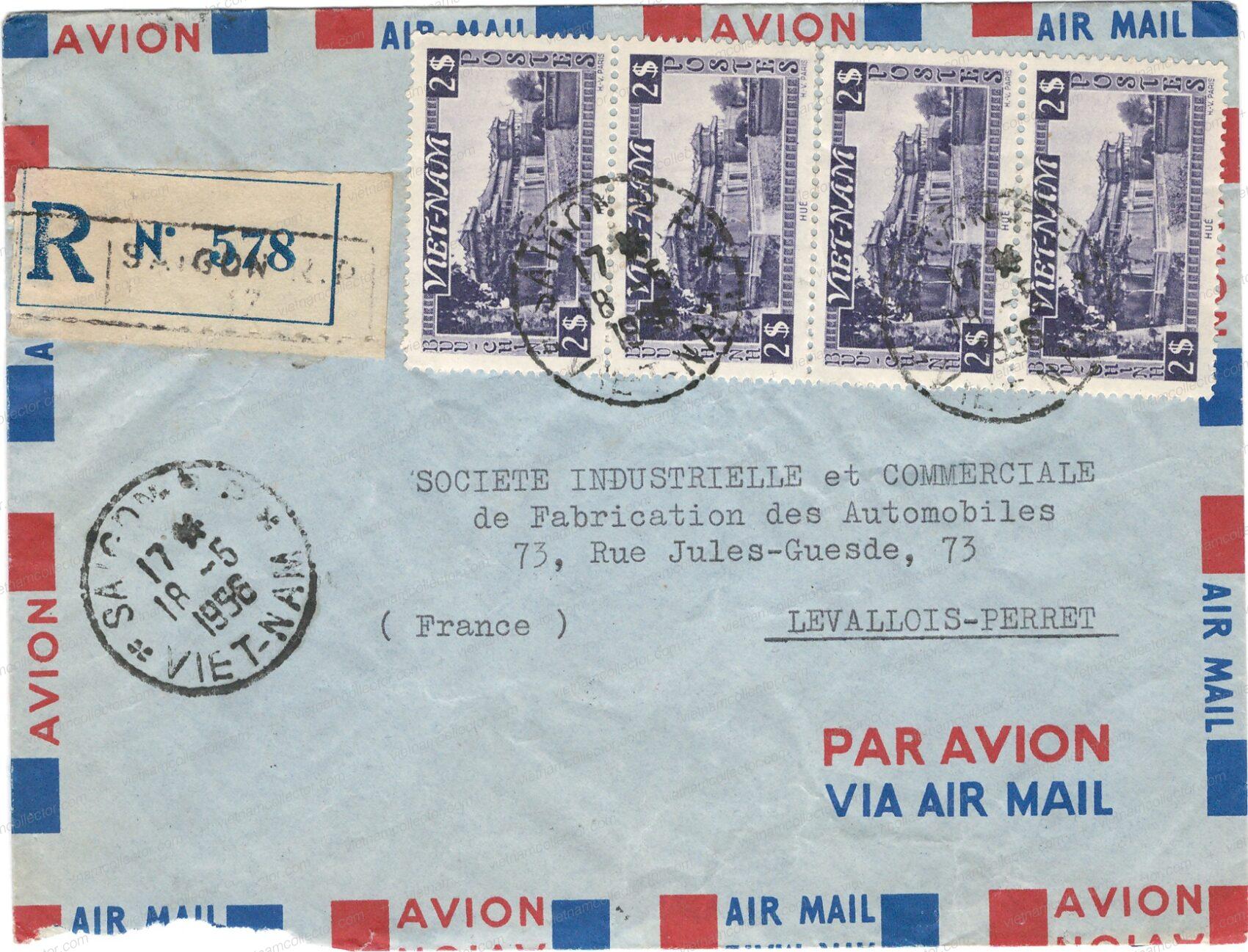
Mixed franking of the 50C Landscapes value together with two 2P Landscapes stamps paying an overall postage of 4.50P on diplomatic mail sent by the Foreign Service at the American Embassy in Saigon to the United States. These letter were transported by diplomatic pouch but had to be franked with Vietnamese stamps as the Government had mail supremacy. The letters received a violet hand stamp stating “This article originally mailed in country indicated by postage” and were cancelled upon arrival in the recipient country (in this case Washington D.C.).
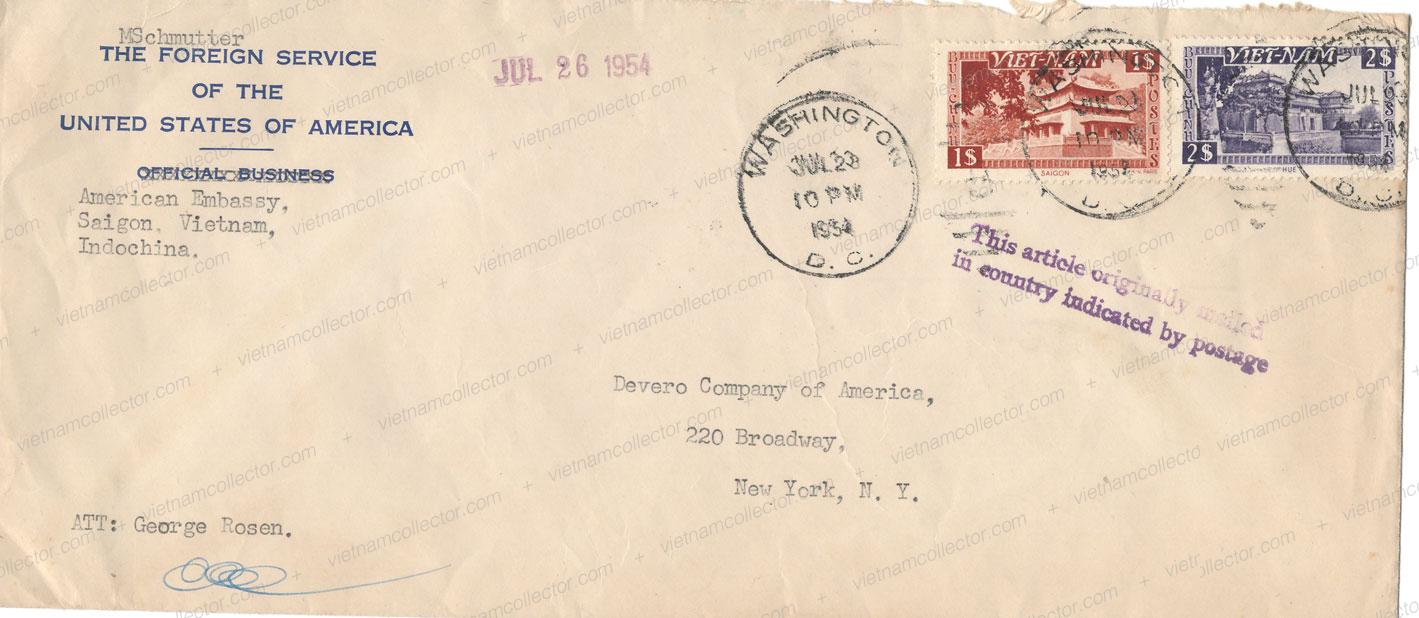
Mixed franking of the 2P value (3) together with the 40c Festival of Searching Soul stamps paying an overall postage of 6.40P.

Mixed franking of two 20c and one 2P Landscape stamps together with the 4P Air Mail stamp paying an overall postage of 6.40 on an international air mail letter sent from Hai Duong to West Germany in April of 1954.
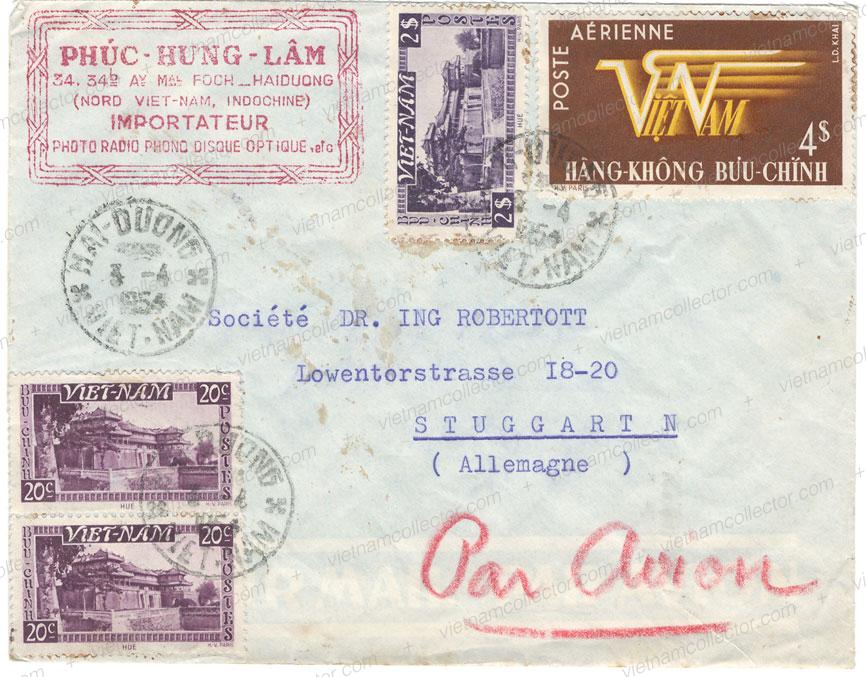
Rare single franking of the 3P value on an international surface letter sent from Nha Trang to France in July of 1951.
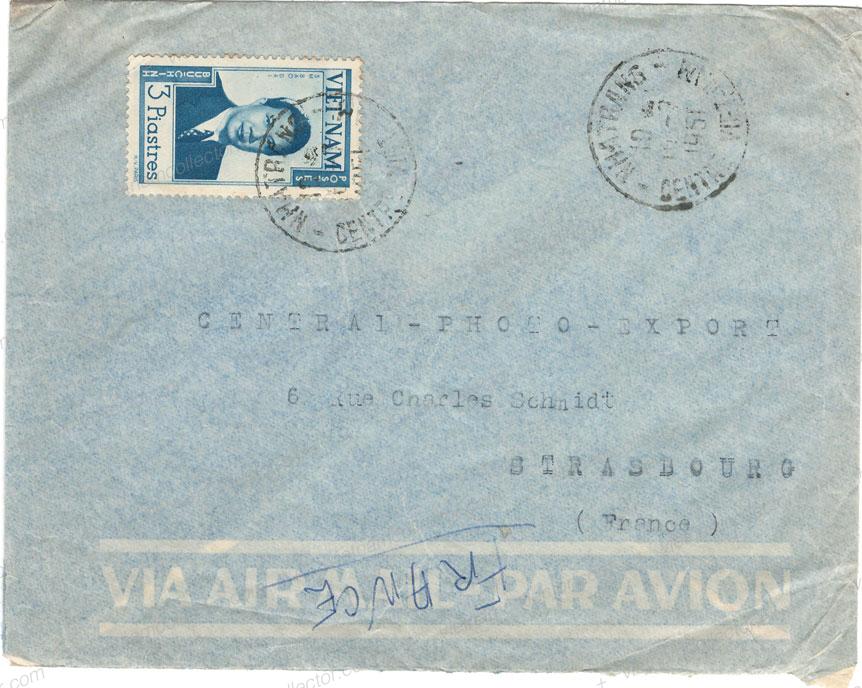
Very rare gutter pair franking of the 3D Bao Dai stamps together with Landscape and Wandering Soul stamps from the same set paying an overall postage of 13.20D on an international letter sent from Saigon to Italy in November of 1954.
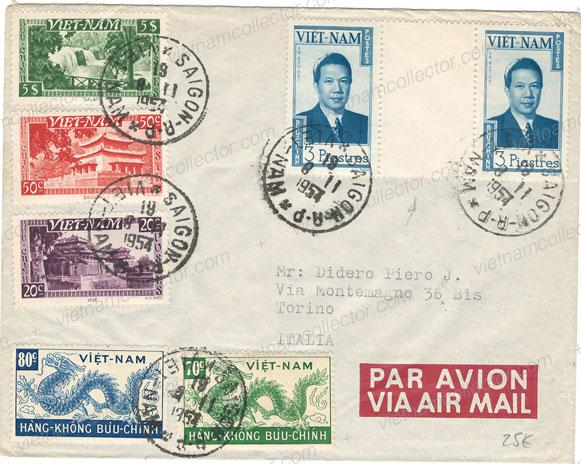
Single franking of the 3P value on diplomatic mail sent by the Foreign Service at the American Embassy in Saigon to the United States. These letter were transported by diplomatic pouch but had to be franked with Vietnamese stamps as the Government had mail supremacy. The letters received a violet hand stamp stating “This article originally mailed in country indicated by postage” and were cancelled upon arrival in the recipient country (in this case Washington D.C.).
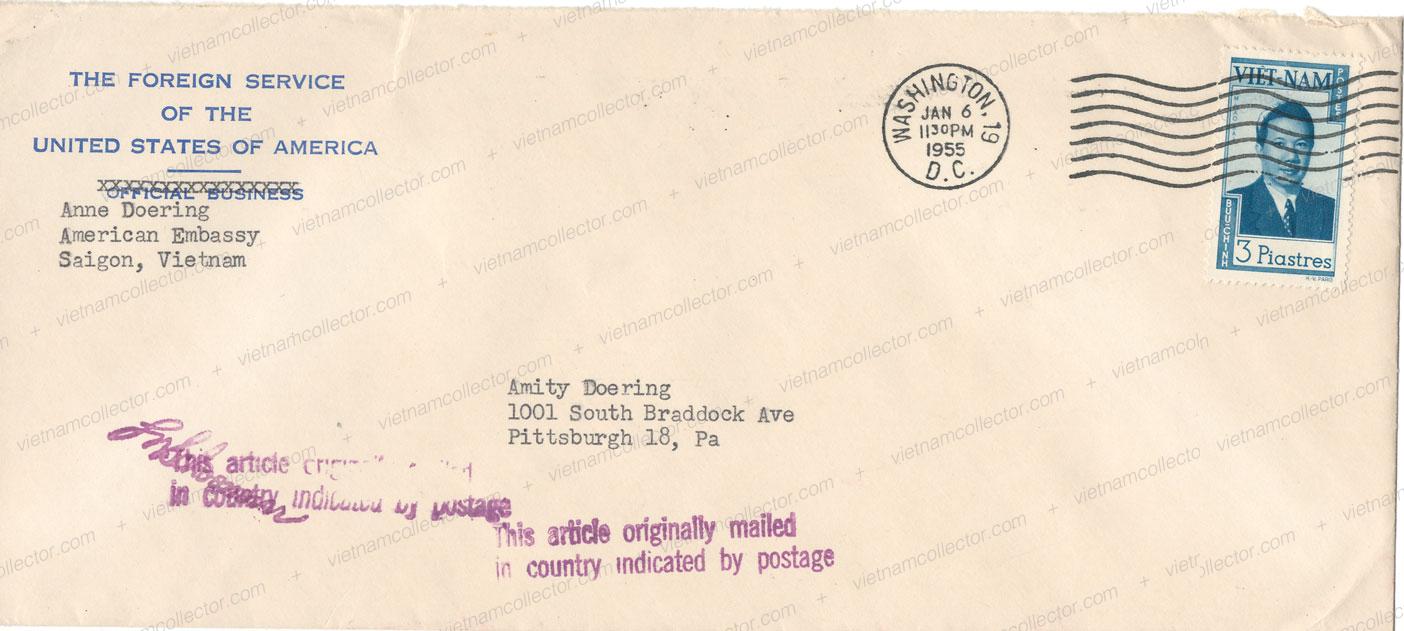
Here is similar pouch mail but this time franked with three 3P stamps paying 9P cancelled with the Washington D.C. machine cancel.
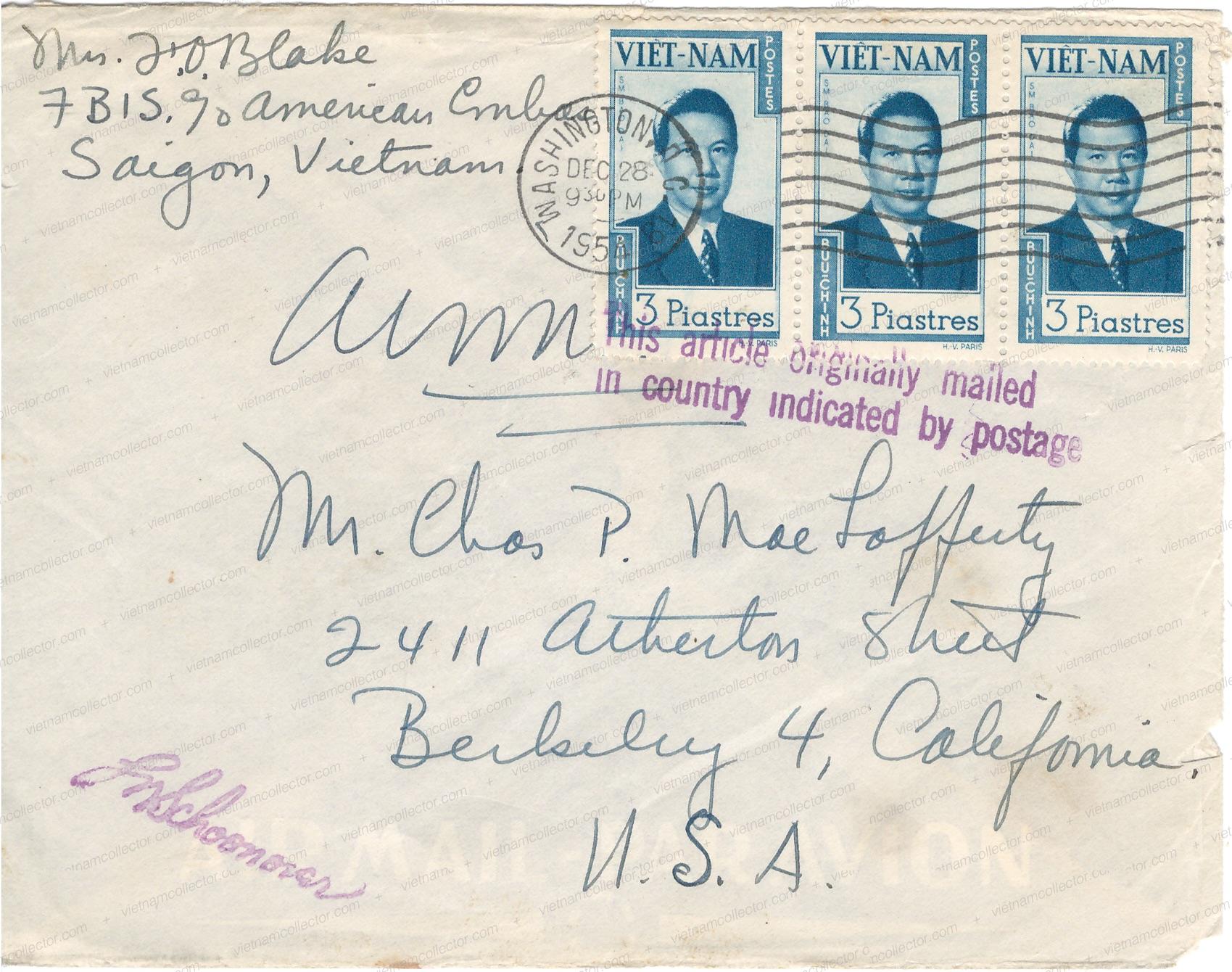
Mixed franking of the 3P Bao Dai stamp together with the 3.30P Air Mail stamp paying an overall postage of 6.30P on a registered international letter sent from Hanoi to France in March of 1952. In 1952 the Viet Minh were in charge of most of rural North Vietnam but the cities were still held by the French. Paris arrival cancel on the reverse.
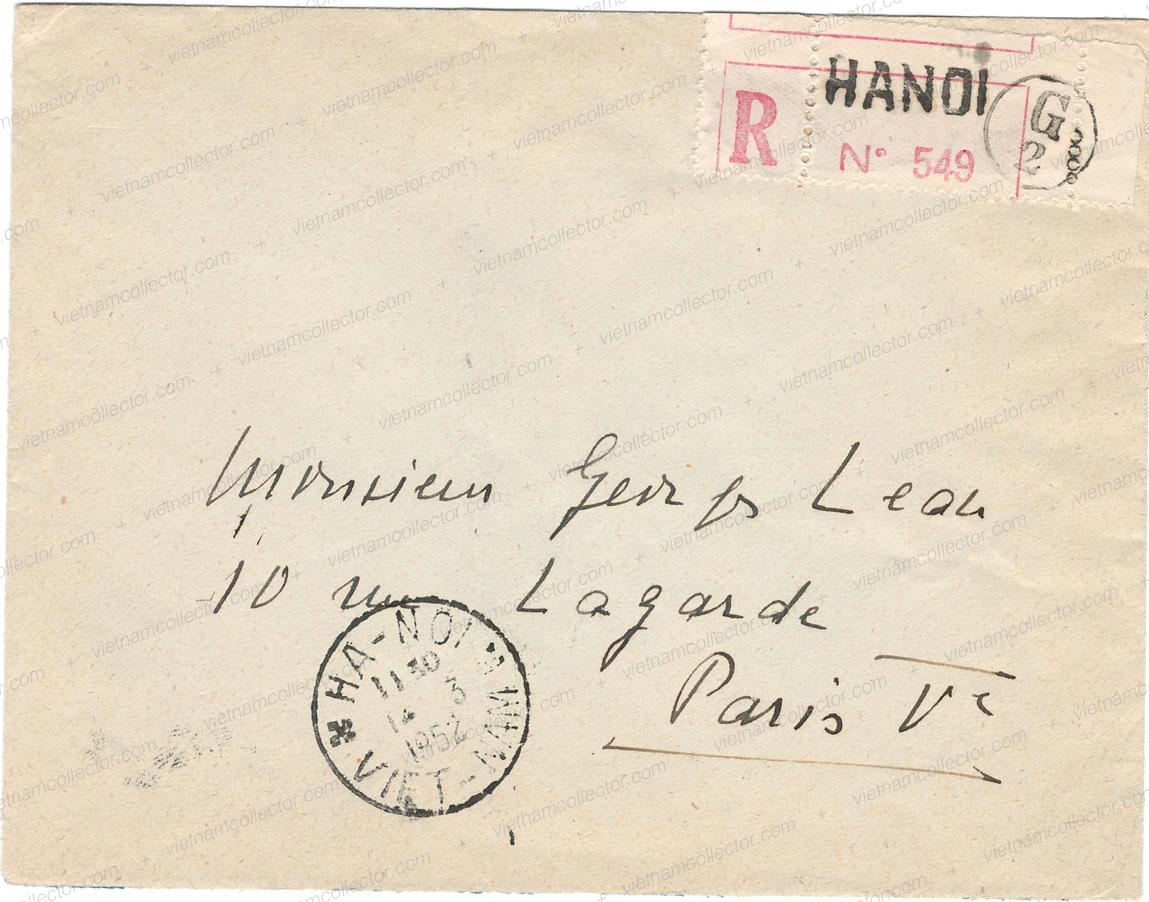
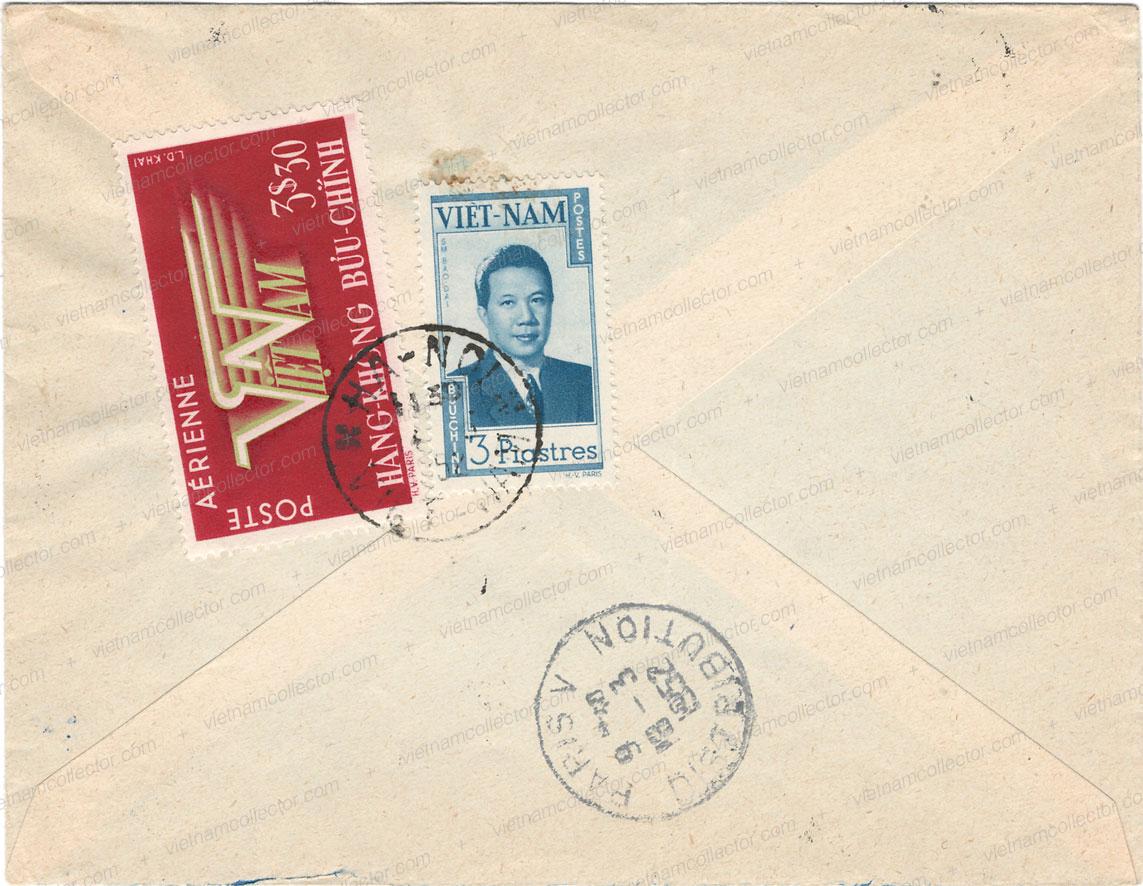
Mixed franking of the 3P value (2) together with the 50C Nam Phuong stamps (2) paying an overall postage of 7P on an international registered letter sent from Hanoi to France. Javron arrival cancel on the reverse.
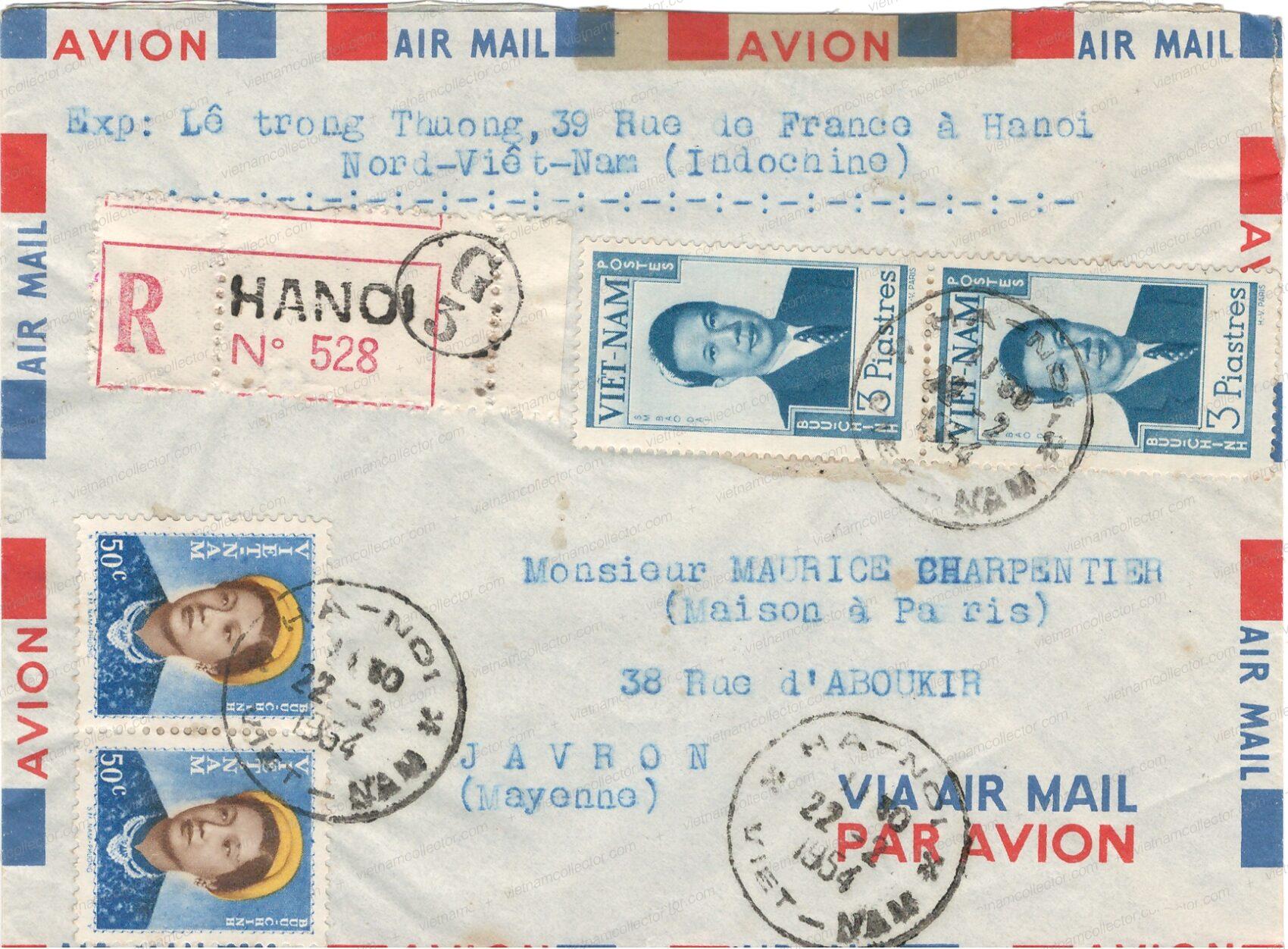
Mixed franking of Indochinese stamps together with the 3P Bao Dai values paying an overall postage of 8.10P on an international registered letter sent in November of 1951 by a member of the French military from Hanoi to France. Manuscript “FM (Franchise Militaire)” applied on front. These mixed frankings were possible from June 6th, 1951 (when the first Vietnam stamps were issued) until April 1st, 1952, when all Indochinese stamps were declared invalid. The letter is cancelled with the rare octagonal “Hanoi C ” cancel. Strassbourg arrival cancels on the reverse.
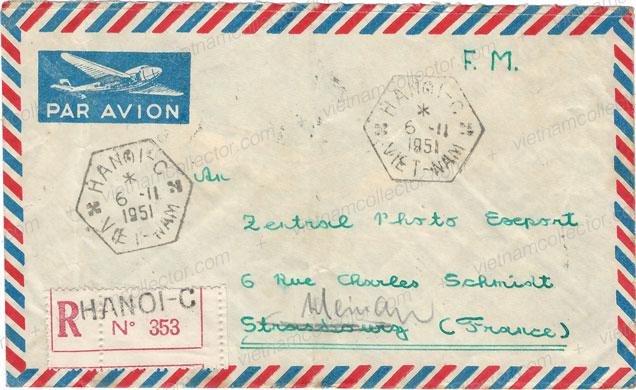
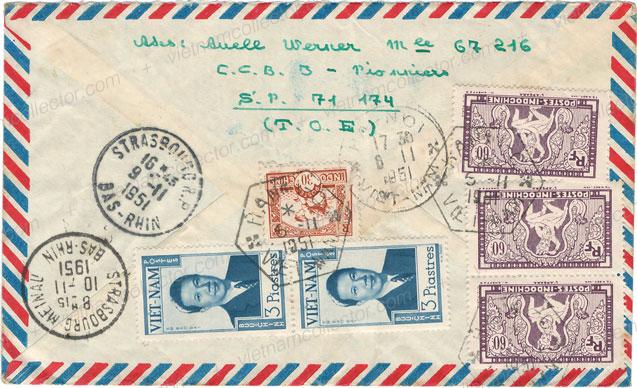
Mixed franking of a Indochinese stamp together with the 10c and 3P Landscape/Bao Dai values paying an overall postage of 5.10P on an international air mail letter front sent in December of 1951 from Saigon to France. These mixed frankings were possible from June 6th, 1951 (when the first Vietnam stamps were issued) until April 1st, 1952, when all Indochinese stamps were declared invalid.
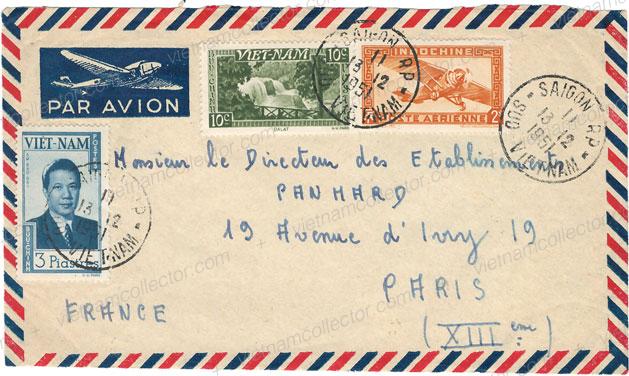
Mixed franking of a Indochinese stamp together with the 60c and 3P Landscape/Bao Dai values paying an overall postage of 4.80P on an international air mail letter sent in September of 1951 from Saigon to France. These mixed frankings were possible from June 6th, 1951 (when the first Vietnam stamps were issued) until April 1st, 1952, when all Indochinese stamps were declared invalid.
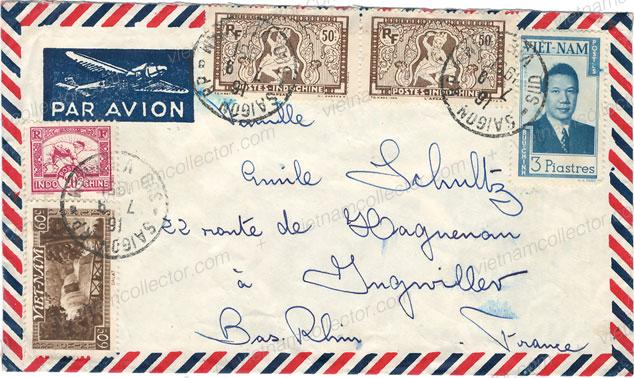
Mixed franking of a Indochinese stamp together with the 3P Bao Dai values paying an overall postage of 3.30P on an international air mail letter front sent in January of 1952 from Saigon to France. These mixed frankings were possible from June 6th, 1951 (when the first Vietnam stamps were issued) until April 1st, 1952, when all Indochinese stamps were declared invalid.
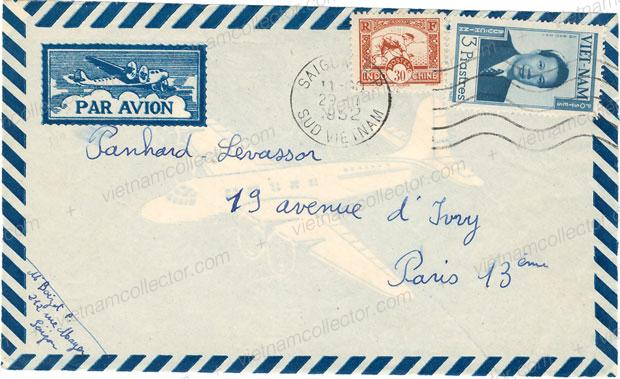
Rare multiple franking of the 3P value paying an overall postage of 9P on an international air mail letter sent from Hai Phong to the United States in November of 1954. On August 9th, 1954 all French troops in Hanoi left for Hai Phong in order to embark on ships and leave the country following the Geneva Agreement which resulted in the division of the country at the 17th parallel. This cover hence was handled by a purely North Vietnamese postal administration that interestingly continued to use the stamps of the prior regime that had been established by the French colonialists. So, this cover documents a transitioning period in which both, State of Vietnam and Democratic Republic of Vietnam stamps were used interchangeably.
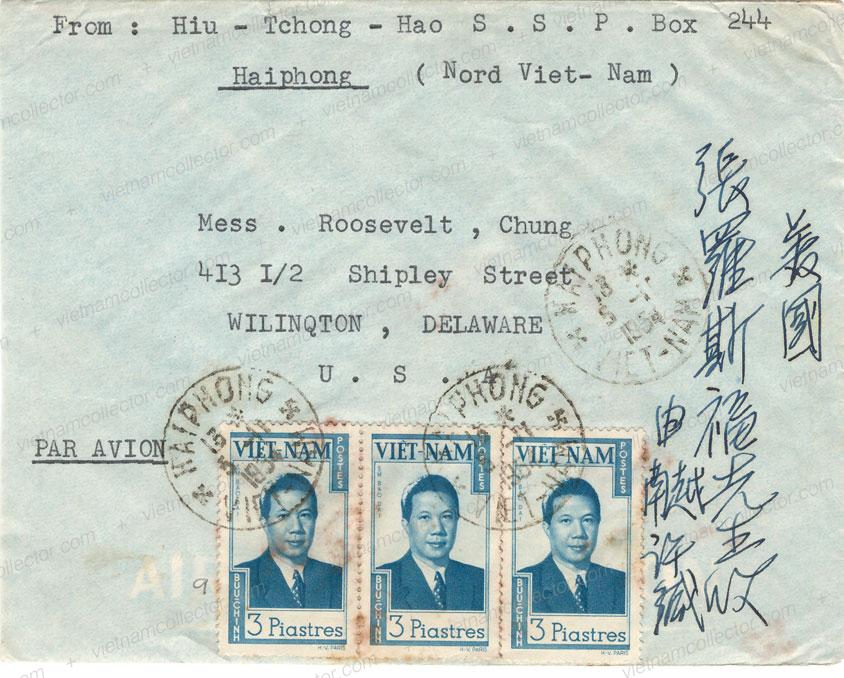
Mixed franking of the 10c, 3P and 5P Landscapes/Bảo Đại stamps together with the 40c Festival of the Searching Souls stamp paying an overall postage of 8.50P on an international letter sent from Saigon to the United States in December of 1954. St Louis transit cancel on the reverse.
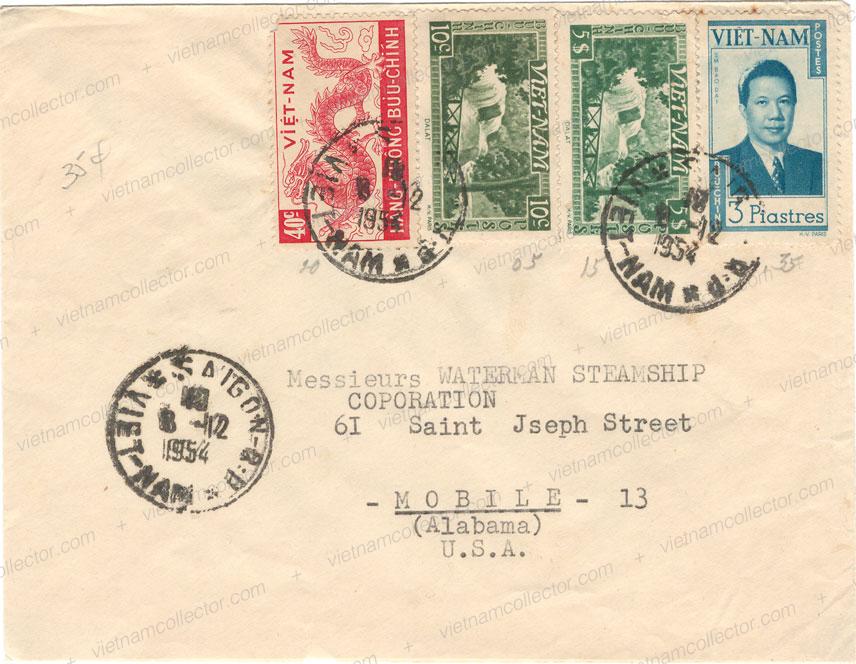
Mixed franking of the 3P (2)Bảo Đại stamps together with the 40c Bao Long stamp paying an overall postage of 6.40P sent from Saigon to West Germany in August of 1954.
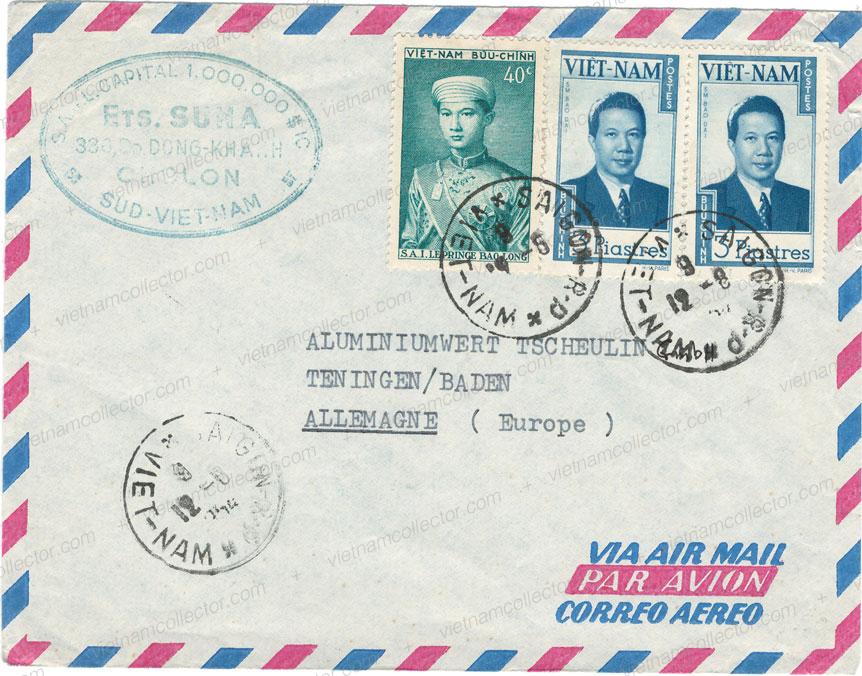
Mixed franking of three of the 3P Bảo Đại stamps plus the 50c Nam Phu’o’ong stamp paying an overall postage of 9.50P on an international air mail letter sent from Cholon to France in 1955.
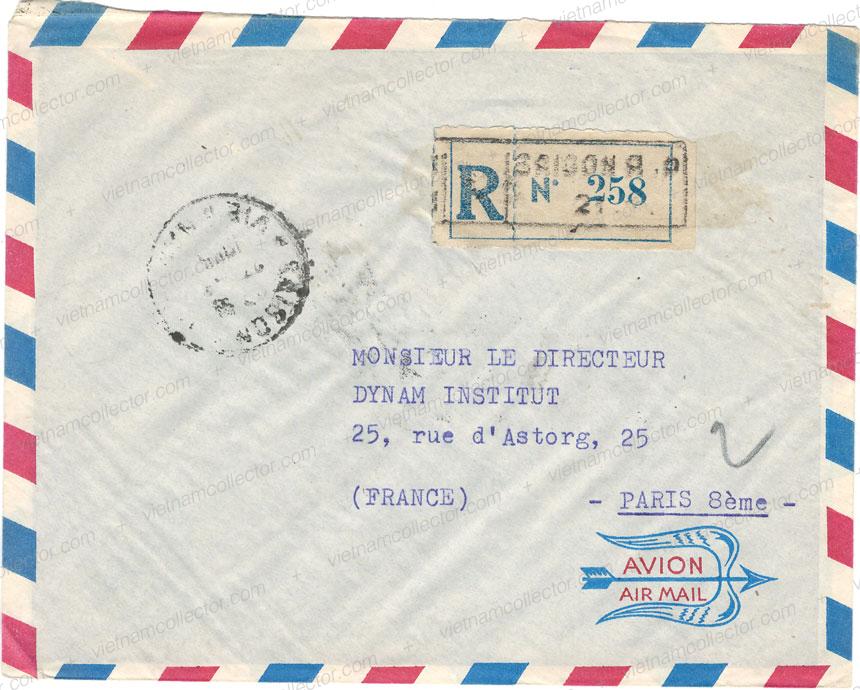
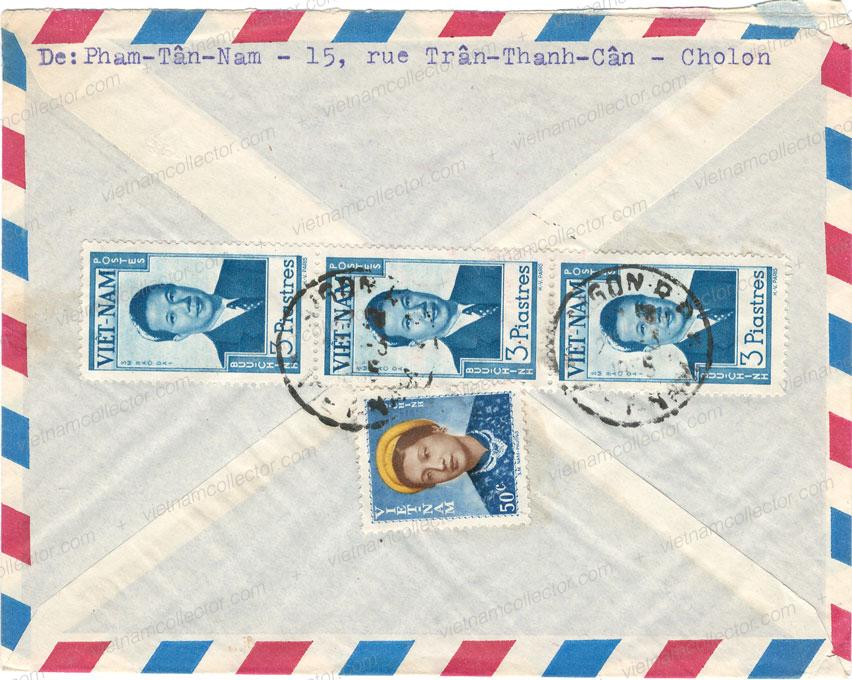
Mixed franking of the 3P Bao Dai and 10C Landscape values paying an overall postage of 3.10P on an international letter front sent from Hanoi to France in March of 1952, which was short of the required 3.30 postage. As a result a manuscript “T10” was applied in France and a 10F French postage due stamp was attached to collect the missing postage.
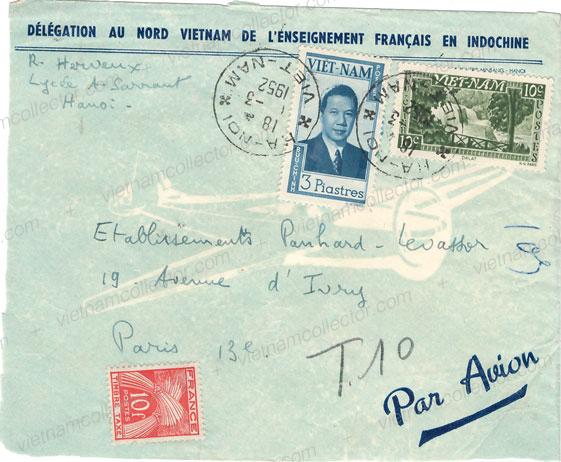
Mixed franking of the 10c and 3P State of Vietnam stamps together with the old 20c Rice Harvester stamp from Indochina on an international air mail letter sent from Hai Phong to France in February of 1952. Mixed frankings between State of Vietnam and Indochina stamps were possible from June 6th, 1951 until April 1st , 1952.
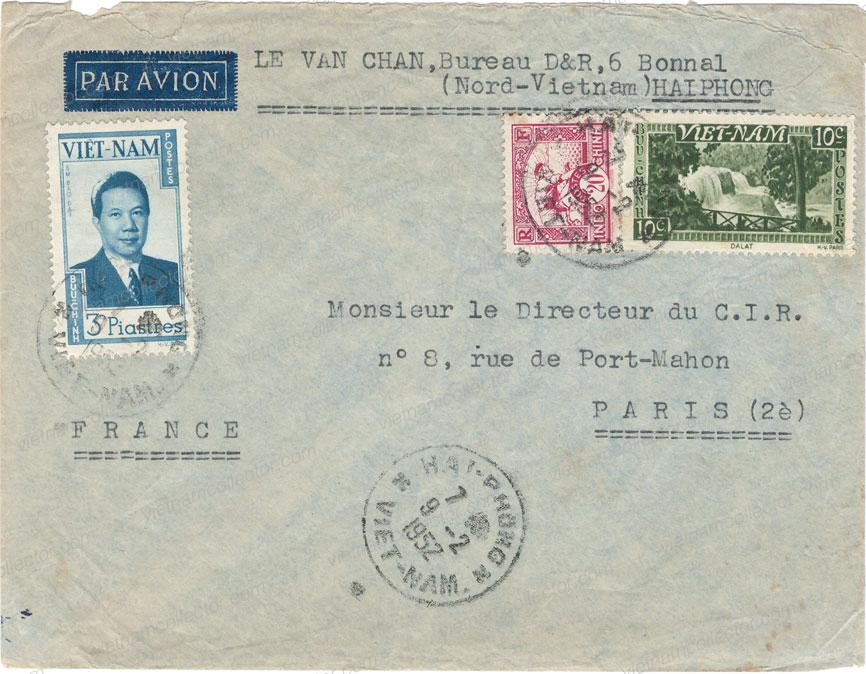
Here is a very similar mixed franking of the 3P Bảo Đại stamp together with the 30c Rice Harvester stamp from Indochina paying an overall postage of 3.30P on an international air mail letter sent from from Hai Phong to France in February of 1952.
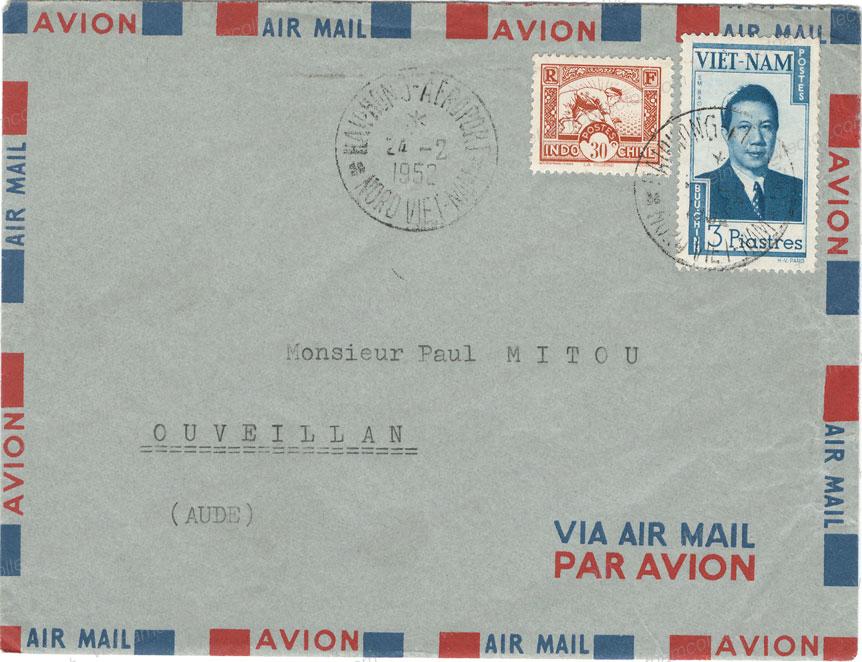
Mixed franking of the 60c and 3P Bảo Đại stamps (2) paying an overall postage of 6.60P on a letter front from Saigon to France in 1953.
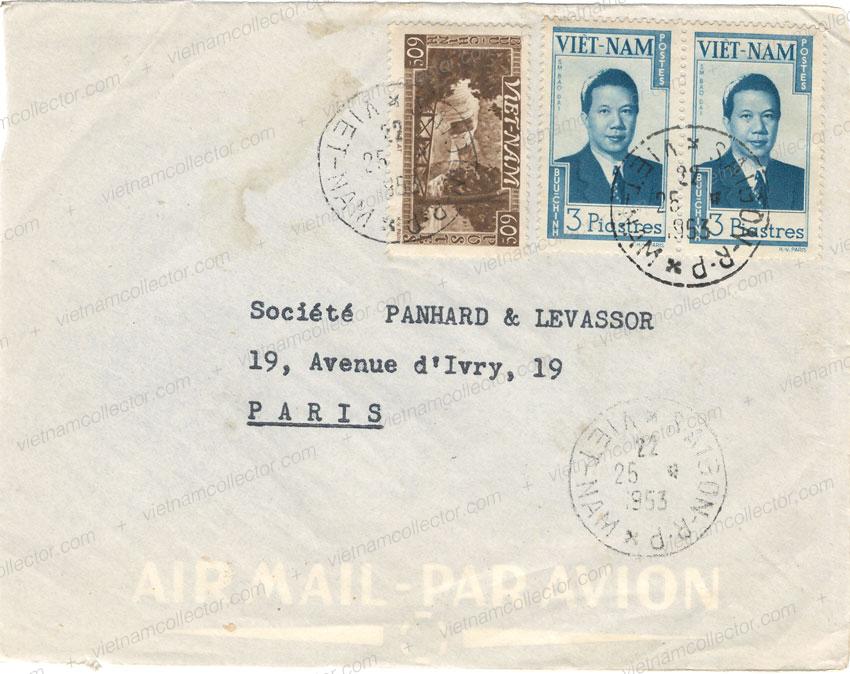
Mixed franking of the 60C Landscape and 3P Bảo Đại together with the 40x Festival of Searching Soul stamp paying an overall postage of 4P on an international air mail letter sent by a French soldier from Saigon to Senegal in September of 1953. Senegal was rather rare destination.
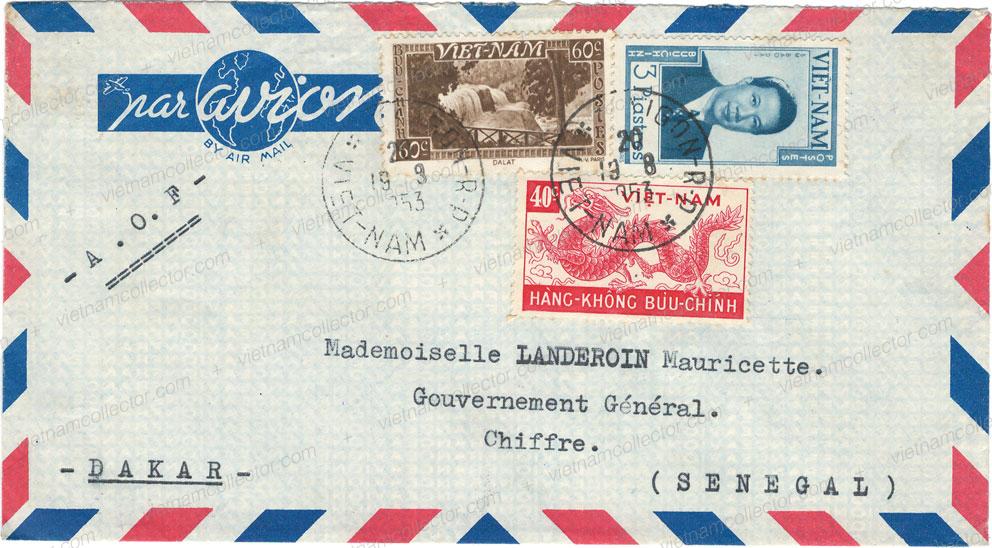
Mixed franking of the 10c, 60c and 3P Landscapes/Bảo Đại stamps paying an overall postage of 3.70P on an international air mail letter sent from Saigon to Switzerland in August of 1952.
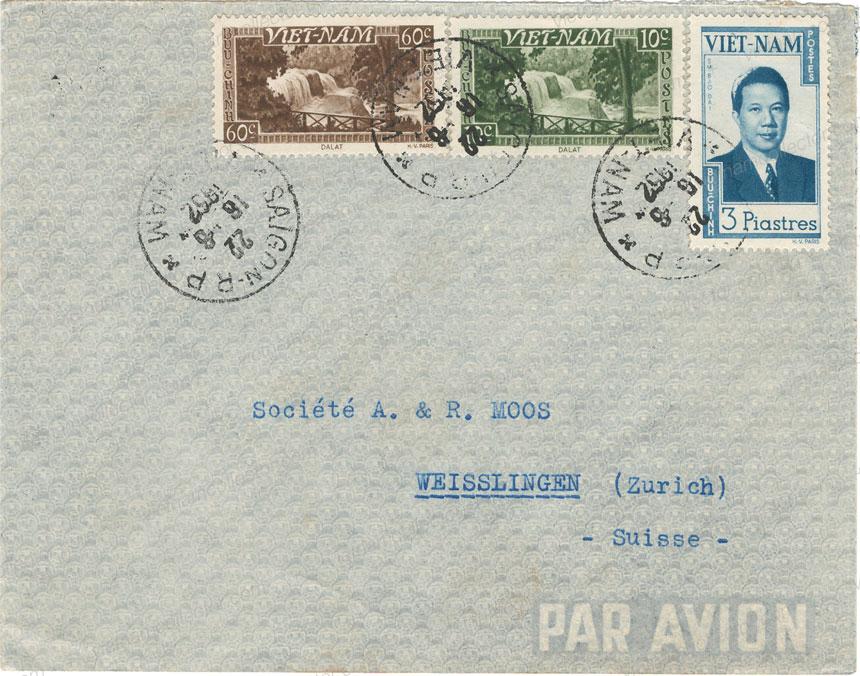
Mixed franking fo the 30c and 3P values paying an overall postage of 3.30P on an international air mail letter front sent from Saigon to France in December of 1951.
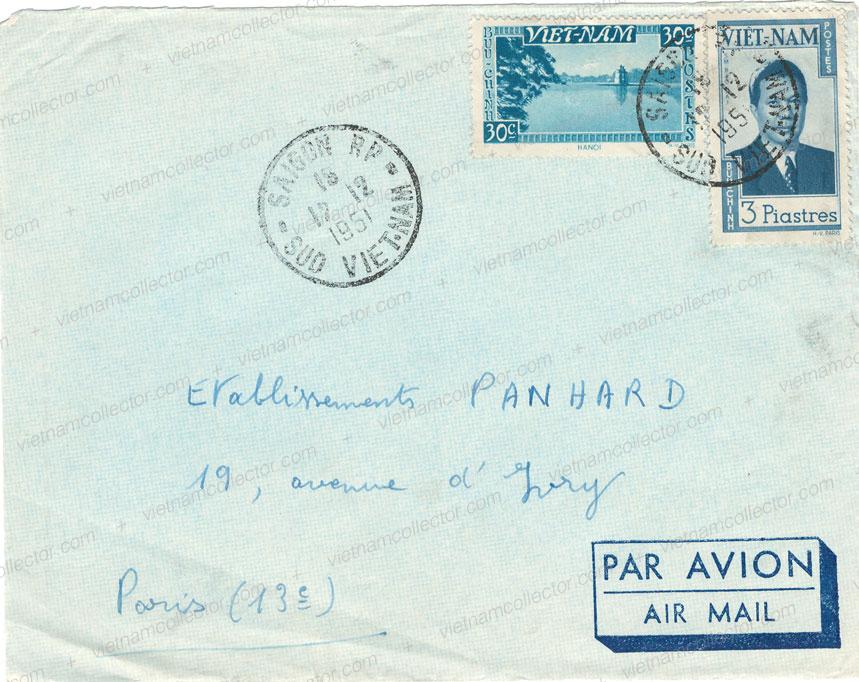
Rare mixed franking of the 20c Landscape (3) and 3P Bảo Đại stamps paying an overall postage of 3.60P on an international air mail letter sent from Saigon to Austria in October of 1951. Austria was still occupied by the Allied Victors until 1955 so incoming international letters were still censored. Note the blue censor cachet from censor Nr. 253 and the tape on the left that was used to close the letter after opening. Vienna arrival cancel on the reverse.
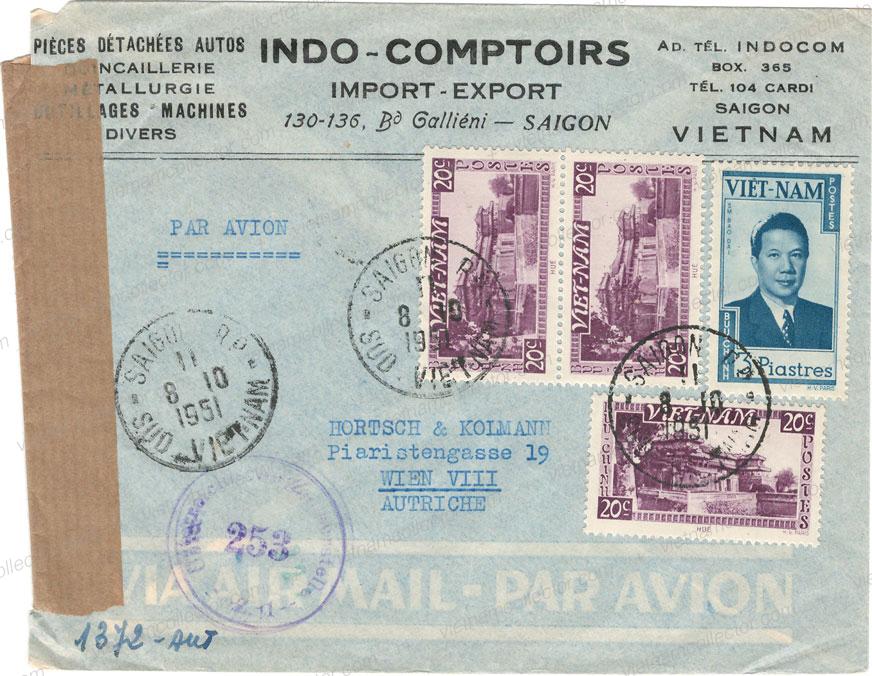
Mixed franking of the 1P, 2P (11) and 3P (5) Landscapes/Bảo Đại stamps paying an overall postage of 38P on an air mail letter sent from Hai Phong to Switzerland.
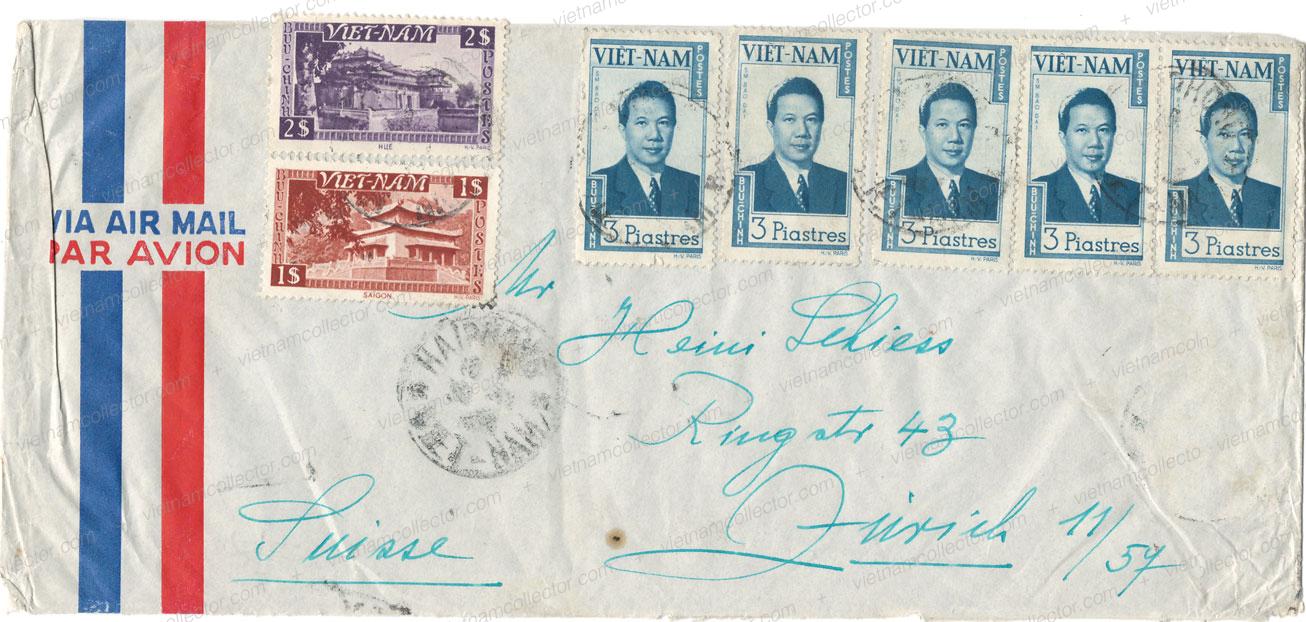
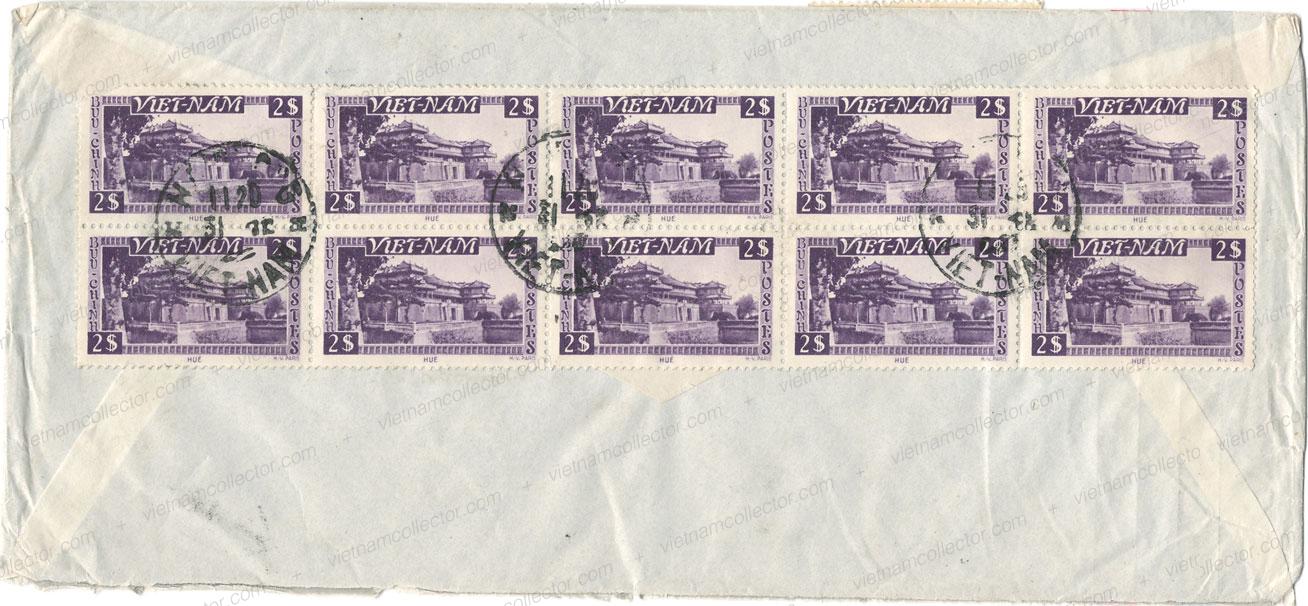
Mixed franking of the 10c, 20c (2), 30c (3), 50c, 60c and 3P Landscapes/Bảo Đại stamps together with two 20c and one 2P Indochina stamps paying an overall postage of 7.90 on an international air mail letter sent by the Military Assistance Advisory Group (MAAG) in September of 1951. MAAG was the group that consisted of American military advisors and that enjoyed diplomatic status that were sent to Vietnam to train the conventional forces of the South Vietnamese Army. This cover nicely documents that the United States was involved early on in the 2nd Indochina War.
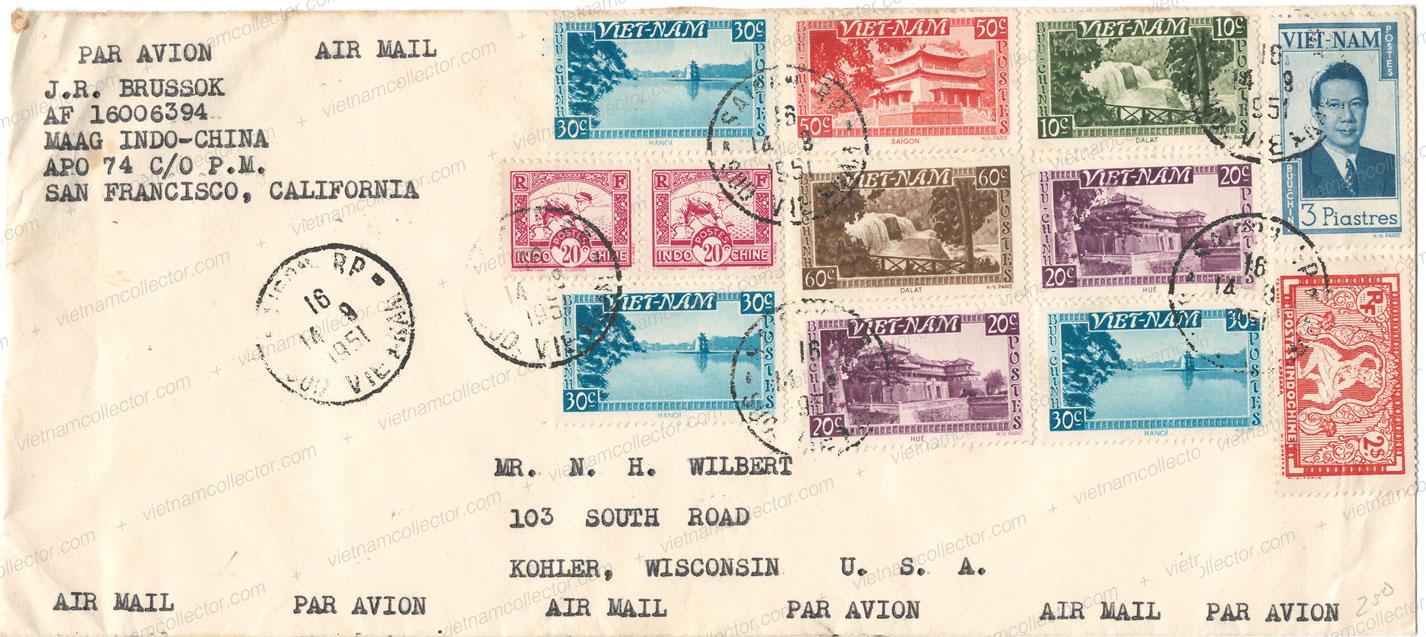
Rare single franking of the 5P value on an international air mail letter sent from Saigon to France in November of 1954.
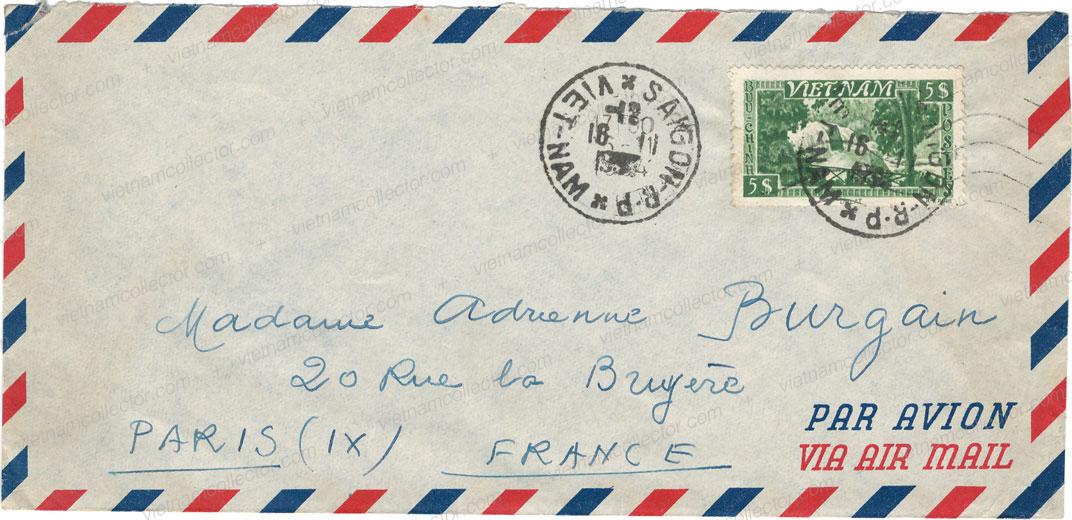
Rare singe franking of the 5P value on a cover front on a local letter sent by a bank in Hai Phong to Saigon in June of 1952.
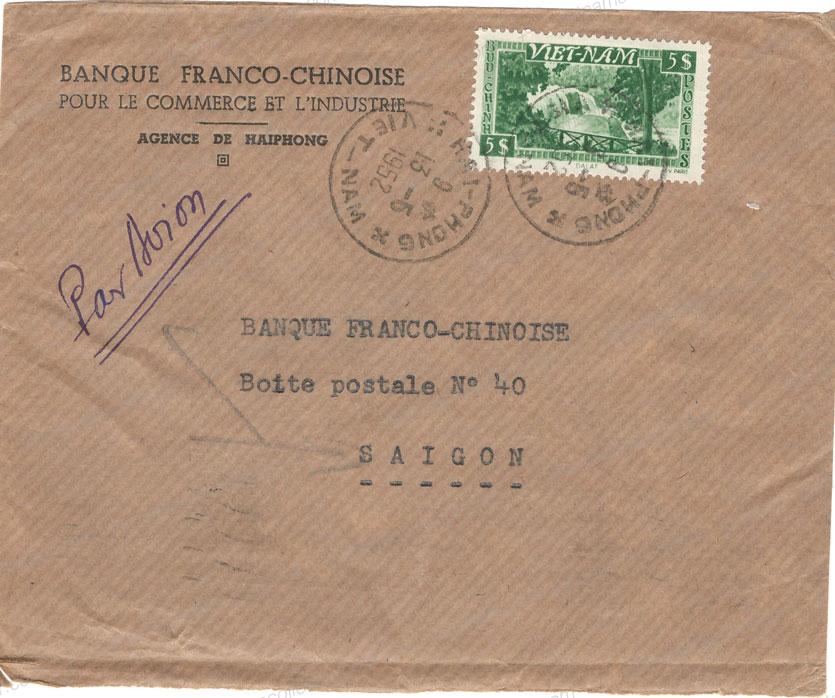
Mixed franking of two 5P Landscape stamps, the 3P Bảo Đại, 20P Bao Long and 4P Air Mail stamp paying an overall postage of 37P on a registered surface letter set from Saigon to the United States in August of 1954. Boston transit cancels on the reverse. The 20P Bao Long stamp on postally used cover as well as marine registered letters are very rare.
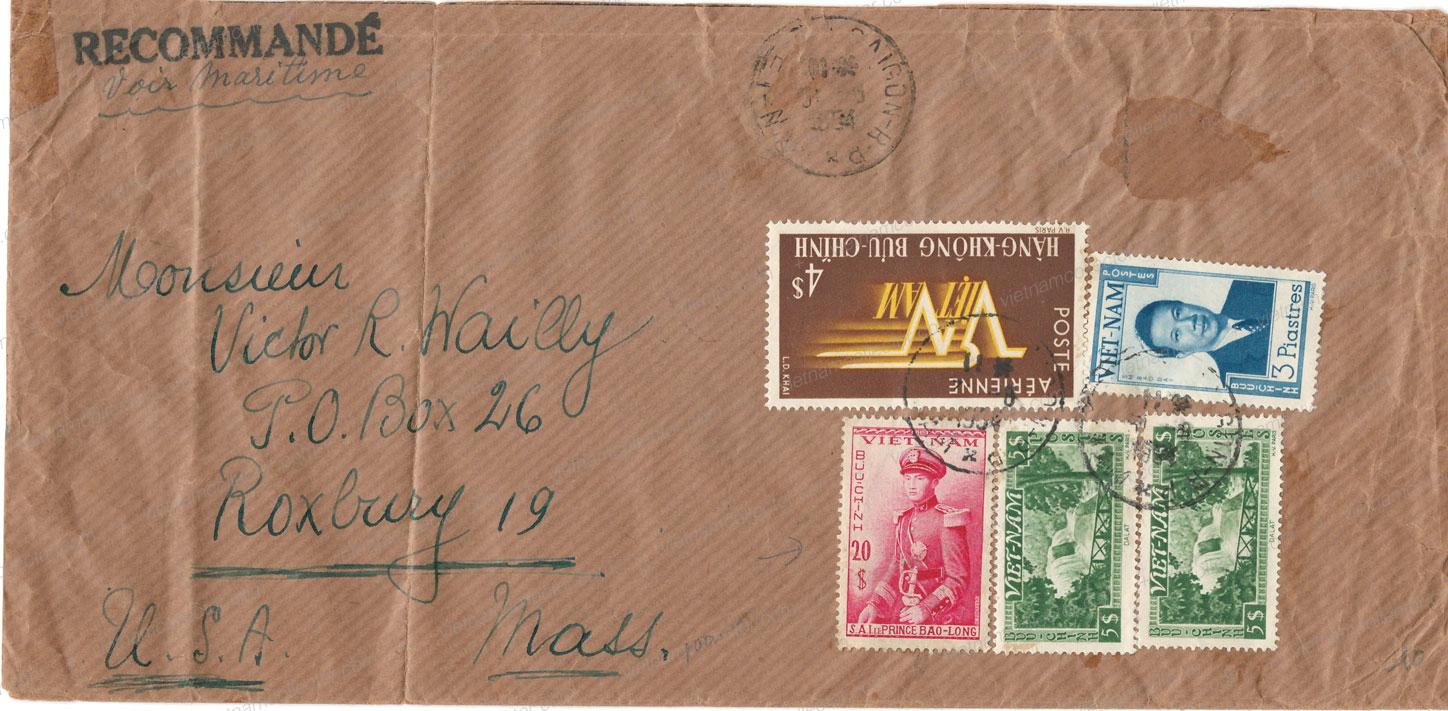
Mixed franking of the 20c and 5P Landscape stamps together with the 50c Geneva Agreement and 4P Ngô Đình Diệm stamps paying an overall postage of 40.40P on a large commercial registered letter sent in July of 1956 from Saigon to India.
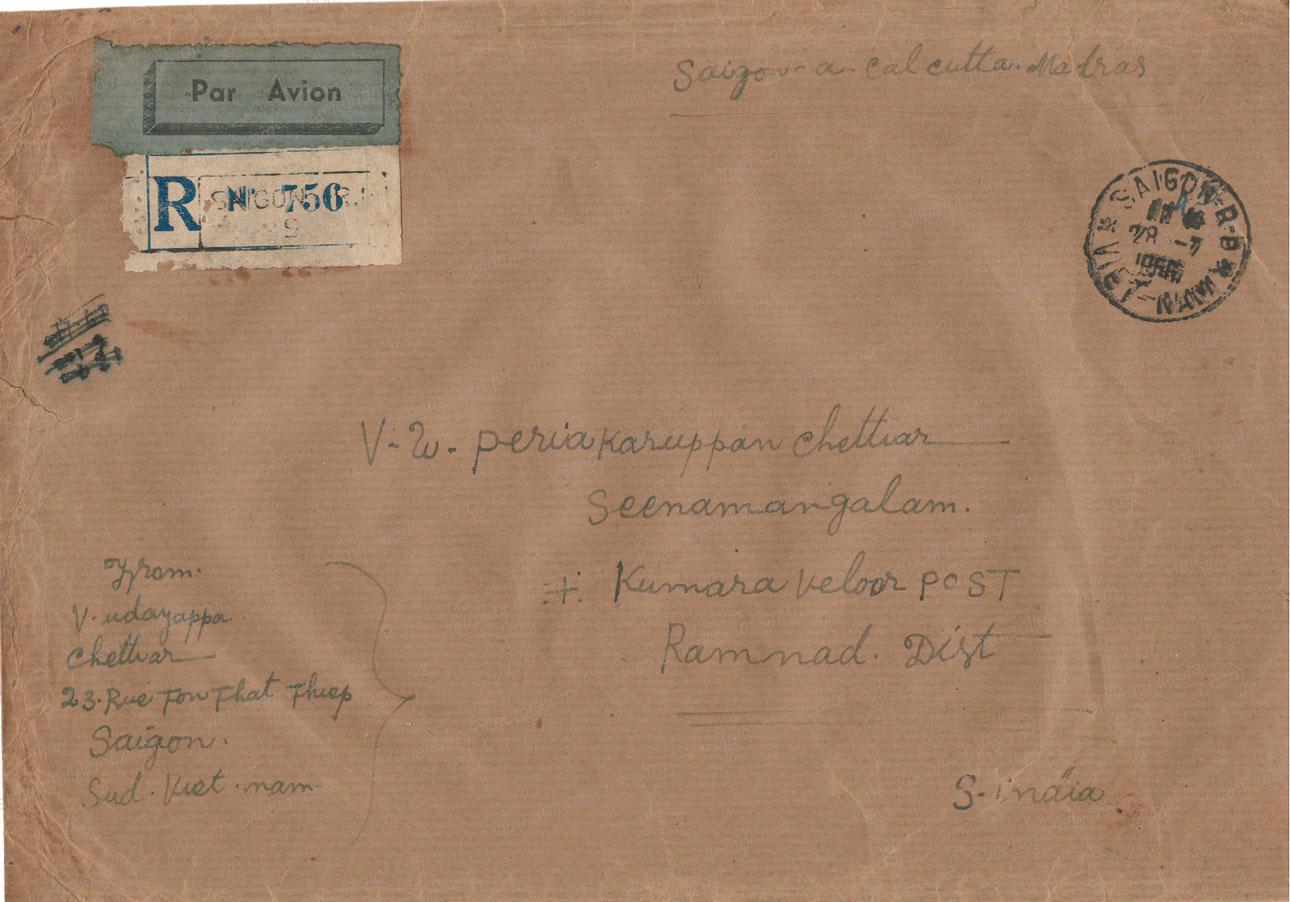
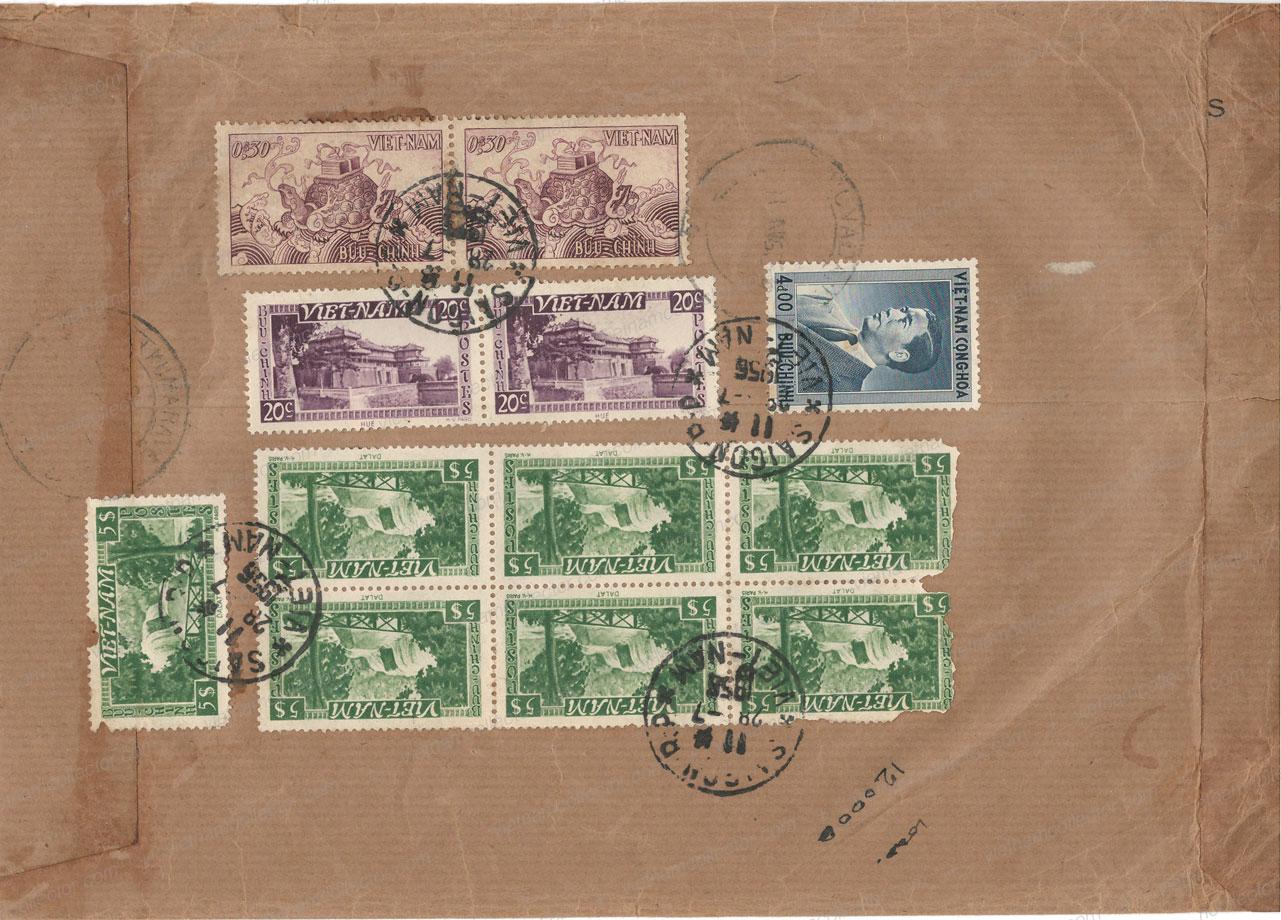
Mixed franking of the 50c and 10P Landscapes stamps together with the 4P Air Mail stamp paying an overall postage of 14.50P on a registered international air mail letter front sent from Saigon to France.
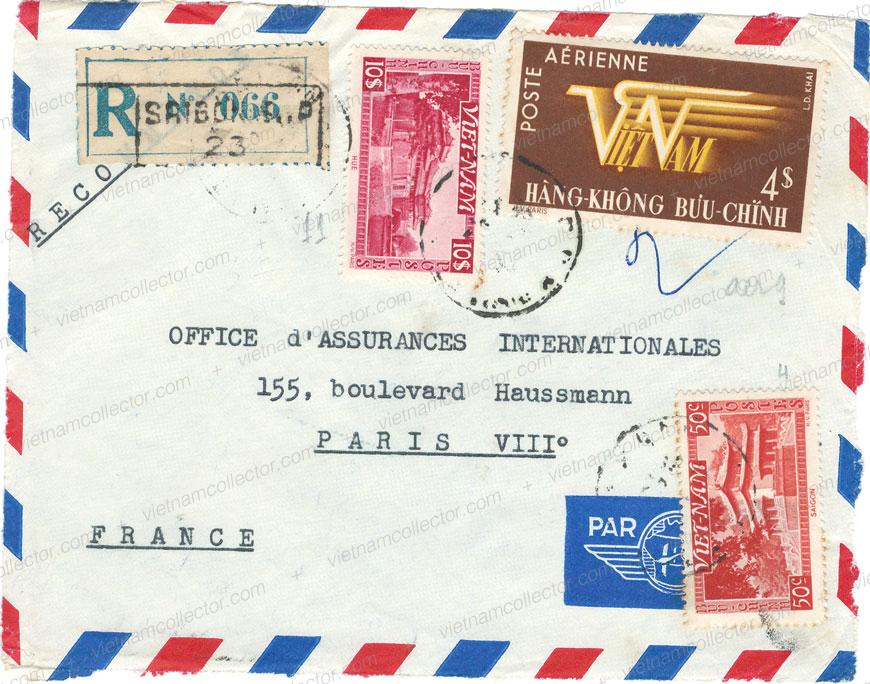
Mixed franking of the 30c and 10P Landscapes stamps together with a 70c Indochinese stamp paying an overall postage of 11P on an international air mail letter sent from Saigon to France.
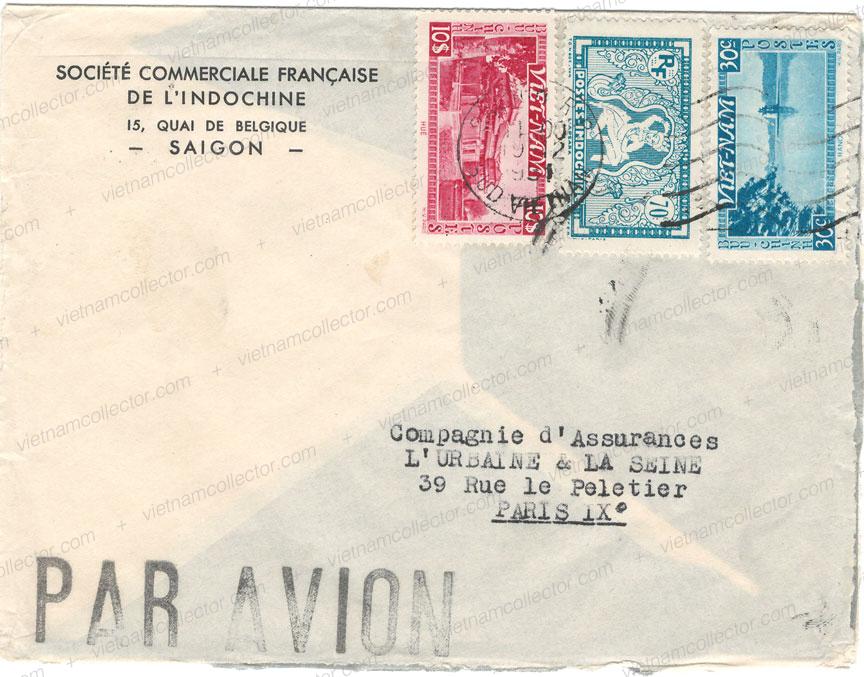
Mixed franking of the 10P Landscape value together with 4P Independence Palace and 50c Geneva Agreement paying an overall postage of 14.50P on a registered air mail letter sent from Saigon to West Germany in February of 1956. Munich arrival cancels on the reverse.
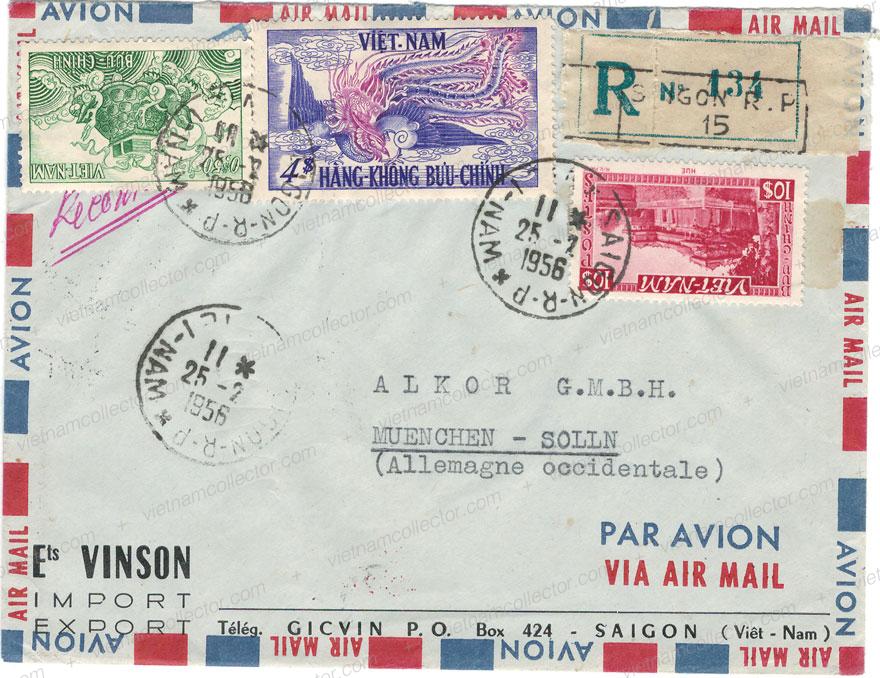
Mixed franking of the 10P Landscape value together with two 50c Ngô Đình Diệm stamps paying an overall postage of 11P on a registered letter sent from Quang Ngai to well known philatelist Theo Klewitz in West Germany. Tourane and Saigon transit cancels on the reverse.
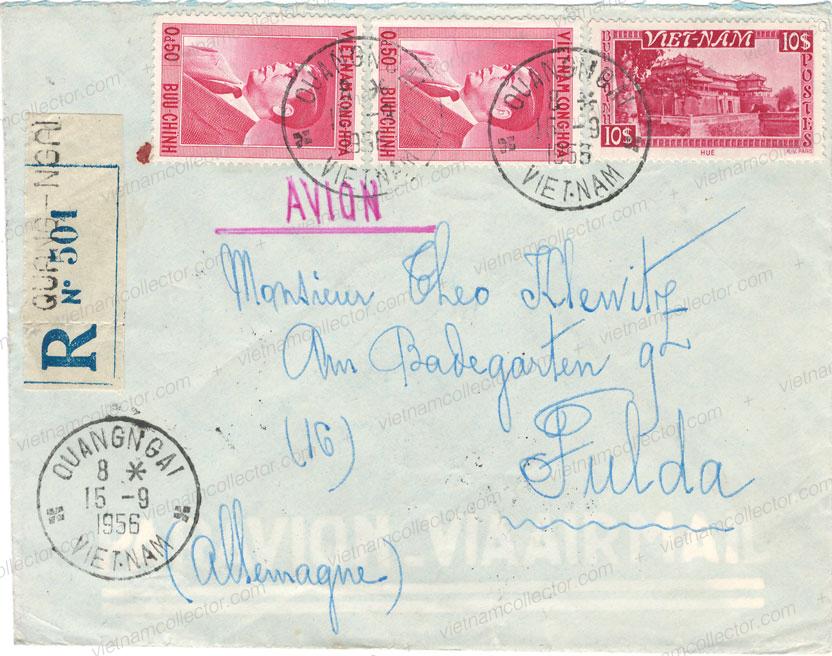
Mixed franking of the 20c and 10P Landscapes stamps together with the 50C (3) and 1.50P Geneva Agreement stamps paying an overall postage of 13.20P on a registered international air mail letter sent from Quinhon to West Germany in June of 1956. Saigon transit and Fulda arrival cancel on the reverse.
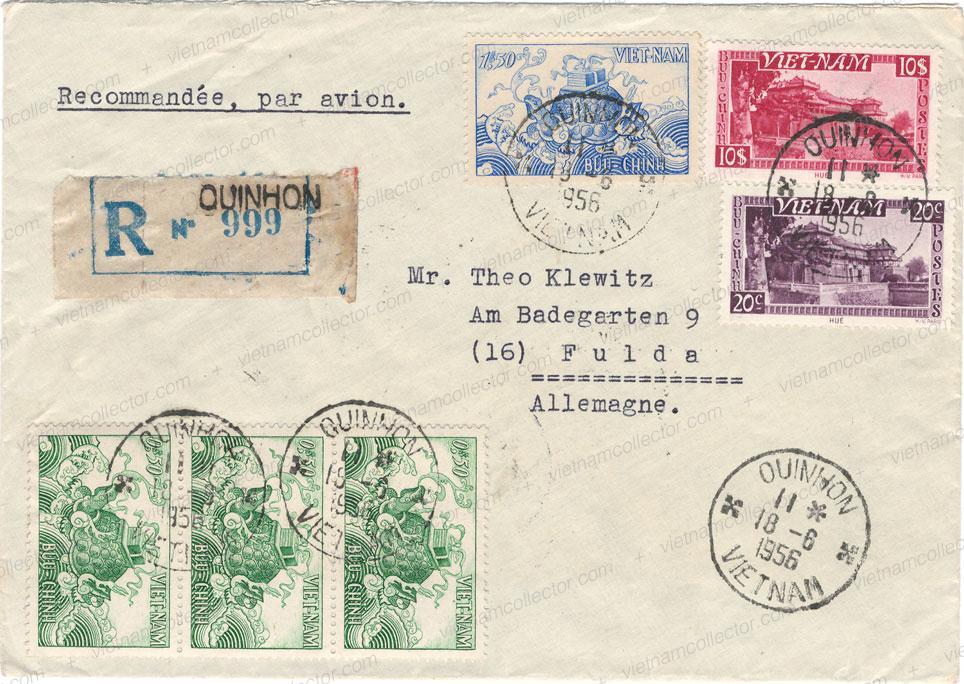
Mixed franking of the 10P Landscape value together with the 3.30P Air Mail, 4P Independence Palace and 50c Geneva Agreement stamps paying an overall postage of 17.80P on a registered international air mail letter sent from Tam-Ky to West Germany.
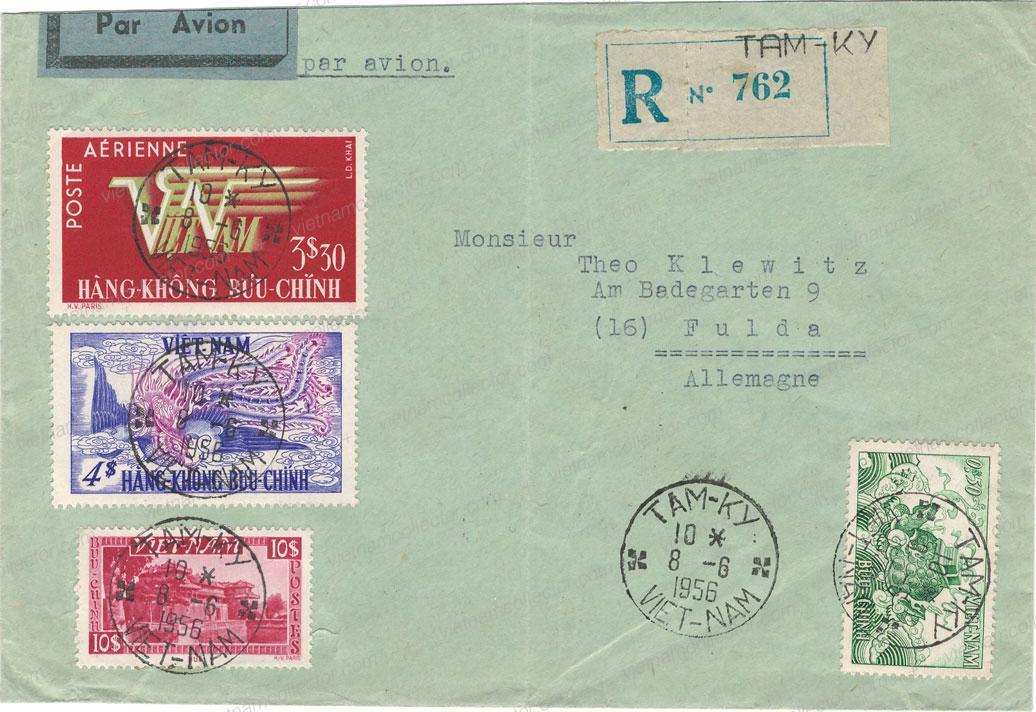
Rare single franking of the 10P value on an international postcard sent from Saigon to the United States in 1965. Surprisingly few postcards from this era survived.
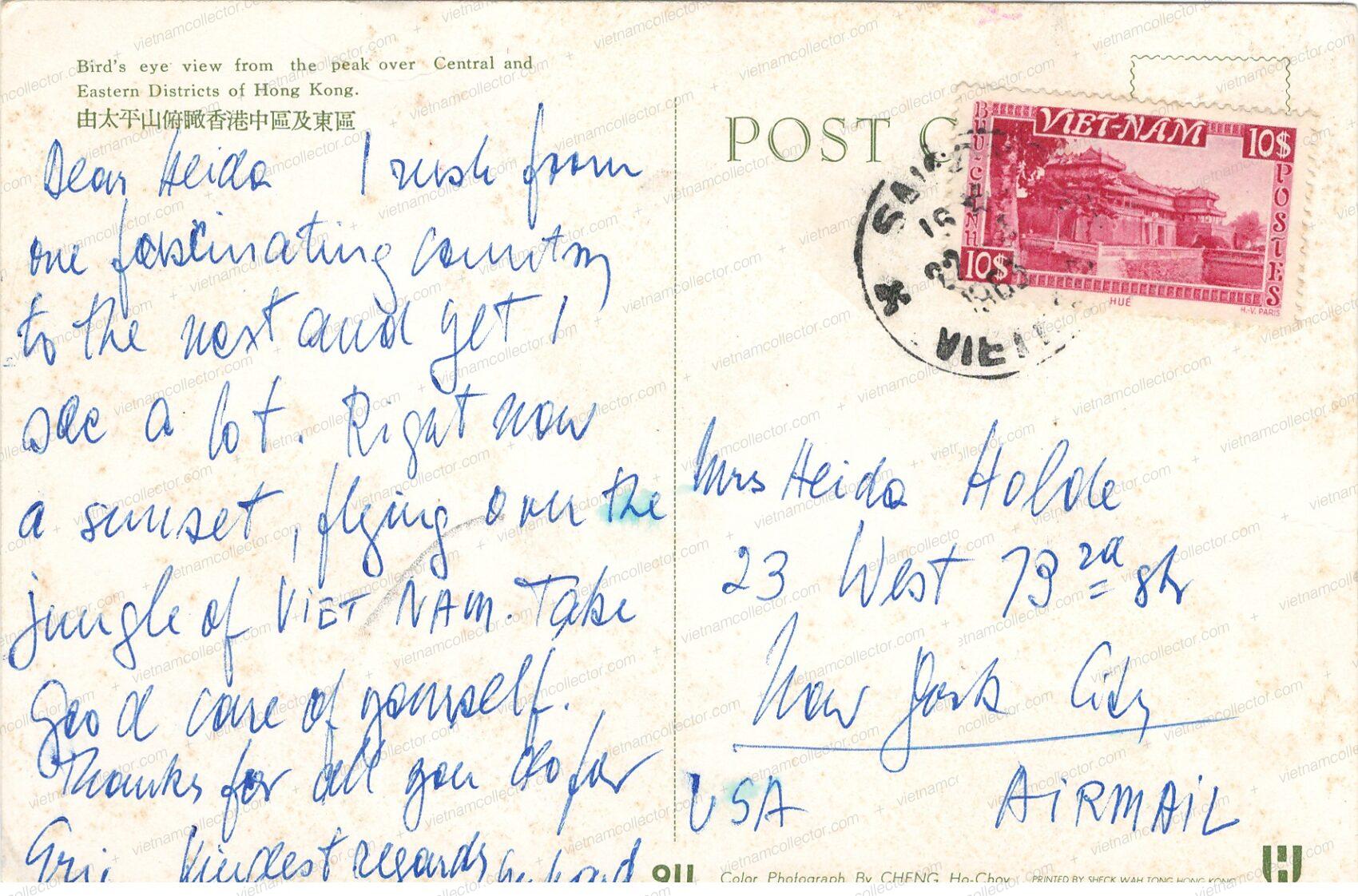
Single franking of the 10P value on an international air mail letter sent from Hong Gay to Sweden in May of 1953.
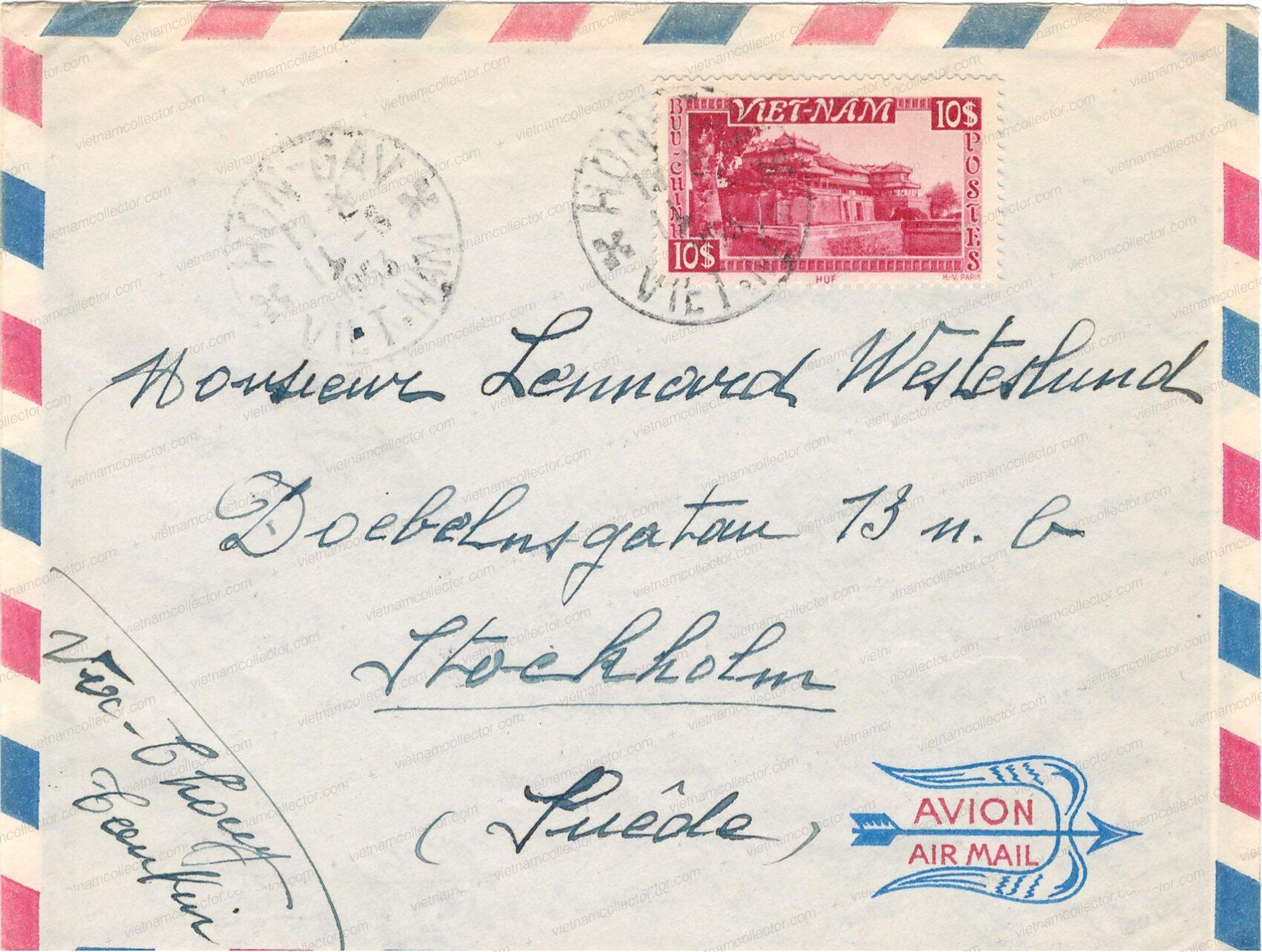
Rare multiple franking of the 10P Landcape value (2) paying an overall postage of 20P on an international air mail letter sent from Saigon to the United States in February of 1956.
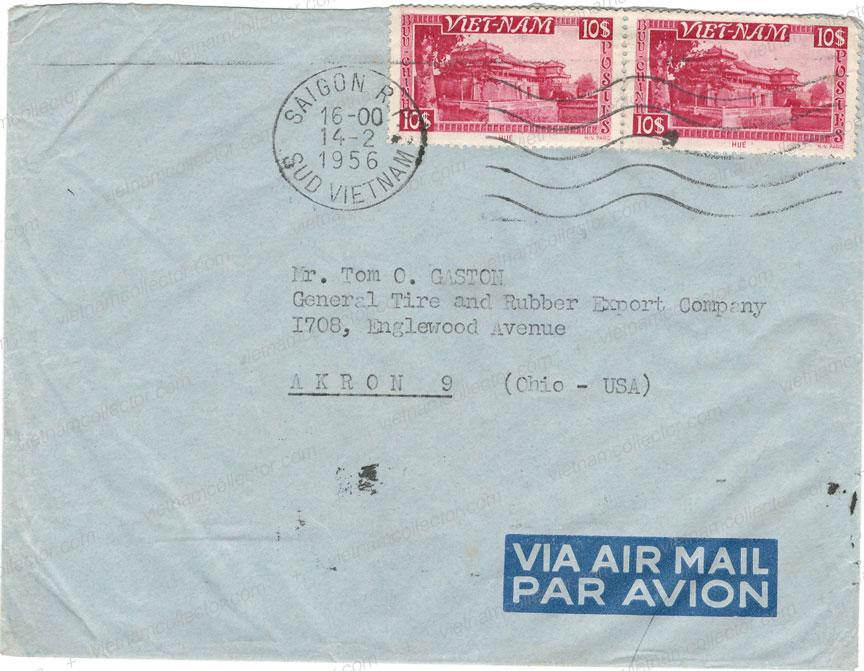
Very rare single use 15P stamp used as a revenue stamp for the authentication of a postal indentification document that could be used to transfer money.
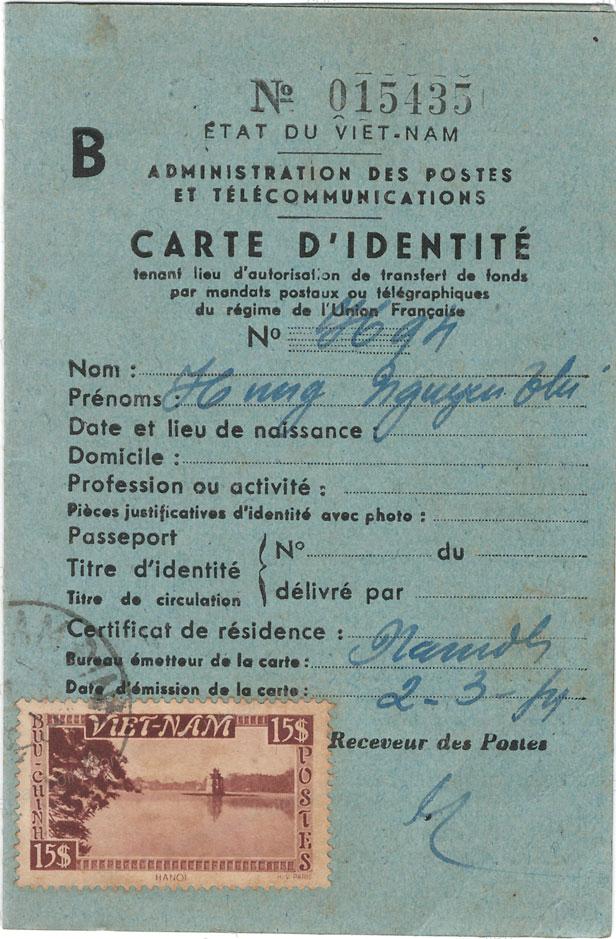
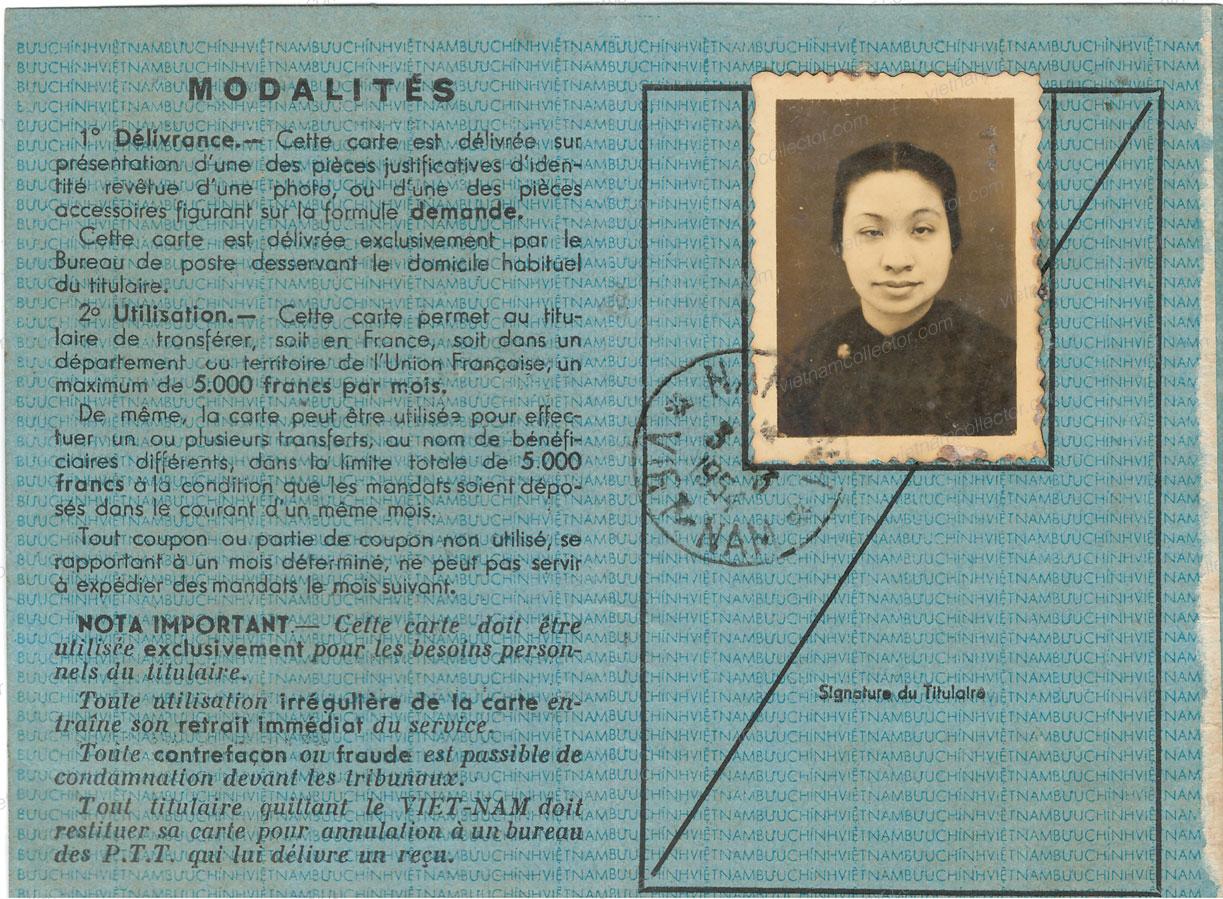
Mixed franking of the 10c and 15P Landscape value together with the 4P Air Mail and 40c Festival of Searching Souls paying an overall postage of 19.50P on an international air mail front sent from Saigon to France in July of 1955. The 15P value on postally used cover is very rare.
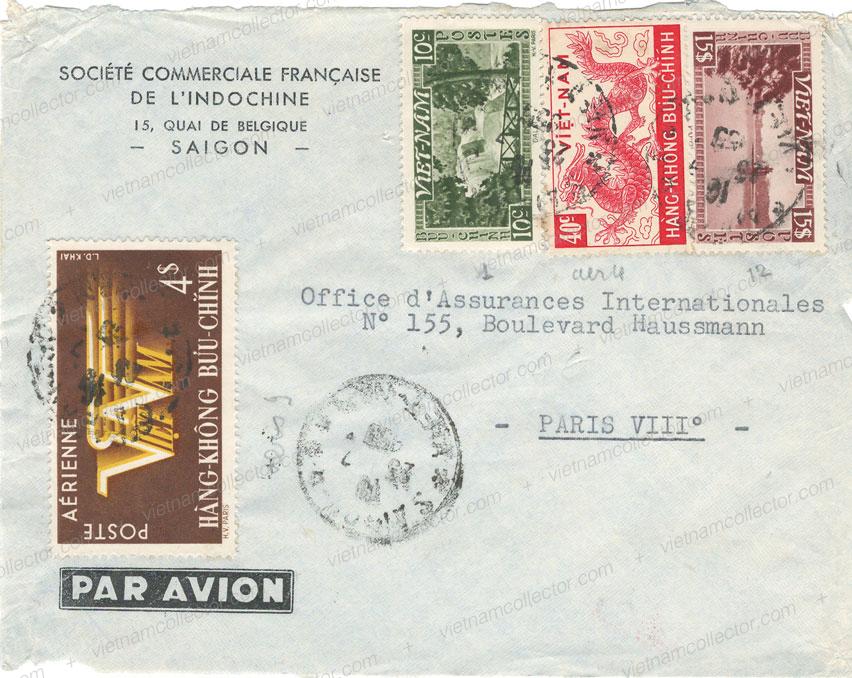
Mixed franking of the 1P, 2P and 15P Landscape stamps together with the 4P Air Mail stamp paying an overall postage of 22P on a large commercial envelope from Saigon to France in March of 1954.
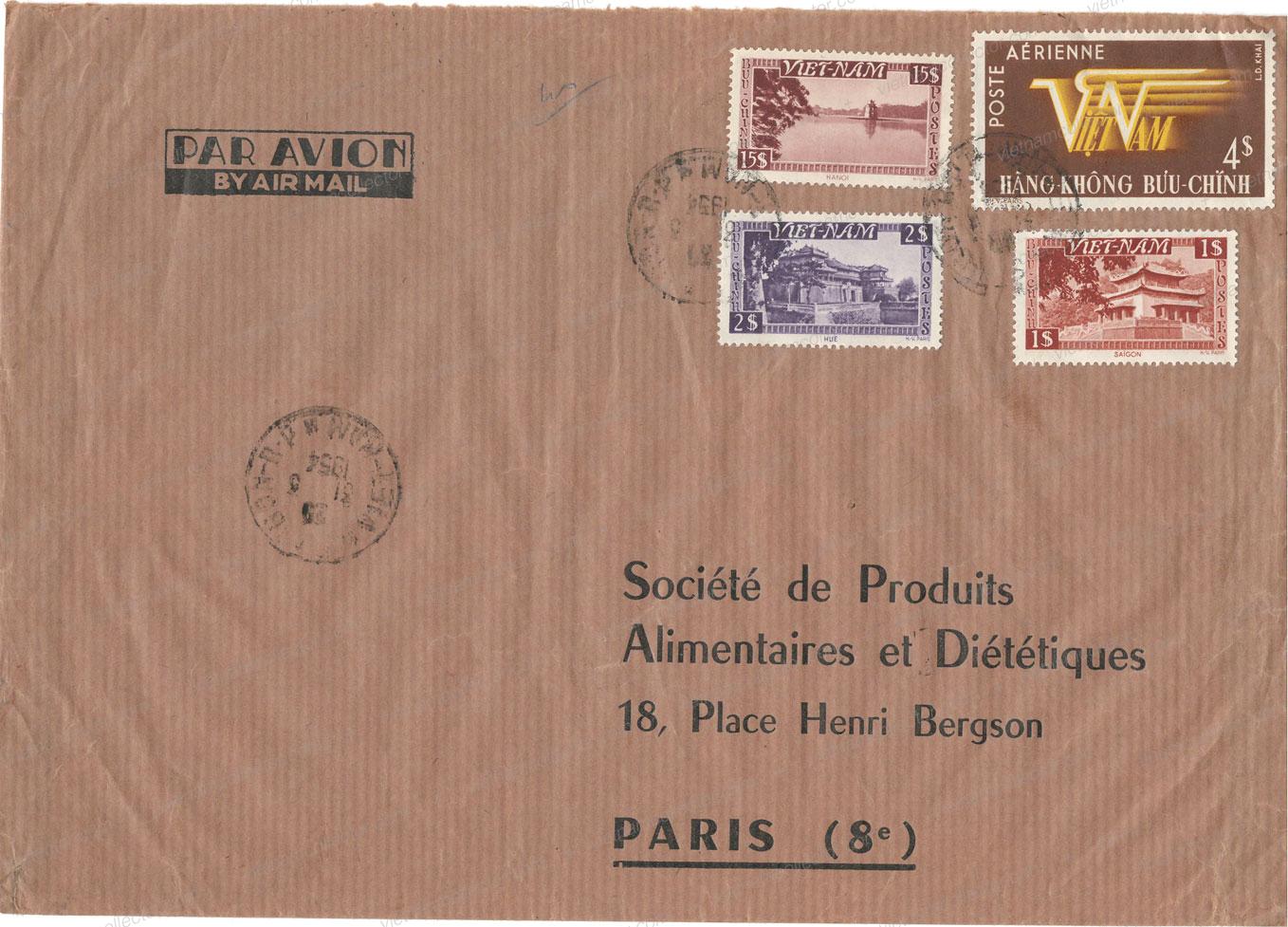
Mixed franking of the 15P Landscape stamp together with stamps from the Air Mail and Domestic Motives Indochina stamp paying an overall postage of 70.20P on a very rare package wrapper. Most package wrapper’s were thrown out after the package had been opened and so few survive to this day. The package was sent by registered mail from Hanoi to France and contained embroidery.
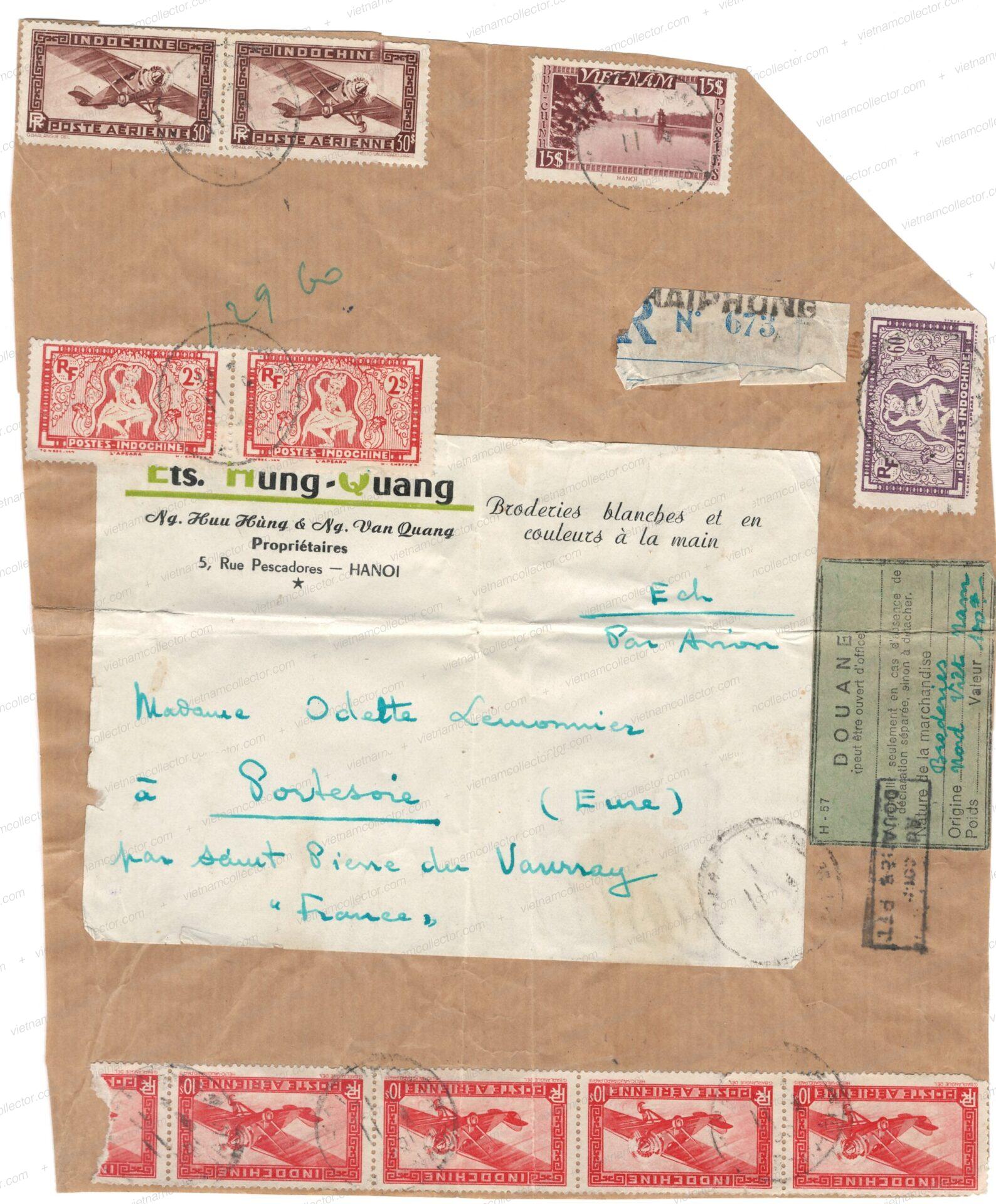
Very rare single franking of the 15P Landscape value on an international air mail letter sent from Saigon to the United States in December of 1953. The 15P value on postally used cover is very rare.
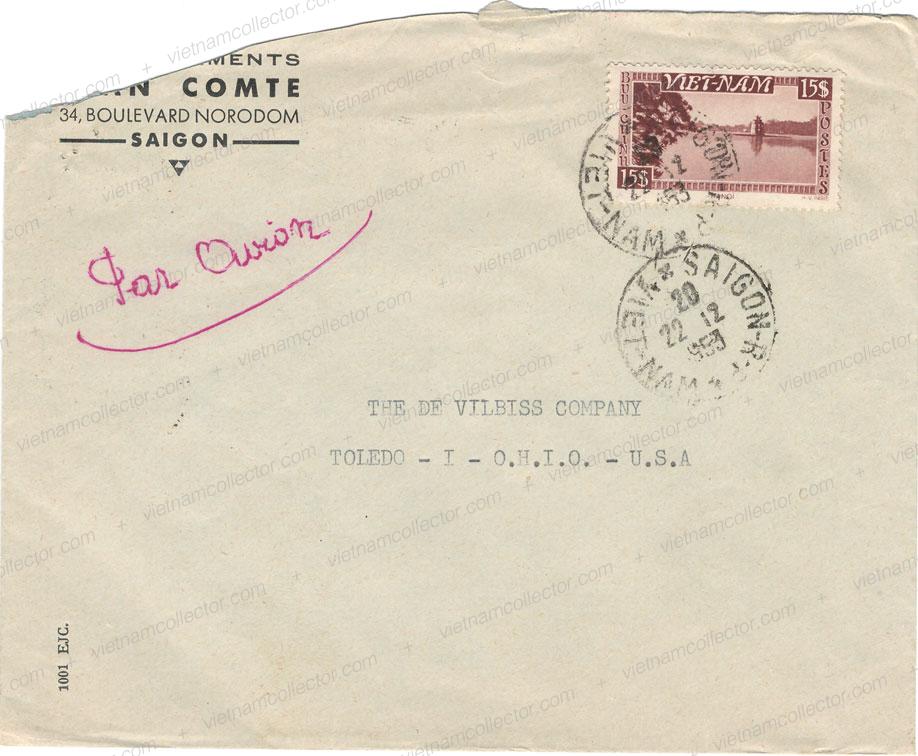
Mixed franking of the 20c, 1P, 3P, 15P and 30P Landscape/Bảo Đại stamps paying an overall postage of 59P. The 30P Bảo Đại stamp on postally used cover is very rare. It is usually only found on large commercial envelopes or package wrappers.
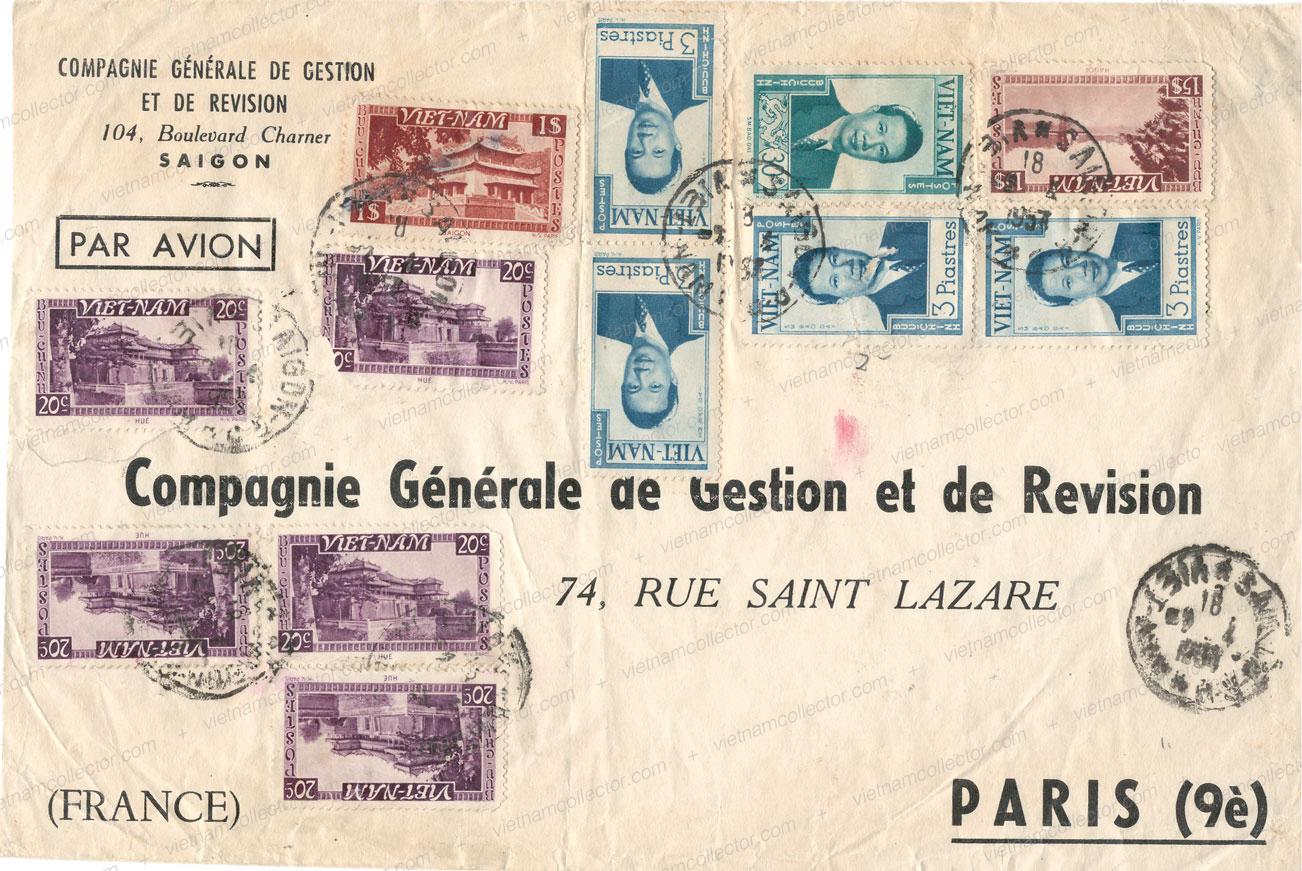
Mixed franking of the 3P and 30P Bảo Đại together with two UPU stamps paying an overall postage of 43P on a larger commercial air mail envelope sent in December of 1953 from Saigon to France.
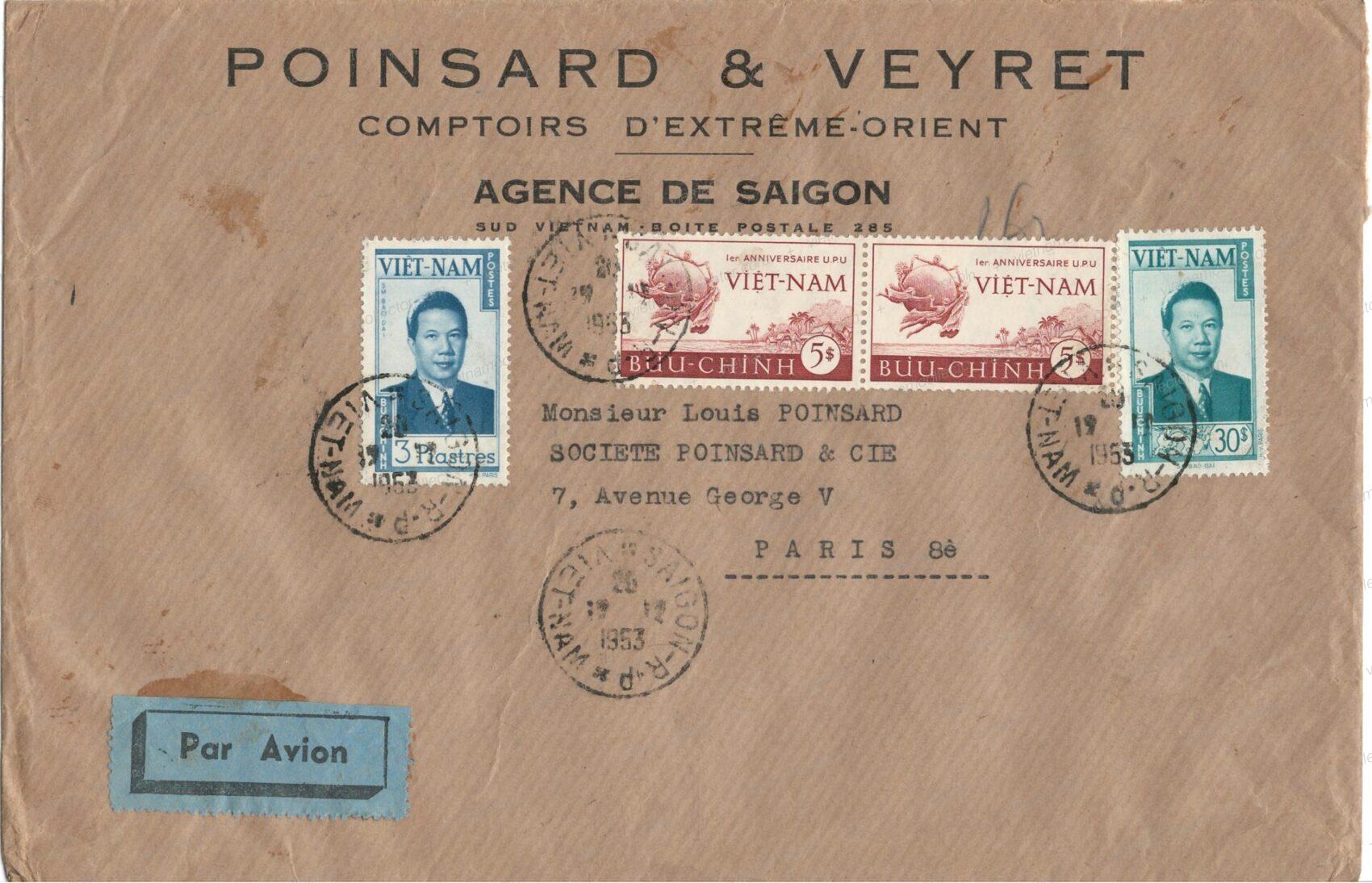
Mixed ranking of the 30P Bảo Đại stamps (2) together with tampa from the Air Mail, UPU and Lost Soul its paying an overall postage of 74.40P on an international letter sent in November er of 1955 from Saigon to Switzerland.
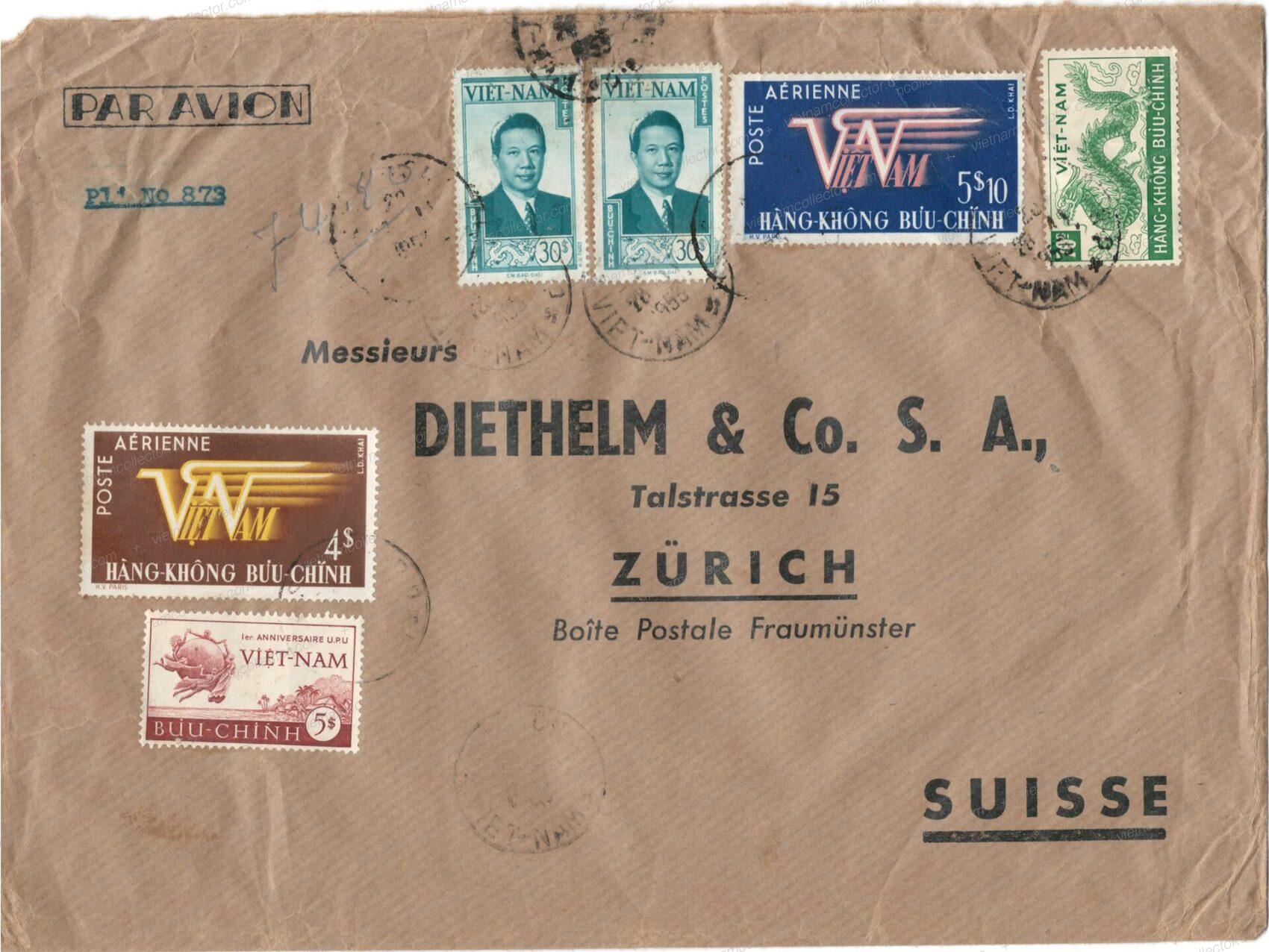 Extremely rare single franking of the 30P value on a large commercial envelope sent in May of 1953 from Saigon to France. The editor has never seen another single franking of this stamp offered in the market place in the last 20 years.
Extremely rare single franking of the 30P value on a large commercial envelope sent in May of 1953 from Saigon to France. The editor has never seen another single franking of this stamp offered in the market place in the last 20 years.
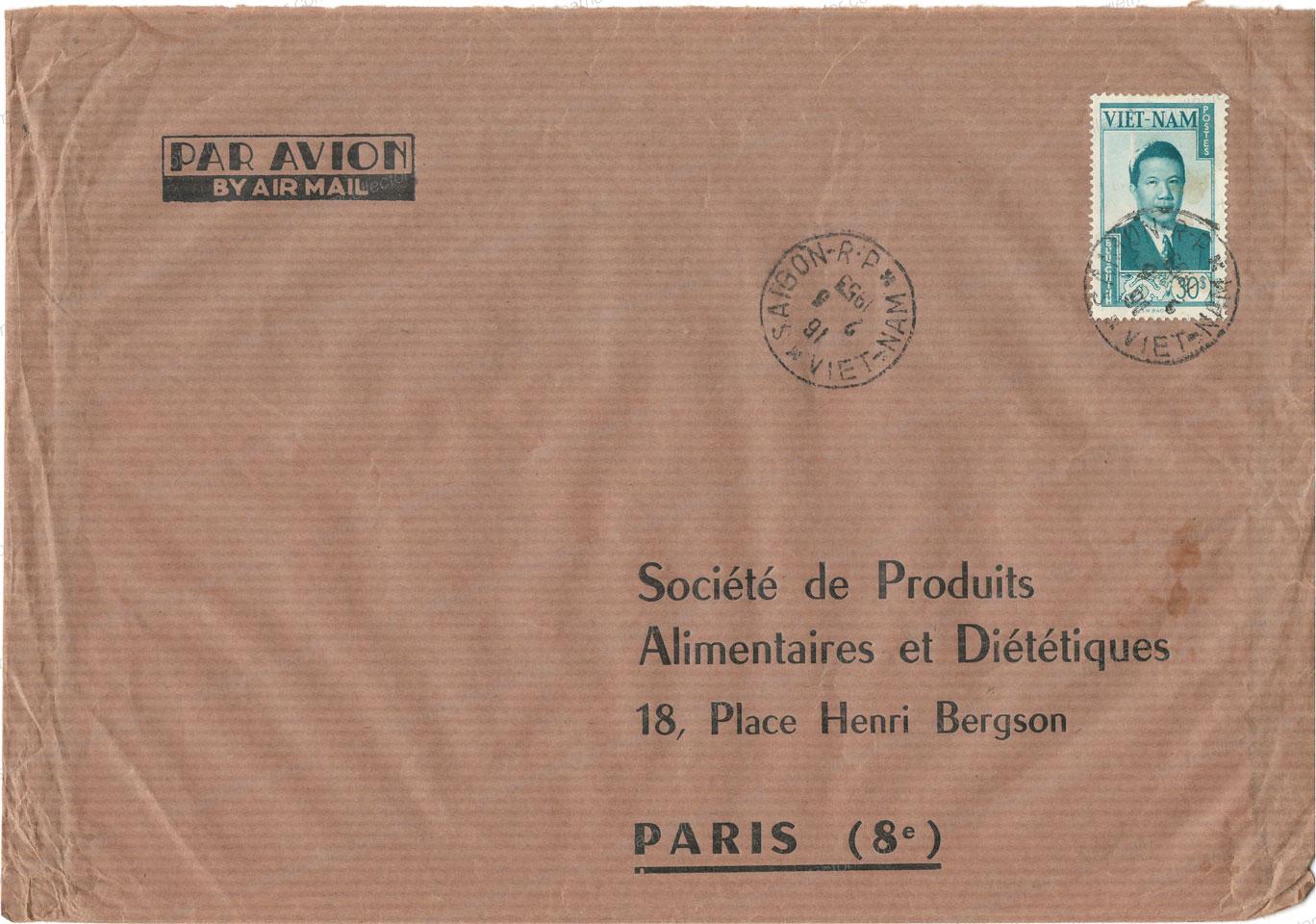
Mixed franking of the 30D Bảo Đại stamp (2) together with the 1.50P Nam Phuong stamp paying an overall postage of 61.50P on a large commercial envelope sent from Hai Phong to France.
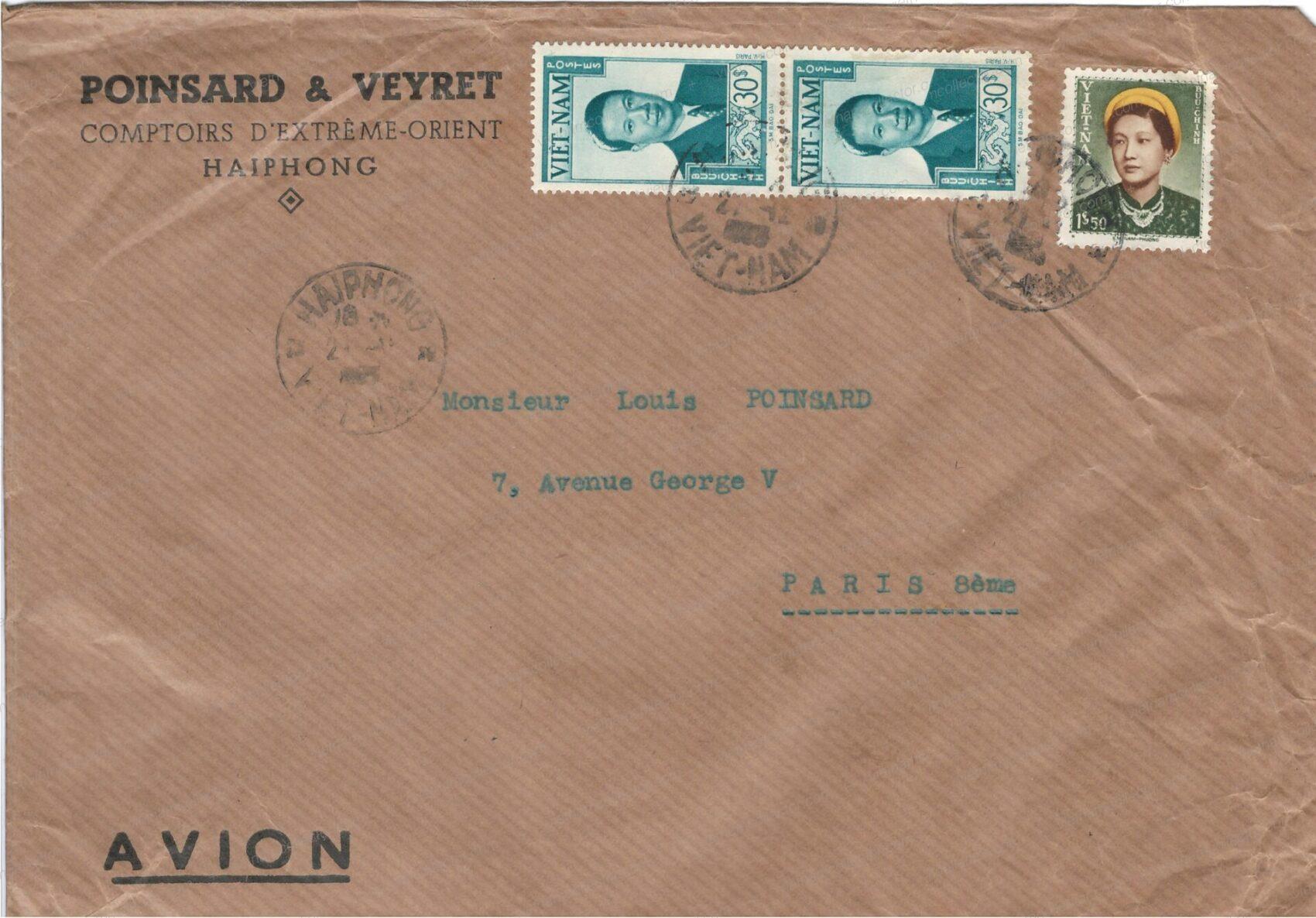
Mixed franking of the 30D Bảo Đại stamp (2) together with the 4P Air Mail stamp paying an overall postage of 64P on an international air mail letter sent from Hai Phong to France.
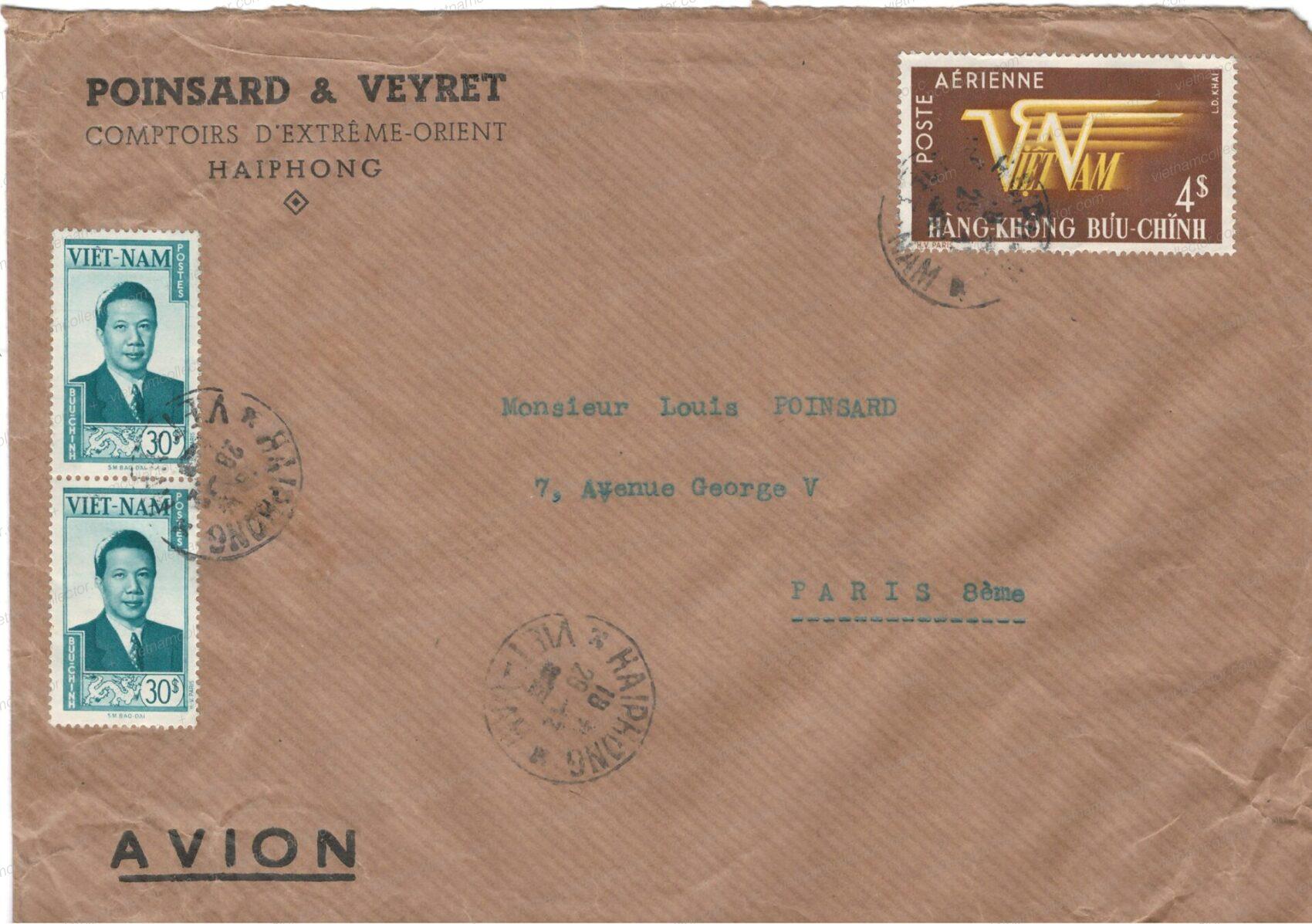
Mixed franking of the 30D Bảo Đại stamp (3) together with the 3P Bảo Đại stamp (3) and one 15P Landscape stamp paying an overall postage of 114P on a large commercial air mail envelope mailed in February of 1954 from Hai Phong to France.
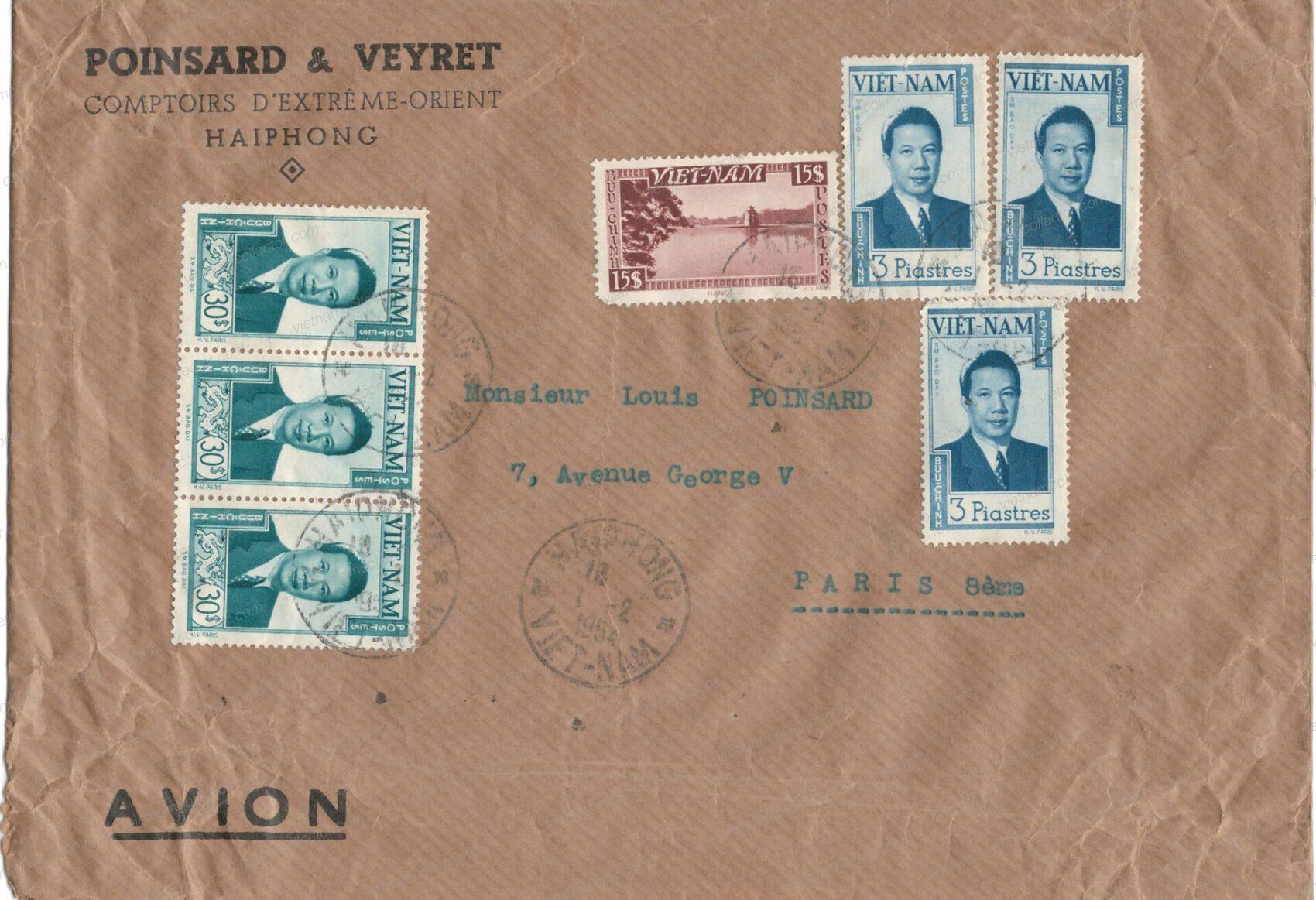
Registration Nr. 200000

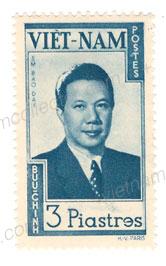
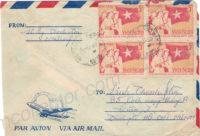
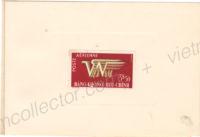
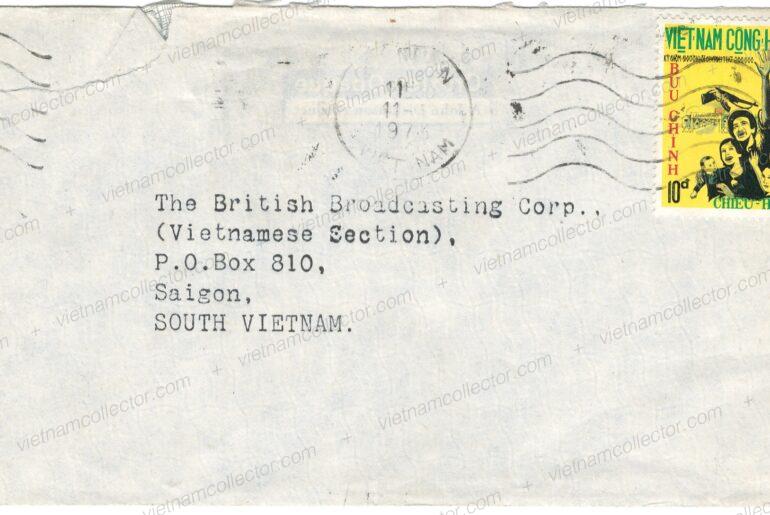
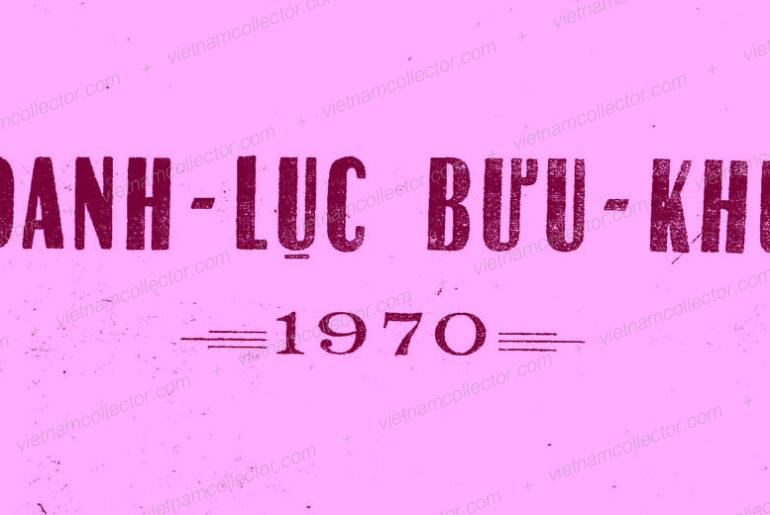
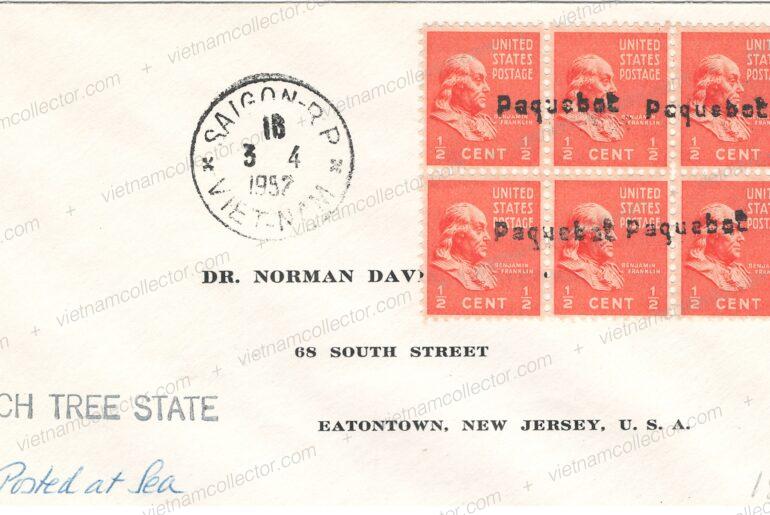
Comments are closed.